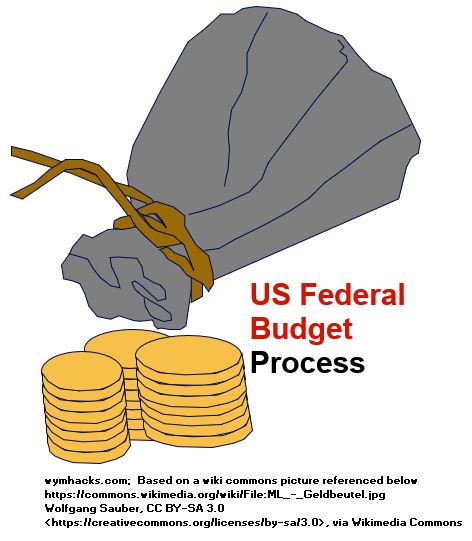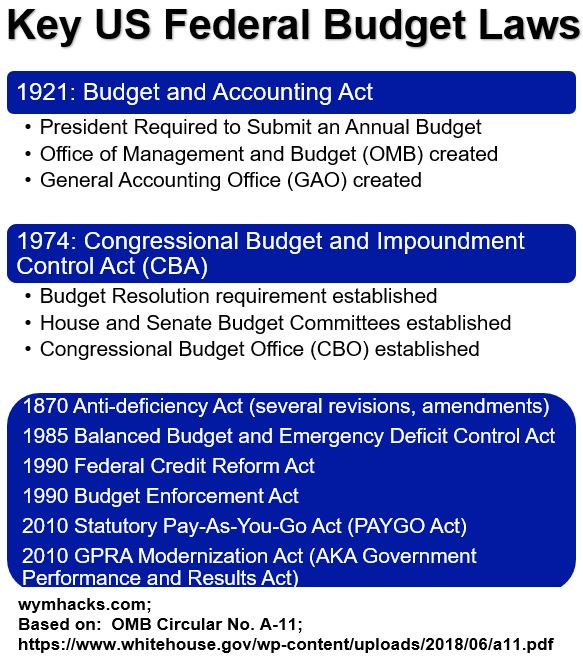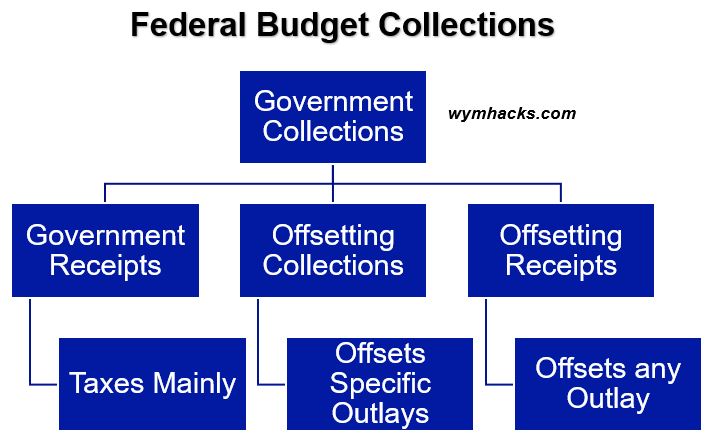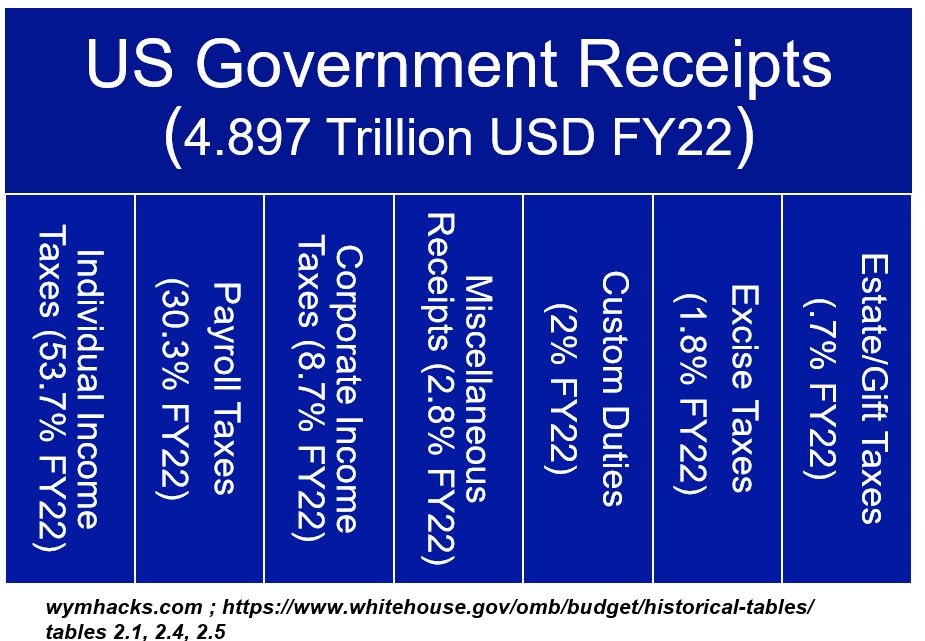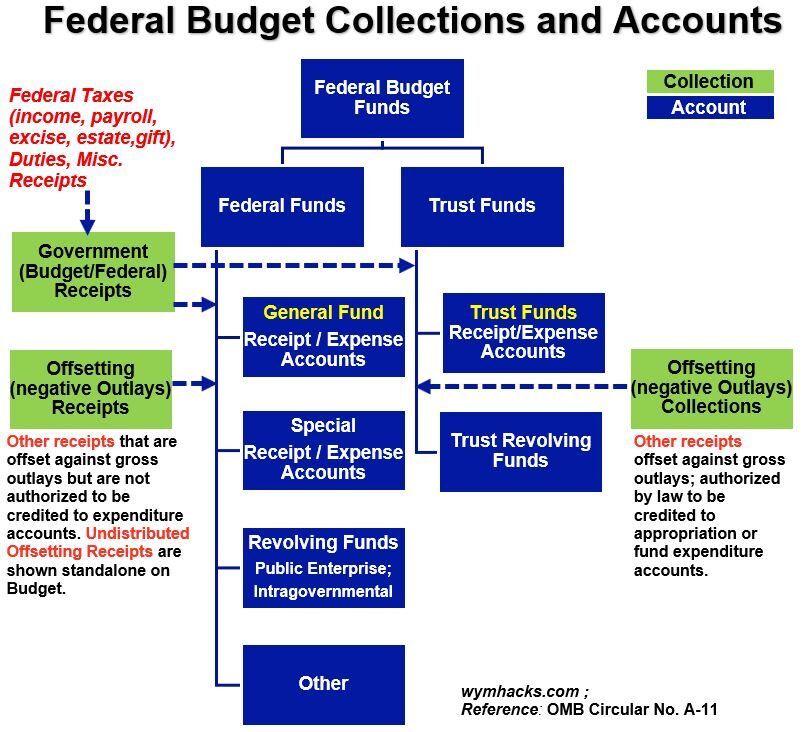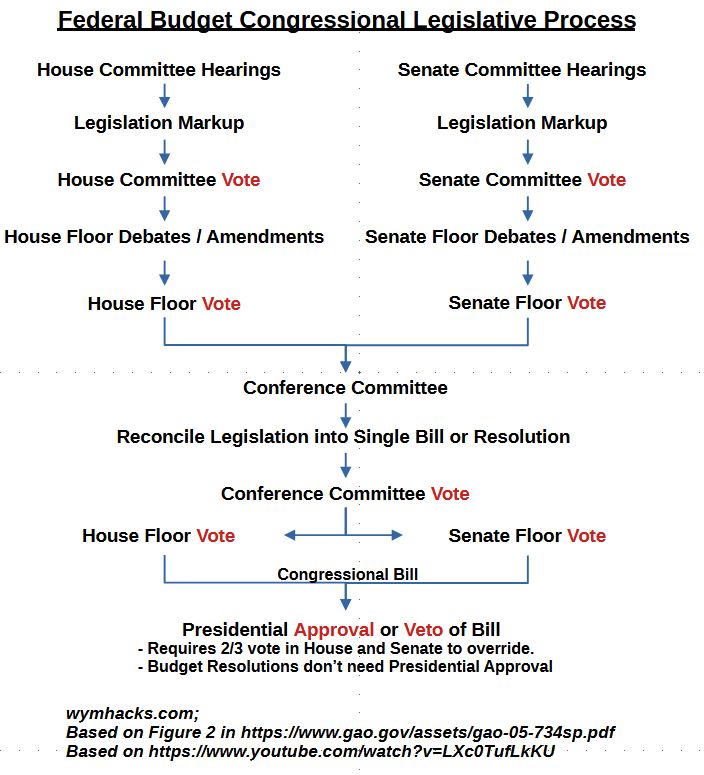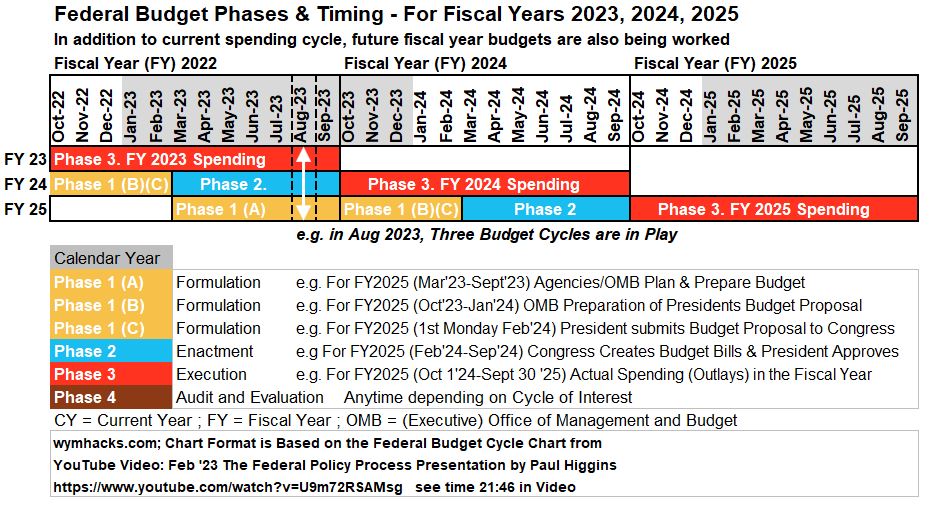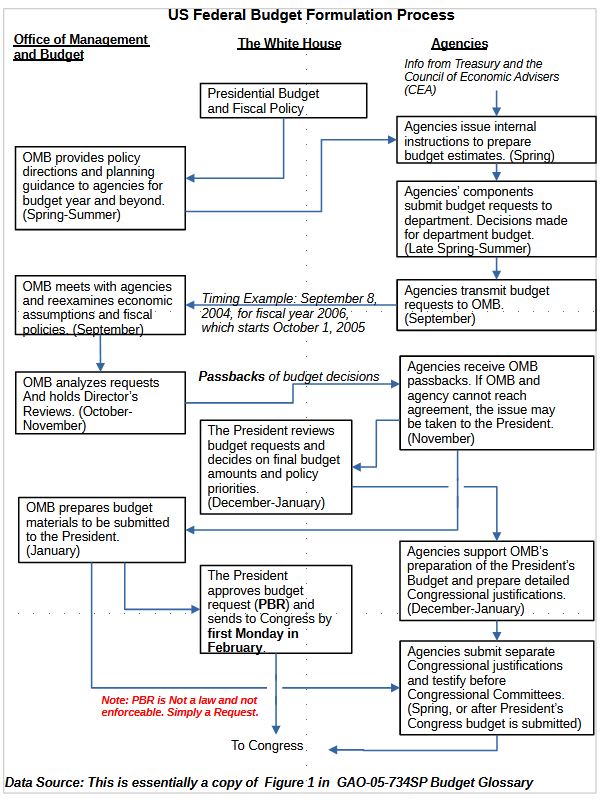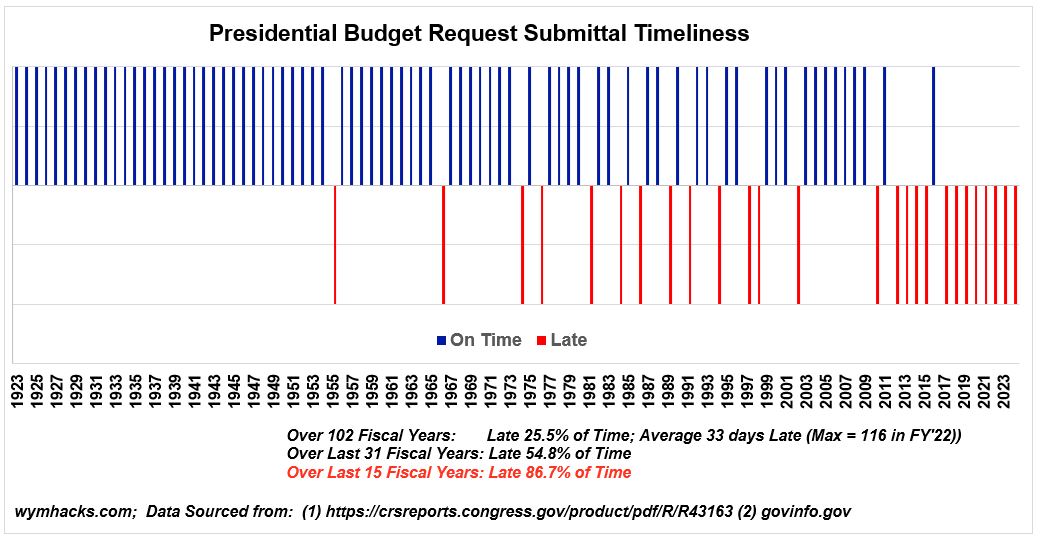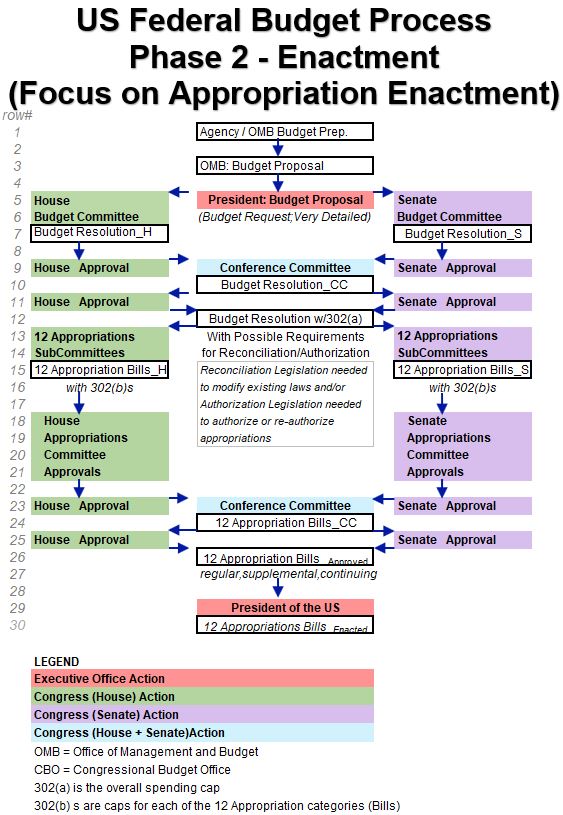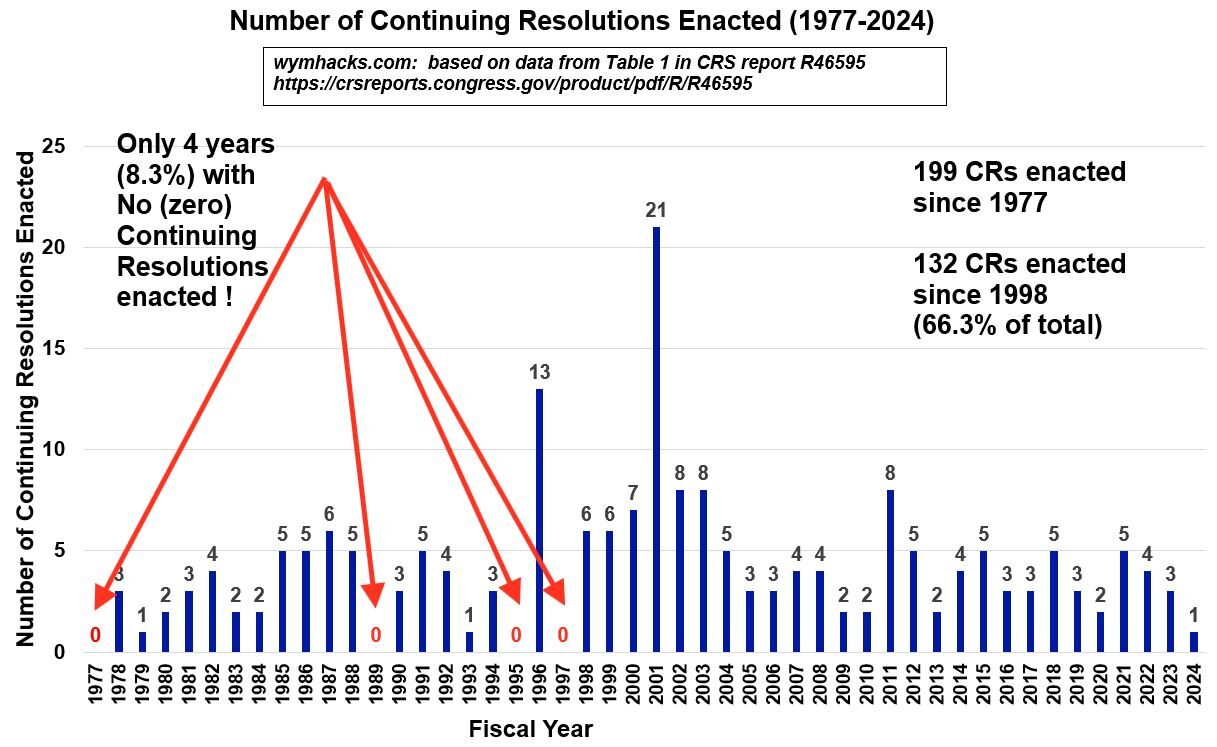Menu (linked Index)
The US Federal Budget Process (Last Update: February 12,2024)
If you want to take a look at a detailed breakdown of an actual completed budget, check out my article: The US Federal Budget – Part 2 – FY2022 Analysis.
Schematic 1.1 US Federal Budget Flow
![]()
- Introduction
- US Federal Budget Basics
- Key References, Laws, Terminology
- Budget Collections and Accounts (Using Example FY2022 Receipts)
- Controlling Laws and Spending Categories (Using Example FY2022 Outlays)
- Budget Process Participants
- Legislative Process
- US Federal Budget Phases (Overview)
- US Federal Budget Cycles/Timing
- Budget Process Phase 1 (Formulation)
- Budget Process Phase 2 (Enactment)
- Conclusion
- Appendix 1 – Reference Links and Glossary
- Appendix 2 – Congressional Committees
- Appendix 3 – Federal Government Agencies and Departments
- Appendix 4 – Federal Government Budget Functions
- Appendix 5 – House and Senate Voting Rules
- Appendix 6 – Federal Budget Process Performance
Federal Budget Process – Introduction
Many of you have and manage a budget i.e. a system of tracking the cash you bring in and the cash you spend.
A Budget (a way to track income and expenses) allows us to monitor and adjust our saving and spending behavior.
For the same reasons, the US Federal Government needs a system to manage its budget. It does this through an annual negotiation between the Executive Branch (The President) and the Legislative Branch (Congress) called the “US Federal Budget Process”. The required “products” of this process are legislative bills (laws) that influence and dictate practically all aspects of how the Government receives and spends money.
The purpose of this article is to:
- present and explain the relevant laws, organizations, terms and concepts that will aid in better understanding the Federal Budget Process.
- explain in detail the two “creative” phases of the Budget Process (Formulation and Enactment).
- present (assess) the historical performance of these two phases.
- give you a better appreciation of the complexities and challenges that our political leaders face when undergoing this annual exercise.
This article focuses on the budget process. If you want to take a look at a detailed breakdown of an actual completed budget, check out my article: The US Federal Budget – Part 2 – FY2022 Analysis.
Article Organization
The best way to read this article is from the top down. You can review the layout of the article from the linked index and go directly to the section you might be interested in, but, starting from the beginning and sequentially working through the topics is the way this article was designed to be read. The main topics covered are:
- Basic definitions of Budget, Receipt, Outlay, and Deficit
- The laws creating/defining the Budget Process and the key organizations that support it
- Government Collection and Accounts terminology (Receipts, General Funds and Trust Funds)
- Authorizing and Appropriations Laws and spending categories (Mandatory and Discretionary Outlays, and Business Functions)
- Budget Process Participants (OMB, CBO, GAO, Agencies, Congressional Committees etc.)
- A description of the legislative process (how Congress passes laws)
- A general overview of the Annual Budget Process
- Budget Process cycle timing (3 different budgets in different phases are occurring at any given time)
- Annual Budget Process details – Phase 1 – Formulation
- Annual Budget Process details – Phase 2 – Enactment
- Historical Performance of the Budget Process and General Observations / Recommendations.
The Appendices Are Full of Good Information
I’ve provided lots of informative (hyper-linked) references throughout the article, so don’t hesitate to check those out for more information (and access to budget data).
- You can utilize the big glossary in Appendix 1 if you need to clear on definitions.
- Refer to the other appendices at the end of this article to learn more about congressional committees (Appendix 2), agencies and departments (Appendix 3), Budget Functions (Appendix 4), legislative voting rules (Appendix 5), and a historical performance assessment of the Budget Process (Appendix 6).
As you read through the article please note that
(1) Unless specifically noted, “Government” refers to the US Federal Government.
(2) FY stands for Fiscal Year. e.g. FY2022 means Fiscal Year 2022 which ran from October 1, 2021 to September 30, 2022.
(3) Assume Budget Resolution and Concurrent Budget Resolution are synonymous.
Let’s jump in.
Budget Basics
A simple equation describing a budget is
- Budget = Receipts (incoming cash like taxes) – Outlays (expenditures like Department of Defense spending)
Schematic 3.1 shows a more complete high level view of the Federal Budget Process.
Schematic 3.1 – US Federal Budget: Receipts – Outlays = (+)Surplus or (-) Deficit
The US Federal Budget cash inflows (Receipts) and cash outflows (Outlays) will cause three possible scenarios:
- A “perfect balance” where Receipts = Outlays (this has never happened)
- A “surplus” where Receipts exceed Outlays. Since 1990, it has happened 4 times i.e. 12% of the time! (*)
- A “deficit” where Outlays exceed Receipts. Since 1990, it has happened 29 times i.e. 88% of the time! (*)
(*) See Table 1.1 at https://www.whitehouse.gov/omb/budget/historical-tables/
In Schematic 3.1, the black double arrow shows that if there is a “surplus”, then cash flows out of the system in the sense that it’s available to save or spend somewhere else. Since 1990, there have been only 4 years in which there has been a Government budget surplus.
If the US spends more than what it brings in, then this triggers “deficit spending“.
Deficit spending means the Government borrows money to make up the amount that has been overspent.
It does this by selling Government securities (i.e. bonds) to anyone (mostly) who wants to buy them (which turns out to be the whole world).
You can’t borrow money for free, so there are interest payments the Government must make each year (which become part of the outlays).
What laws govern the US Federal Budget Process? Read on.
Key References and Laws
In this section we’ll review
- useful references that you can refer to for further study.
- the key laws that established and govern the current US Federal Budget Process.
Useful References
The three main Government documents I have extensively used are
- CRS: Introduction to the Federal Budget Process R46240,
- GAO: A Glossary of Terms Used in the Federal Budget Process 05734SP
- OMB: Circular No. A-11 Preparation, Submission, and Execution of the Budget
Other excellent resources:
- CRS: Congressional Research Service
- CBO: Congressional Budget Office
- OMB: Office of Management and Budget
- GAO: Government Accountability Office
- Govinfo.gov Budget Information
- PGPF: Peter G Peterson Foundation
- CBPP: Center on Budget and Policy Priorities
- CRFB: Committee for a Responsible Federal Budget
Key Laws Governing the US Federal Budget Process
Schematic 4.1 lists the key laws driving the US Federal Budget Process. We’ll focus on the big two: The 1921 Budget and Accounting Act and the 1974 Congressional Budget and Impoundment Control Act (we’ll refer to this as the CBA).
Schematic 4.1 – Key US Federal Budget Laws
The Budget and Accounting Act of 1921
The Budget and Accounting Act of 1921
- requires the President to Submit an Annual Budget.
- created the Office of Management and Budget (OMB).
- created the US Government Accountability Office (GAO).
The GAO, “…provides Congress, the heads of executive agencies, and the public with timely, fact-based, non-partisan information that can be used to improve Government and save taxpayers billions of dollars…work is done at the request of congressional committees or subcommittees or is statutorily required by public laws or committee reports, per our Congressional Protocols.”
The OMB‘s “…mission is to assist the President in meeting policy, budget, management, and regulatory objectives and to fulfill the agency’s statutory responsibilities”.
It plays a critical role in the Formulation Phase of the US Government Budget Process.
We’ll cover this in more detail later in this article but the three phases of the Government’s annual Federal Budget Process are Presidential Formulation, Congressional Enactment, and Agency Execution.
The Congressional Budget and Impoundment Control Act of 1974
The Congressional Budget Act (CBA) of 1974, established and provides the framework for the Federal Budget Process we “follow” today.
- The CBA requires a Budget Resolution to be passed each year.
- It created the CBO (Congressional Budget Office).
- It created the House and Senate Budget Committees.
Interesting history: It appears that Congress mainly enacted the CBA to limit the President’s (Nixon at the time) power of impoundment (i.e. withholding or impounding funds appropriated by Congress).
The CBO, Congressional Budget Office “… has produced independent analyses of budgetary and economic issues to support the Congressional budget process. Each year, the agency’s economists and budget analysts produce dozens of reports and hundreds of cost estimates for proposed legislation.”
Both the House and Senate Budget Committees are integral participants in the annual Federal Budget Process. They (source: Senate.gov)
- develop Budget Resolutions which are frameworks for “congressional action on spending, revenue, and debt-limit legislation”
- enforce Budget Resolutions and associated laws and ensure spending level limits are met.
- “initiate and enforce the budget reconciliation process, a piece of legislation that is written to bring about specific identified fiscal goals.”
Summary of Key References and Laws Section
The two main laws that established the US Government Federal Budget Process are:
- The Budget and Accounting Act of 1921 (created OMB and GAO and requires an annual Presidential Budget Request)
- The Congressional Budget and Impoundment Control Act of 1974 (created CBO and Budget Committees and requires a yearly Budget Resolution.
Two excellent Government documents describing the Federal Budget Process are:
Budget Collections and Accounts
Let’s touch on some common Federal Budget terms referring to the Collection of money and money Accounts (Funds). Refer to these useful Government documents if you need more detail:
Collections refer to the money that the US Government receives from one of three sources:
- Government Receipts
- Offsetting Collections
- Offsetting Receipts
Schematic 5.1 – Federal Budget Collections
Governmental receipts result from the “exercise of the Government’s sovereign powers” i.e. power to take your money via taxes mainly.
Check out Schematic 5.2 below for a breakdown of Government receipts and what they looked like for the Fiscal Year 2022 Federal Budget. They are listed below by order of magnitude.
- Individual Income Taxes (53.7% of total receipts of 4.897 Trillion USD)
- Payroll Taxes (30.3%)
- Corporate Income Taxes (8.7%)
- Miscellaneous Receipts (2.8%; e.g. regulatory fees, court fines, certain license fees, Federal Reserve earnings deposits etc. )
- Custom Duties (2%)
- Excise Taxes (1.8%)
- Estate/Gift Taxes (.7% of total receipts of 4.897 Trillion USD)
By the way, a trillion is 1000 billion or 1,000,000,000,000 (a 1 with 12 zeros behind it). It’s a really big number. (see my article on big numbers).
Schematic 5.2 – US Federal Government Receipt Breakdown for FY2022
Offsetting Receipts and Collections are additional funds collected that are recorded as negative spend (outlays). That is, they are recorded on the outlay side of the ledger and basically reduce or “offset” the outlay (like a credit would on your credit card balance). Offset examples might be benefit premiums, proceeds from Government sales, rents and royalties, interest income, postage stamp sales, etc. The term collection means the offset is dedicated to a specific program/account whereas a receipt means the offset is not credited to any specific account.
So, the Government collects and generates monies from various sources/methods and these are disbursed to various Budget Funds. Budget Funds are the receipt and expense accounts that Government agencies manage their budgets through. Budget Funds can be further broken down into two main group of funds:
- Federal Funds
- Trust Funds
Trust Funds are established by laws and are associated with programs that receive dedicated funds. The big social insurance programs like Social Security and Medicare have dedicated Trust Funds.
Federal Funds are basically everything else that is not a Trust Fund. The biggest type of Federal Fund will be the General Fund.
Schematic 5.3 shows the Collection categories (in Green) and how they related to the Budget Funds (Blue).
Schematic 5.3 Federal Budget Collections and Accounts
There are different types of Federal Funds:
- General Accounts have collections not earmarked by law for a specific purpose.
- Special Accounts have collections earmarked by law for a specific purpose. They are similar to Trust Funds.
- Revolving Funds are sources of financing that are replenished through the collection of fees or charges for goods/services provided by the Government.
Trust Funds are also broken down into two types: Trust Funds and Trust Revolving funds.
- According to Whitehouse.gov Circular No. A-11, “Revolving fund means a fund that conducts continuing cycles of business-like activity, in which the fund charges for the sale of products or services and uses the proceeds to finance its spending, usually without requirement for annual appropriations.
- …There are three types of revolving funds: Public enterprise funds, which conduct business-like operations mainly with the public, intragovernmental revolving funds, which conduct business-like operations mainly within and between Government agencies, and trust revolving funds, which conduct business-like operations mainly with the public and are designated by law as a trust fund.”
Summary of Budget Collection and Accounts Section
We now know that
- various collections (monies) enter the Federal Budget system.
- the collections mostly comprise Government Receipts (mostly Taxes) but also include Offsetting monies (Receipts or Collections) that are entered as credits or offsets against expenditures (outlays).
- modern Government Receipt totals are massive (e.g. $4.897 Trillion in FY2022) ,but we’ll see in the next section that it’s not big enough to cover expenditures.
- the collections go to either Federal or Trust Accounts.
- the General Fund (a Federal type of Fund) and Trust Funds are the two big types of Funds.
- trust Funds are dedicated funds. The big entitlement programs (like Social Security, Medicare, etc.) use Trust Funds.
Controlling Laws and Spending Categories
Appropriation and Budget Authority
In Article 1, Section 9, Clause 7, the US Constitution states that “No Money shall be drawn from the Treasury, but in Consequence of Appropriations made by Law; and a regular Statement and Account of the Receipts and Expenditures of all public Money shall be published from time to time.”
The Legislative (law making) Branch of Government, i.e. Congress, therefore controls how money is spent ; It has the “power of the purse“.
The term “appropriation”, in the context of budgeting, generally means: “the setting aside of money for a specific purpose”. In the Federal Budget Process, when Congress enacts an Appropriation, it is giving Budget Authority to various agencies and departments to fund programs.
So, Budget Authority is essentially legal permission to finance federal programs and activities. According to OMB Circular A-11 “Budget authority…means the authority provided by law to incur financial obligations that will result in outlays.”
According to the Congressional Budget Act, there are different types of Budget Authority :
- Budget Authority (in a more specific sense): Provisions of law that make funds available for obligation and expenditure (other than borrowing authority), including the authority to obligate and expend the proceeds of offsetting receipts and collections. Note: Entitlement Authority is Budget Authority for Entitlement programs as provided in an Authorization (Authorizing) Law.
- Borrowing Authority: Authority granted to a Federal entity to borrow and obligate and expend the borrowed funds
- Contract Authority: The making of funds available for obligation but not for expenditure
- Negative Budget Authority: Offsetting receipts and collections as negative budget authority, and the reduction thereof as positive budget authority.
Budget Authority is typically related to Obligations and Outlays in a sequential way (See Schematic 6.1).
Schematic 6.1 – Stages of Federal Spending (Budget Authority → Obligation → Outlay)
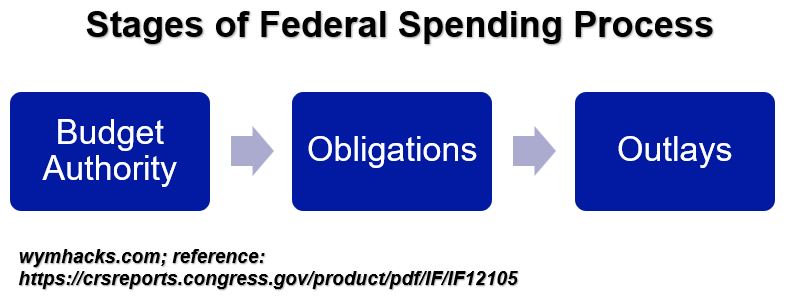
- Budget Authority refers to the amount available to a spending agent for a specific purpose. They are the funds provided.
- Obligation refers to a spending committment. The spending agency incurs a legal binding committment (obligation).
- Outlay refers to the actual funds used (the transfer of funds to meet the agency’s obligations).
Authorizing Laws and Appropriations Laws
There are two types of laws or statues that can create and fund Federal spending programs. Almost always, Appropriations Laws require a governing Authorization Law (AKA Authorizing Law). Authorizing Laws, on the other hand, do not always require Appropriations Laws.
- Authorizing Laws (Authorization Laws or Bills) – These create, provide structure, and justify programs and (typically) provide guidelines on money that may be spent. They can sometimes contain Appropriation instructions within them. They are permanent in the sense they do not have to be updated/reviewed/created on a periodic basis.
- Appropriation Laws (Bills) – These laws typically fund an authorized program and typically are enacted on a yearly basis.
Department of Defense spending programs, for example, are appropriated each year through Appropriation laws and have associated Authorizing Laws.
On the other hand, Social Security programs are dictated by Authorizing Laws alone.
Now, let’s review three major categories of Government spending: Discretionary Spending, Mandatory Spending, and Net Interest Payments.
Spending (Expenditure) Categories
The Federal Budget defines three types of outlays (expenditures).
- Mandatory Spending – Expenses that are not Discretionary expenses. They are Mandated by permanent Authorizing Laws and don’t require annual appropriation (i.e. Appropriation Laws)… except for Appropriated Entitlements which are described later).
- Discretionary Spending – Expenses that are subject to annual (or other defined period) appropriation (i.e. require an Appropriation Law to be passed).
- Net Interest – Interest paid on Government debt, minus the portion of that interest that is received by trust funds and the net amount of other interest and investment income received by the Government. The OMB categorizes this as a Mandatory expense but the CBO does not. We’ll keep it separate and go with the CBO approach.
Schematic 6.2 – Government Expenditure Types
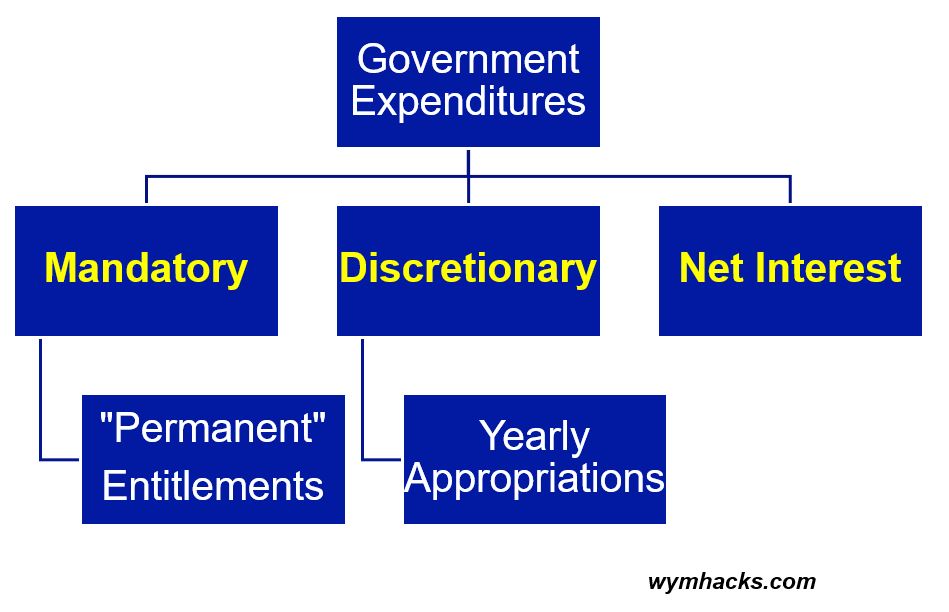
Discretionary Spending
The annual Federal Budget Process mostly involves Discretionary Spending which is determined at the “discretion of Congress” on a yearly (typically) basis. It involves appropriations or amounts of money that Congress allocates to federal agencies and programs for a specific fiscal year (or other defined duration).
- Discretionary expenditures are the yearly Federal department and agency outlays that are appropriated by Congress on an Annual Basis (through the Federal Budget Process).
- Typically, most of the effort around the yearly Federal Budget Process pertains to Discretionary Spending.
- The biggest portion (about 45% in FY2022) of Federal Discretionary Spending is dedicated to the Department of Defense. For this reason, Discretionary Spending is often categorized as Defense and Non-Defense (Discretionary) Spending.
- In FY2022, about 26.5% of total outlays were Discretionary! Wow, this is a minority fraction of the total spend. Hold onto this thought as you continue reading.
- According to CRS – R46240 : “The Balanced Budget and Emergency Deficit Control Act of 1985, as amended, defines Discretionary Spending as budget authority provided in annual appropriation acts and the outlays derived from that authority. Discretionary Spending encompasses appropriations not mandated by existing law and therefore made available in appropriation acts in such amounts as Congress chooses.”
Mandatory Spending
Mandatory Spending means spending controlled by laws other than appropriations acts (including spending for entitlement programs) and spending for the Supplemental Nutrition Assistance Program.
- Mandatory Spending , also called Direct Spending, is directly mandated by law (i.e. via Authorizing Laws) and does not require annual appropriations from Congress. Although the primary purpose of the Annual Federal Budget is to approve Discretionary appropriations, it can also change or add laws affecting Mandatory Spending (through generation of Authorizing Bills or Reconciliation Bills which we’ll address later).
- Mandatory Spending outlays continue from year to year until/unless they are changed. So, spending doesn’t have to be authorized each year and depends on the number of qualified people who receive those benefits. Social Security and Health Care Entitlement Programs (i.e. qualified people are entitled to the benefit) belong to this category.
- About 73.5% of the 2022 budget was Mandatory Spending (including Net Interest; 65.9% not including Net Interest ). Realize that this is a big chunk of the total budget process that might not necessary be part of the annual Federal Budget Process. The CBO considers Net Interest owed (on Treasury Bonds issued to cover the deficits) to be a separate spending category whereas the OMB considers it part of Mandatory Spending.
Mandatory Spending – Entitlement Programs
We’ve mentioned Entitlement Programs a few times in this section. Entitlement Programs are a kind of Mandatory Spending program.
According to Circular A-11, “Entitlement refers to a program in which the federal government is legally obligated to make payments or provide aid to any person who, or State or local government that, meets the legal criteria for eligibility. Entitlements are generally provided by an authorizing statute, and can include loan and grant programs.
Examples include benefit payments for Social Security, Medicare, Medicaid, and Unemployment Insurance, as well as grants to States for the Children’s Health Insurance Program (CHIP) and Temporary Assistance for Needy Families (TANF). Some programs, such as Veteran’s Compensation, Medicaid, Supplemental Security Income (SSI), and Child Nutrition, are entitlements even though they are funded by appropriations acts because the authorizing statutes for the programs unconditionally obligate the United States to make payments. These are referred to as Appropriated Entitlements.”
Outlay (Expenditure) Organization
- Total Outlays
- Discretionary/Mandatory/Net Interest (the OMB tends to include Net Interest as part of Mandatory; I’d keep it separate)
- Discretionary spending can be broken down into Defense/Non-Defense.
- The CBO breaks Mandatory spending into Social Security, Medicare, Medicaid, Income Security, Federal civil and military retirement, Veterans Programs, Other Programs and Offsetting Receipts.
If we wanted a longer expense list, we could break down expenses by department or agency or by specific program. These lists will be long (100s of items). We’ll come back to departments and agencies in the following section on “Budget Participants”.
Budget Functions are another way the Government likes to break down expenses.
Budget Functions
The Government likes to display expenses by Budget Function which classify federal budgetary activities into functional categories and subcategories. Based on OMB definitions, the Budget is organized into superfunctions (total of 6), functions (total of 20), and subfunctions (total of 80) (See Appendix 1 under “Function Classifications” or Appendix 4 for more details).
For example, the “Income Security” Function , under the Super-Function “Human Resources”, has 6 Sub-Functions:
Human Resources/600 Income Security
601 General retirement and disability insurance (excluding social security)
602 Federal employee retirement and disability
603 Unemployment compensation
604 Housing assistance
605 Food and nutrition assistance
609 Other income security
In Schematic 5.2 we showed that FY2022 Receipts totaled $4.897 Trillion. What does the other side of the ledger look like for FY2022?
Schematic 6.3 below shows FY2022 outlays (expenses) by Budget Function in Millions of dollars (total = $ 6.273 Trillion). Entitlement Programs like Social Security, Medicaid and Medicare are all huge expenses but , man, there are a lot of huge expenses. If you want to see the data table I used to construct the table below, find Table 24-1 at www.govinfo.gov 2024 budget.
Schematic 6.3 – Fiscal 2022 Federal Budget Outlays by Budget Function
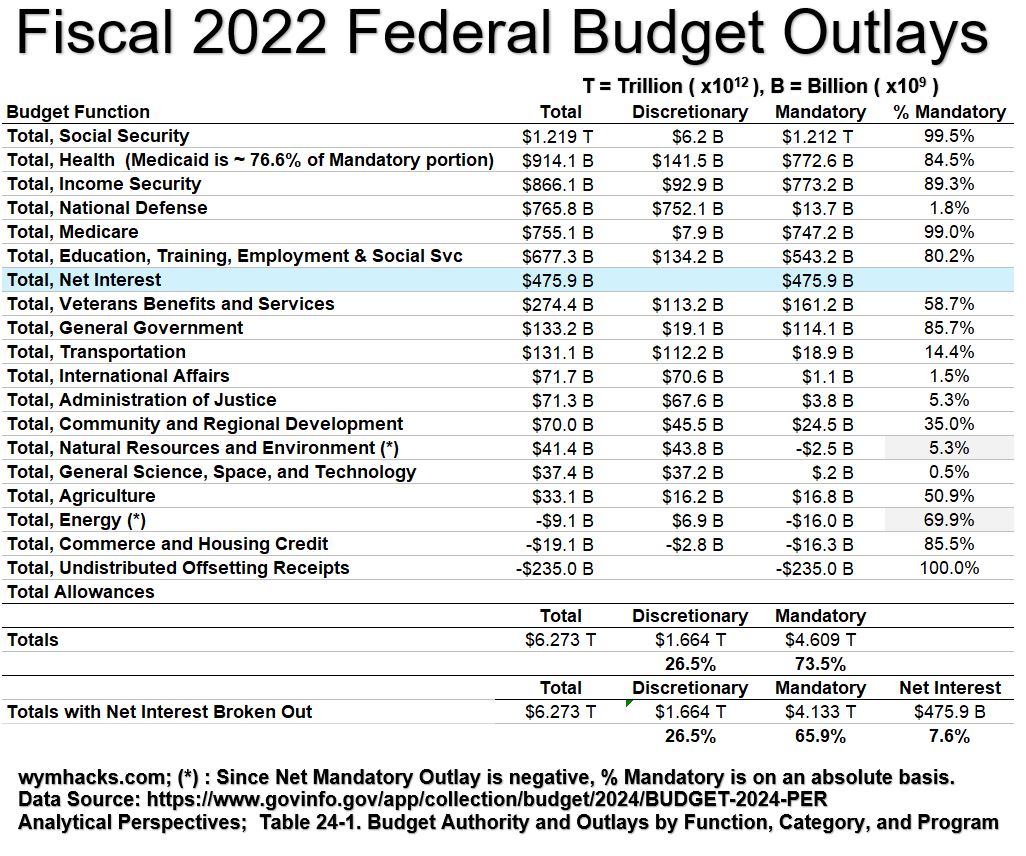
In FY2022, the Government taxed you to the tune of $4.897 Trillion and then spent all of that, and then borrowed an additional $1.376 Trillion, which it also spent (for a total of $6.273 Trillion spent).
So, we ran a $1.376 Trillion Dollar deficit in FY2022. As you look at some of these Function costs from the table above (like General Government or International Affairs etc.) are you at least curious to understand why the numbers are so huge? You should since (1) you are paying for it and (2) the government keeps on borrowing more and paying more in interest (you’re paying for this too).
Schematic 6.4 – Overall FY2022 Receipt/Outlay/Deficit
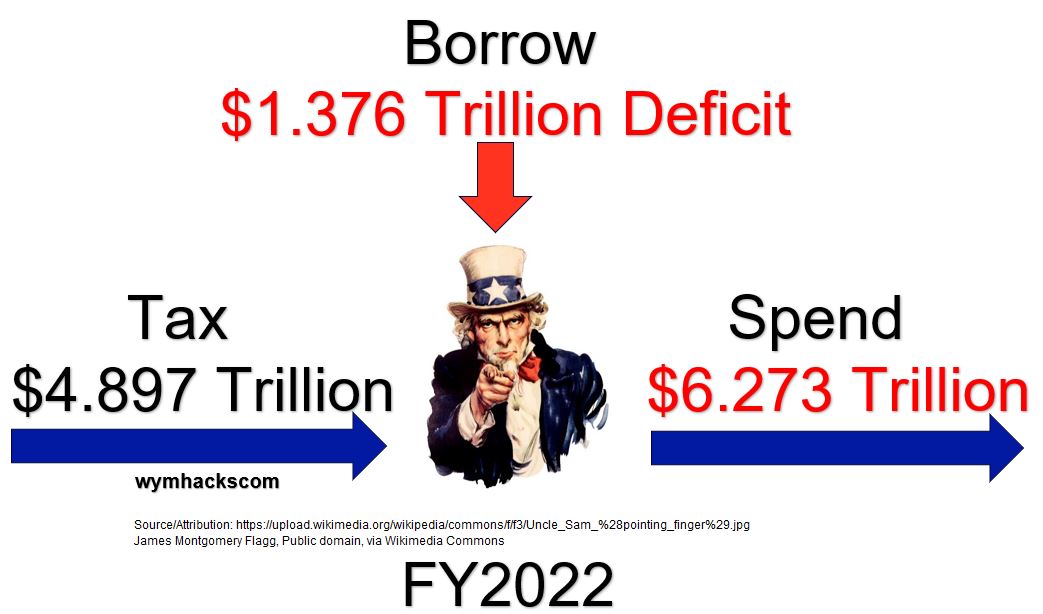
Has it been normal for the Government to run a deficit? Answer: Yes.
Schematic 6.5 shows the years (since 1901) in which the US ran a deficit versus a surplus. Most of the green (surplus) and red (deficit) lines extend beyond the scale of this chart, so use it just to get a qualitative sense of how often the government runs a deficit. Over 122 years, the US Government ran a deficit 89 times (73% of the time).
Schematic 6.5 – 1901 – 2022 Yearly US Budget Surplus/Deficit
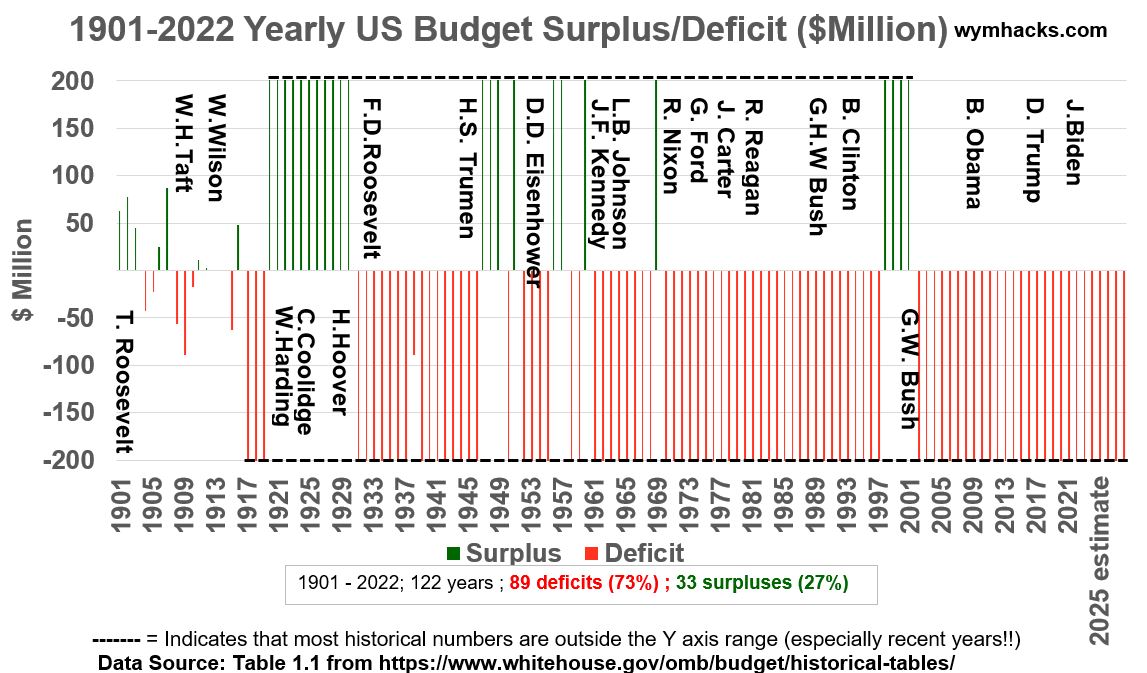
Schematic 6.6 shows the yearly trend in surpluses/deficits since 1990. The Government ran deficits in 29 of the last 33 years! That’s 88% of the time. Congratulations President Clinton. Under your tenure, the Government ran a surplus for four (almost 5) straight years.
Schematic 6.6 – 1990 – 2022 Yearly US Budget Surplus/Deficit ($Trillion)
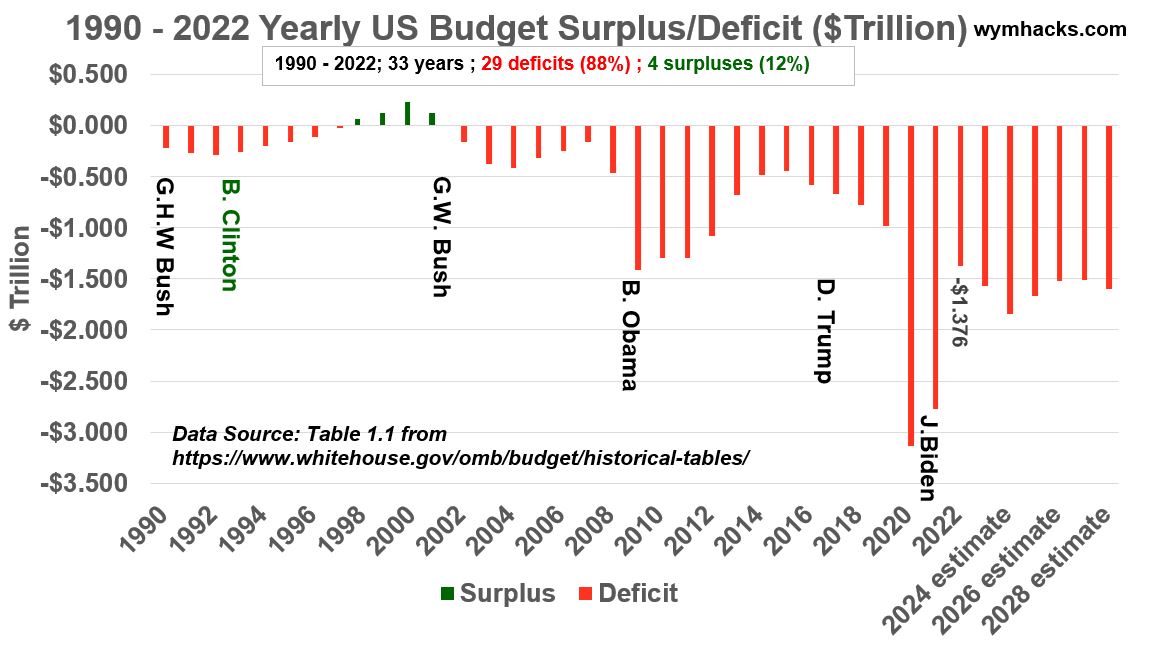
The Government Public Debt (the total cumulative debt) grows with each yearly deficit. Sometimes it’s more useful to look at relative numbers versus absolute numbers.
Schematic 6.7 shows a historical chart of US Public Debt/GDP which tells you how much the country owes relative to its economic production. During World War 2, the ratio got to about 100%. At the end of fiscal year 2022, the ratio was 97%. If nothing changes going forward, the CBO predicts the ratio will accelerate into unchartered territory. It’s difficult to identify what is too high, but everyone realizes we are entering an acceleration phase of increasing debt that will probably be very dangerous for the country.
Schematic 6.7 – Historical US Public Debt/GDP Ratio – Actual vs Projects (by CBO)
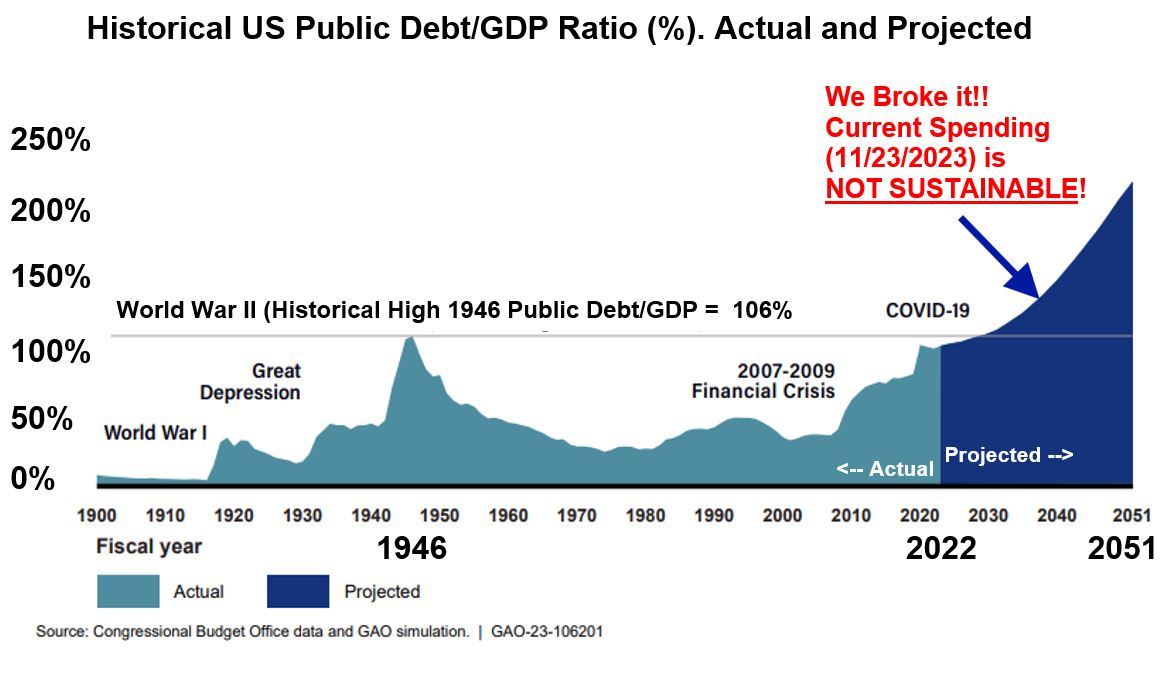
The Government knows it cannot sustain this overspending behavior shown so starkly in Schematics 6.6 and 6.7. The GAO, CBO, Social Security and Medicare Trustees, and economists on the left and right have been telling Congress and the President this for several years. This needs a dedicated article to properly address, but the main causes of unsustainable spending are:
- Demographics: The last of the 73 million Baby Boomers will reach full retirement age by 2031 (i.e. will retire into Social Security and Medicare benefits). The ratio of workers paying taxes to retirees is shrinking going from 5/1 in the 1960s to 2/1 in the next decade or so (see podcast with Brian Riedl ).
- People are living longer. When the Social Security Laws were enacted life expectancy was about 65 years (its much higher today).
- Related to the above, health costs are growing much higher than GDP growth.
- Interest on Debt grows exponentially.
- Other reasons I have heard and read about but don’t necessarily agree with are: taxes too low, social benefits are too generous, too many “pork” programs, too much spending on the military, too much foreign aid etc.
Almost all experts agree that sooner than later, the Government will need to tax more and spend less.
Relationship of Authorizing Laws, Appropriation Laws and Spending Types
Schematic 6.8 below shows the relationship between budgetary laws and types of spending. Here are the key points to remember:
- Federal Budget spending is typically described as either Discretionary or Mandatory.
- Discretionary Spending amounts are (typically) defined and approved on a yearly basis via Appropriation Laws.
- Appropriations Laws are normally associated with Authorization (Authorizing) laws which create and define the programs.
- Appropriation Laws almost always require Authorizing Laws but the opposite is not true i.e. Authorizing Laws sometimes do not require Appropriation Laws.
- Mandatory Spending programs are fully defined and controlled by Authorization (Authorizing) laws and are typically not associated with Appropriation Laws. All programs that are not Discretionary are Mandatory. They are permanent unless changed.
- The biggest Mandatory programs like Social Security are called Entitlement Programs because anyone eligible is entitled to the benefit.
- Mandatory Spending programs that are Appropriated Entitlements are an exception to the previous bullet and do require annual appropriation laws.
Schematic 6.8 – Legislative Laws and Spending Definitions
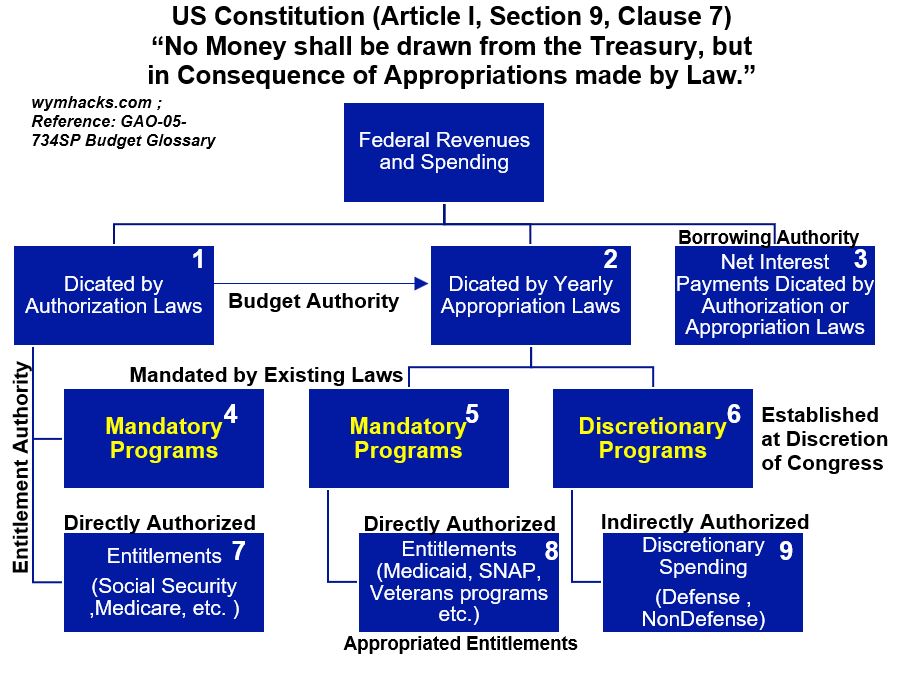
Summary
Our foundation is coming along nicely. We now know a little bit about:
- Authorizing Laws (program creation) and Appropriation (program spending) Laws.
- Mandatory (permanent by law) and Discretionary (annually appropriated) spending.
- Budget Functions which organize outlays into 20 categories.
- Historical deficits and surpluses; Debt/GDP is becoming unsustainable.
In the next section we’ll describe some of the key participants in the Federal Budget Process.
Federal Budget Process Participants
Treasury
Per treasury.gov, “The Treasury Department is the executive agency responsible for promoting economic prosperity and ensuring the financial security of the United States. The Department is responsible for a wide range of activities such as advising the President on economic and financial issues, encouraging sustainable economic growth, and fostering improved governance in financial institutions.”
During the Budget Formulation Phase of the Federal Budget Process, federal agencies receive revenue estimates and economic projections from the Department of the Treasury (Treasury), the Council of Economic Advisers (CEA), and OMB.
Council of Economic Advisers (CEA)
According to whitehouse.gov, “The Council of Economic Advisers, an agency within the Executive Office of the President, is charged with providing the President objective economic advice on the formulation of both domestic and international economic policy.” They provide input into the Formulation Phase of the annual Federal Budget Process.
OMB
As noted in a previous section, the OMB‘s “…mission is to assist the President in meeting policy, budget, management, and regulatory objectives and to fulfill the agency’s statutory responsibilities”.
It plays a critical role in the Formulation Phase of the US Government Budget Process where the Executive Office creates and submits a Budget Request (or Proposal) to Congress. It also publishes Circular A-11 , “Preparation, Submission, and Execution of the Budget”, an excellent Federal Budget Process reference.
Agencies and Departments
Agencies are Government organizations (mostly part of the Executive Branch) that fulfill the required functions of Government (i.e. carrying out the laws and policies of the United States Government).
In the Formulation Phase of the Federal Budget Process, 100s of agencies must submit their proposed budgets to the OMB.
I count over 600 different federal agencies from this usa.gov agency index. Also, take a look at Appendix 3 for a listing of FY2022 budget outlays (expenditures) by agency. Notice that the top 10 agencies spend over 90% of the money. (Out of the 600 agencies, 240 were listed by the CBO in their 2022 budget summaries, with 119 being shown as having allocated budgets).
Programs
Each department/agencies might contain several “programs” operating under a dedicated allocation of money. For FY 2022, the OMB lists 563 spending programs/categories (114 offsets, 405 costs, and 43 not budgeted). Here are some of the big cost programs:
- Hospital insurance (HI): $ 339.699 Billion
- Supplementary medical insurance (SMI): $ 439.618 Billion
- Interest paid on Treasury debt securities (gross): $ 495.682 Billion
- Grants to States for Medicaid: $ 591.949 Billion
- Old-age and survivors insurance (OASI): $ 1.069768 Trillion
source: https://www.govinfo.gov/app/collection/budget/2024/BUDGET-2024-PER; Table 24-1. Budget Authority and Outlays by Function, Category, and Program
President
The head of the Executive Branch (President), the Office of Management and Budget (OMB), and numerous agencies are involved in Formulating the Presidential Budget Request. The President must also sign off (or have his/her veto over-ridden) on any Federal Budget Process produced bills (e.g. Authorizing Bills, Appropriations Bills, Reconciliation Bills).
CBO
The CBO, Congressional Budget Office “… has produced independent analyses of budgetary and economic issues to support the Congressional Budget Process. Each year, the agency’s economists and budget analysts produce dozens of reports and hundreds of cost estimates for proposed legislation.”
The CBO is an integral part of the Enactment (or Congressional) Phase of the annual Federal Budget Process. One of the first things to happen during this phase is the CBO’s issuance of their budget Baseline Estimates to Congress. They also give Congress a formal analysis of the submitted Presidential Budget Request.
GAO
As noted previously, the GAO, “…provides Congress, the heads of executive agencies, and the public with timely, fact-based, non-partisan information that can be used to improve Government and save taxpayers billions of dollars…work is done at the request of congressional committees or subcommittees or is statutorily required by public laws or committee reports, per our Congressional Protocols.”
The GAO provides data and is involved in budget related audits. It publishes an excellent document GAO 734sp, “A Glossary of Terms Used in the Federal Budget Process”.
Congress of the United States
The Constitution , particularly article I, section 9, clause 7, empowers Congress with the Power of the Purse i.e. Congress is the designated money appropriator.
In the Enactment Phase of the Federal Budget Process, Congress receives the President’s Budget Request and then creates a Concurrent Budget Resolution and Enacts spending laws for the upcoming fiscal year.
Ref4 (GAO-05-734SP ): “The United States Constitution gives Congress the power to levy taxes, to finance Government operations through appropriations, and to prescribe the conditions governing the use of those appropriations. This power is referred to as the congressional “power of the purse.”
…The power derives from various provisions of the Constitution particularly article I, section 9, clause 7, which provides that: “No money shall be drawn from the Treasury, but in Consequence of Appropriations made by Law; and a regular Statement and Account of the Receipts and Expenditures of all public Money shall be published from time to time.”
…Congress has and continues to implement its power of the purse in two ways: through the enactment of laws that raise revenue and appropriate funds, including annual appropriations acts, and through the enactment of “fiscal statutes” that control and manage federal revenue and appropriations…“
House and Senate Budget Committees
Typically these are the first committees to act during the Congressional Phase (Enactment Phase) of the Federal Budget Process. The Budget Committees are required to create and pass yearly Concurrent Budget Resolutions which set total spending limits (top line 302(a) allocation).
- Ref2 (CBPP): “The House and Senate Budget Committees draft and enforce the congressional budget resolution. Once the Budget Committees pass their budget resolutions, the resolutions go to the House and Senate floors, where they can be amended. The budget resolution for the year is adopted when the House and Senate pass the identical measure, either after negotiating a conference agreement or after one chamber passes the resolution adopted by the other.” The final product is called the Concurrent Budget Resolution.
- The House and Senate Budget Committees can also request and approve Reconciliation Bills which mainly authorize changes in Mandatory Spending and taxes.
House and Senate Authorizing Committees
An Authorizing Committee is a standing congressional committee (see Committee definition in Appendix 1 or detailed listing of committees in Appendix 2) that also serves as an Authorizing Committee.
Authorizing Committees have subject matter expertise over certain agency programs and have the role of authorizing these programs; meaning giving people authority and providing the structure and rules under which those programs operate.
Both Mandatory and Discretionary Spending bills are typically authorized.
- For example, the House and Senate Armed Services Committees would be Authorizing Committees for certain Department of Defense programs.
- Authorizing Committee definition – Ref4 (GAO-05-734SP ): “A standing committee of the House or Senate with legislative jurisdiction over the establishment, continuation, and operations of federal programs or agencies. The jurisdiction of such committees extends, in addition to program legislation, to authorization of appropriations legislation. “
- Authorizing Committee definition – Ref1: (CRS – R46240) : “Legislative committees—such as the House Committee on Armed Services and the Senate Committee on Commerce, Science, and Transportation—are responsible for authorizing legislation related to the agencies and programs under their jurisdiction. Most standing committees have authorizing responsibilities.
House and Senate Appropriations Committees
These congressional committees play a key role in the Enactment Phase of the annual Federal Budget Process. The Senate and the House each have 1 Appropriations Committee and 12 Appropriations Subcommittees (a total of 26 congressional committees not including the joint Conference committees comprised of house and senate members). In the Federal Budget Process, these Committees write legislation that allocates funds to various Government agencies.
House and Senate Appropriations Sub-Committees
The House and Senate each have 12 (24 total) Appropriations Subcommittees which divvy up the work of allocating spending limits to each of their 12 appropriations spending categories. These allocations are sometimes called 302(b) allocations.
Conference Committees
Conference Committees are ad-hoc committees which comprise members of Budget, Authorizing, or Appropriations Committees. They are used to reconcile House and Senate versions of various budget bills.
Summary of Participants Section
During the Formulation, Enactment, and Execution phases of the annual Federal Budget Process, the key players listed above are expected to interact, share, negotiate, cajole and ultimately come up with a budget for the upcoming fiscal year. You can imagine how complicated this might get and the pressures involved to do this on a yearly basis.
Moving along, we need to do a little mini civics lesson next so you can appreciate the legislative process required to pass budget laws (or any law for that matter).
Federal Budget: Legislative Process
Schematic 8.1 below should give you an appreciation for the many steps that have to happen for budget related reports and bills (laws) to be created and approved. Except for some procedural details, this process really applies to any federal legislation.
The chart format might suggest to you that the House and Senate are moving through parallel activities that are independent of each other. In reality there might be legislative drafts that originate in one house that are then shared and become the starting point for legislative drafts in the other house.
Consider the Origination Clause in the US Constitution Article I, Section 7, Clause 1: “All Bills for raising Revenue shall originate in the House of Representatives; but the Senate may propose or concur with Amendments as on other Bills.” So, revenue altering laws (e.g. laws that impact tax rates) , for example, are originated in the House with subsequent Senate involvement to finalize the bill.
Let’s describe the legislative process at a high level. I think Phil Candreva succinctly describes the legislative process in his video, An Introduction to the Federal Budget Process, at time 8:33/16:40. You should have a listen to it.
Legislative Process
Schematic 8.1 – Federal Budget Congressional Legislative Process
As we’ve noted, Congress has the “power of the purse” and must issue budgetary laws that control the Federal Budget. Some are issued as required and become permanent until changed (Authorizing Laws) and some are updated/created on a periodic basis (yearly typically…Appropriation Laws).
Every year, after (or shortly before , more accurately) Congress receives the Presidential Budget Request (a product of the Formulation Phase of the Budget Process), it begins the legislative process shown in Schematic 8.1. In the sequence described below, we assume success and agreement has been reach before any subsequent step is described. Obviously there will be separate “recirculating” procedures when agreements are not reached.
- House and Senate Committees hold hearings which are meetings and discussions with all relevant experts
- Legislation is marked up and voted on within the committees.
- The Chambers (House or Senate) then discuss, debate and amend as needed.
- The Chambers vote on it.
- Ad hoc Conference Committees are then assembled from the House and Senate Committee membership to reconcile the House and Senate versions into a single law or bill (or resolution which is not a law).
- The Conference Committee votes to approve.
- The approved reconciled legislation or resolution is brought back to the House and Senate for another vote.
- Finally, a law (or bill) is enacted once approved by the President.
There are some special voting rules that apply to some of the budget related legislation, but we’ll get to that later when we discuss Budget Resolutions and Budget Reconciliation Bills.
Is the Legislative Process a Truly Parallel Process?
The schematic above suggests that the House and Senate activities are doing similar things at the same time. This is not true in practice. In general, the House is the first chamber that will introduce legislature and go through the process, especially if the bill or law is related to changing revenue (see Constitution wording about this Origination Clause). But in the end, both chambers have to work together , along with the President, to pass laws.
It’s Convoluted and Complicated
Think about how complicated this process can get. For example, there are 2 Appropriations Committees but an additional 12 Appropriations Subcommittees (in House and Senate) that have to negotiate , compromise, and come to agreement. Also, any disagreement or impasse along the way requires moving back up the process flow for a do-over. This process looks , on paper, like it could be really hairy. In reality, it is exactly that.
General Overview of the Federal Budget Process Phases
As needed, you can reference two excellent Government documents that describe the phases of the US Federal Budget Process: OMB-A11 and GAO-734SP .
The four phases of the US Federal Budget Process are (See Schematic 9.1):
- Budget Formulation by the Executive Branch or Office (President)
- Budget Enactment by the Legislative Branch (Congress)
- Budget Execution (agencies spend the money)
- Budget Audit and Evaluation
We are going to focus on the first two phases, Executive Office Budget Formulation and Congressional Budget Enactment.
Schematic 9.1 – High Level Federal Budget Process Flow
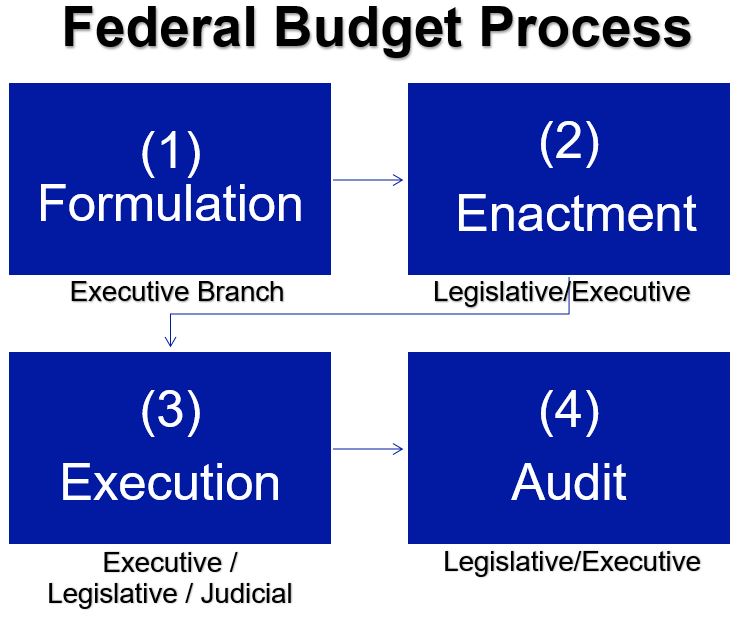
The overriding purpose of the Federal Budget Process is to have an approved budget in place before the start of the Fiscal Year for that budget.
The US Fiscal Year for a budget starts on October 1st and ends on September 30th of the following calendar year. The year we use to describe a Fiscal Year is the year in which the Budget period expires. So, for example, the 2024 Fiscal Year starts on October 1st, 2023 and ends on September 30, 2024.
Phase 1 (Formulation)
The purpose of the Budget Formulation phase is for the Executive Office to submit a Presidential Budget Request (PBR) to Congress by early February of the following year. Note that:
- The PBR is not enforceable by law (not a statute).
- The PBR is simply a request to Congress that shows what the agencies think they need and also signals any of the President’s priorities for the next budget.
- It also might include proposals for changing budget related laws, like increasing or decreasing tax rates (as part of an Authorizing Law or Reconciliation Bill…more on this later).
- The PBR is a massive set of documentation. You can see the latest version in this OMB web site.
Formulation takes about 1 year, starting in the Spring (let’s say March) and ending when the PBR is submitted to Congress in early February of the following calendar year. In the Spring, Government agencies and departments , with guidance from the OMB, develop their detailed proposed budgets.
These are eventually submitted to the OMB for review, where a back and forth process occurs to finalize the budgets. This is not a trivial task and involves hundreds of agencies and departments.
Phase 2 (Enactment)
The Enactment Phase occurs around the time the Presidential Budget Request, PBR, is submitted to Congress. Congress has the power of the purse, and so they have discretion to accept or reject any parts of the PBR.
This phase, taking around 8 to 9 months, involves Congress taking the PBR and using it as a starting point to develop a unified (between House and Senate) Concurrent Budget Resolution.
The Concurrent Budget Resolution is a comprehensive revenue and spending plan which allows the enactment of 12 Appropriation Laws (Bills). These laws generally provide “legal authority for federal agencies to incur obligations and to make payments out of the Treasury for specified purposes.”
Each Appropriation Bill is developed by one of the 12 Appropriations Subcommittees (see Appendix 2 for a listing). For example, The “Commerce, Justice, Science, and Related Agencies” Appropriations Bill includes funding for the Department of Commerce, the Department of Justice, the National Aeronautics and Space Administration (NASA), National Science Foundation (NSF) etc.
In addition to Appropriation Bills, the Enactment phase can also produce Authorization (Authorizing) Laws, Reconciliation Laws (revised Authorization Laws) and Continuing Resolutions (temporary Appropriation Laws). We’ll come back to these later.
Phase 3 (Execution)
The Execution Phase is the spending phase. Spending programs might cover one fiscal year (many of the Discretionary Spending programs), multiple years, or no years (many Entitlement Programs don’t have defined periods and go on indefinitely until the Authorizing Laws are changed.)
Remember that each Fiscal Year starts on October 1st and ends on September 30 of the following year (and the attributed year is always the latter year).
Phase 4 (Audit/Evaluation)
There are continuous budget auditing and evaluations going one, conducted by the Executive and Legislative Branch OMB and CBO (respectively) as well as the agencies themselves.
The Inspector General Act of 1978, the Chief Financial Officers Act of 1990, the Government Management Reform Act of 1994, the Federal Financial Management Improvement Act of 1996 , the Government Performance and Results Act (GPRA), the Standards for Internal Control in the Federal Government, and the Impoundment Control Act of 1974 all provide guidance and set requirements for auditing and evaluating spending programs.
Schematic 9.2 below adds a little more detail to Schematic 9.1.
Schematic 9.2 – Federal Budget Process Phases
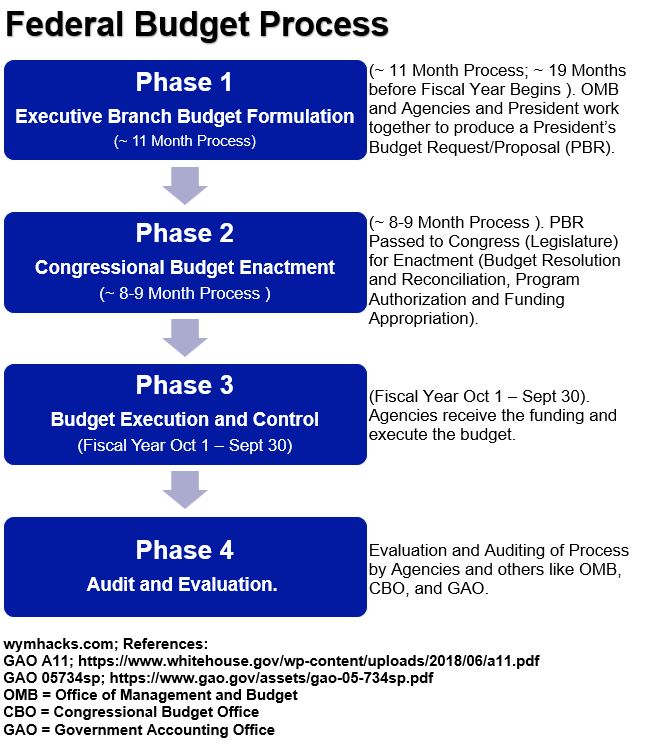
Summary of Yearly Budget Process
The annual Federal Budget Process proceeds as follows:
- The Executive Office Formulates a Budget Request (Proposal) and submits it to Congress.
- Congress Passes a Concurrent Budget Resolution and Enacts 12 Appropriations Laws which set Discretionary Spending levels.
- During the Enactment period, Congress can also pass Authorization (Authorizing) Laws, Reconciliation Laws, and Continuing Resolution Laws which we will address in a later section.
- The various agencies then Execute the budget (i.e. take obligations and pay cash) during the Fiscal Year (October 1 – September 30).
- Auditing and Evaluations occur throughout the process.
So we now know that it takes about 1.5 years to prepare a Federal Budget. But, how many budget cycles are going on at any given time? Let’s explore this a little in the next section.
Federal Budget Process Cycle/Timing
At this point, you should have the definite sense that preparing a single Federal Budget takes quite a bit of time and effort. But, at any given time, there might be as many as three different budget cycles, at different stages, being concurrently managed by the US Government.
Schematic 10.1 overlays Fiscal Year (FY) 2023, FY 2024 and FY 2025 budget activities.
The table header separates the months by Fiscal year (October – September) with the Calendar years shaded in grey. The three rows below the header map the budget phases for that year (FY23 or FY24 or FY25) against the months in the header. The phases are shown in different colors (we don’t show the audit phase to keep the chart less cluttered)
Schematic 10.1 – Federal Budget Phases and Timing for FY23,24,25
Focus on the 3rd row in the schematic above. This shows the full budget cycle for Fiscal Year 2025 (FY 25). For the Fiscal Year 2025 Budget, Phase 1 begins in March 2023 and ends in early Feb 2024 when the President presents the 2025 Presidential Budget Request (Proposal) to Congress.
Then between Feb. and Sept. 2024, Congress Enacts budgetary legislation in time for the beginning of the FY 2025 Budget (which begins on October 1 2024 and ends in September 30 2025).
Notice that there are three budget cycles in play. Assume that we are in August 2023 (see the white vertical double arrow in Schematic 10.1). At this time the US Government is Executing the FY 2023 Budget, Enacting the FY 2024 Budget , and Formulating the FY 2025 budget!
Summary of Federal Budget Process Cycle Timing Section
The US Government has the heady task of managing not only one but three Federal Budgets at any given time. For example in August 2023 the Government was
- Executing the FY 2023 Budget,
- Enacting the FY 2024 Budget , and
- Formulating the FY 2025 budget!
Let’s now dig deeper into the Formulation Phase of the Federal Budget Process.
Federal Budget Process – Phase 1 – Formulation
This section provides a little more detail on the Formulation phase of the Federal Budget Process.
Below is a Formulation Phase timetable, excerpted from Ref 1: GAO 5734sp Appendix I and Ref 2:OMB Circular A-11 Section 10. Excerpts are in quotations.
Ref 1:”Spring–Summer: OMB Establishes Policy for the Next Budget Request”
- Ref 2: “OMB issues spring planning guidance to Executive Branch agencies for the upcoming budget” (providing policy guidance for Budget Request).
- Ref 2: “OMB and the Executive Branch agencies discuss budget issues and options.”
- Ref 2: “OMB issues Circular No. A–11 (detailed instructions) to all federal agencies.”
Ref1:”September–October: Agencies Submit Initial Budget Request Materials”
Ref2: Agencies make and send in budget submissions to the OMB.
Ref 1: “October-December: OMB Performs Review and Makes Passback Decisions”
- Ref2: “OMB conducts its fall review. It analyzes agency budget proposals in light of Presidential priorities, program performance, and budget constraints. They raise issues and present options to the Director and other OMB policy officials for their decisions.”
- Ref2: Late November: “OMB briefs the President and senior advisors on proposed budget policies. The OMB Director recommends a complete set of budget proposals to the President after OMB has reviewed all agency requests and considered overall budget policies.”
- Ref2: Late November: “Passback. OMB usually informs all Executive Branch agencies at the same time about the decisions on their budget requests.”
- Ref2: December: “Executive Branch agencies may appeal to OMB”. Appeals are resolved by the OMB and agency or ,if needed, by the President.”
- Ref2: January: “Agencies prepare and OMB reviews congressional budget justification materials” (for congressional subcommittees).
Ref1:”By the First Monday in February: President Submits Budget Request”
- Ref2: February: “The President transmits the budget to the Congress ” by First Monday in February.
Schematic 11.1 shows the Formulation phase on a FY2025 Budget Calendar. It takes roughly 11 months to complete.
Schematic 11.1 – Calendar showing Formulation Phase for FY 2025 Budget
See the Formulation Phase steps in Schematic 11.2 (which I essentially copied from GAO-05-734sp figure 1).
Schematic 11.2 – US Federal Budget Formulation Process – Figure 1 – GAO05734sp
Presidential Budget Request Purpose
The PBR serves to:
- provide detailed budgetary data (for the upcoming Fiscal Year but also the following 9 years) including how much tax to collect and how much of a deficit the Government will run.
- define the President’s relative program priorities and how much money should be spent on them.
- includes any recommended Mandatory Spending law (e.g. Social Security) or revenue law (e.g. tax law) changes.
Presidential Budget Request Content
The PBR is a massive collection of current, historical , and estimated future budget amounts. You can review the documents in detail at Govinfo.gov. The PBR
- includes budget data for the upcoming fiscal year as well as the current year, past years, and estimated future years.
- contains requested appropriation changes or new appropriations for the current or upcoming fiscal years (respectively).
- estimates receipts by type and outlays by Agency and Account.
- estimates outlays by major Government Budget Functions.
- includes actual and estimates of surpluses and deficits.
- includes several other documents addressing economics, revenue, collections, taxes, debt, trust funds etc.
Check out Appendix 4 for a description of Government Budget Functions and Appendix 3 for information on Government agencies.
Presidential Budget Request – Impact on Enactment Phase
The Presidential Budget Request (PBR) does not carry any legal authority but it is required to be submitted to Congress by the first Monday in February of each year.
Congress can use the PBR as a starting point for the Enactment phase of the annual Federal Budget Process, but it is not obligated to duplicate it by any means. Often, significant changes are made by Congress. The lack of statutory authority of the PBR does not make it unimportant , as it can be used to communicate the President’s priorities to Congress and the public.
Presidential Budget Request – Timeliness
Let’s end this section with a little audit. How often do you think the President and his OMB have made an on-time submittal of their PBR to Congress? Using CRS report R43163 and Govinfo.gov here are the numbers:
- All though there is a statutory requirement to get the Presidential Budget Request (PBR) submitted on time (since 1990 the deadline has been the 1st Monday in February), there are no penalties associated with non-compliance.
- In the last 102 fiscal years, the PBR was submitted late 25.5% of the time by an average of 33 days.
- In the last 31 fiscal years, the PBR was submitted late 54.8% of the time (bad)!
- In the last 15 fiscal years, the PBR was submitted late 86.7% of the time (really bad)!
Schematic 11.3 – Presidential Budget Request Timeliness (FY1923 – 2023) 
So, long term, the Executive Office has done an average job of submitting the PBR on time; and short term, it’s done much less than average. An untimely PBR submittal threatens the timely completion of the following steps that happen once the PBR is submitted to Congress.
What happens after the President submits the PBR to Congress? Read on!
Budget Process – Phase 2 – Enactment
The Enactment Phase of the Federal Budget Process is sometimes called the Congressional Phase. It essentially begins when the President/OMB submit the Presidential Budget Request (PBR) to Congress. Since Congress has the constitutional “power of the purse”, it has final authority over what the budget and associated laws looks like.
We’ve seen that the PBR (Presidential Budget Proposal) is a massive set of detailed data representing input from 100s of agencies, but it is still just a request and has no legal authority. So Congress doesn’t have to use any of it, but in reality the PBR is an integral part of the Enactment process.
Let’s go through the various steps of the Enactment process as dictated by the Congressional Budget Act of 1974. As you read through the following sections, consider the following:
- Refer to the flow sheet Schematic 12.1 as you read through the steps. Sequential steps are labeled (A) through (I). The color shadings indicate the key group involved i.e. OMB and President (grey), CBO (green), Authorizing Committees (blue), Budget Committees (red), and Appropriations Committees (orange).
- My descriptions and Schematic 12.1 are based mostly on Appendix I and Figure 1 of the GAO document: GAO-05-734SP.
- To see a very crisp and polished description of the Enactment Process, refer to Phil Candreva’s video on the Federal Budget Process (the flowsheet presented in the video is very helpful).
- As you read through the required steps, idiosyncrasies and special rules of the process, ask yourself: (1) How reasonable is it to expect our leaders to complete the process each and every year ? (2) Is the process working as intended? (3) What would you do to improve the process?
Schematic 12.1 – US Federal Budget Process – Phase 2 – Enactment
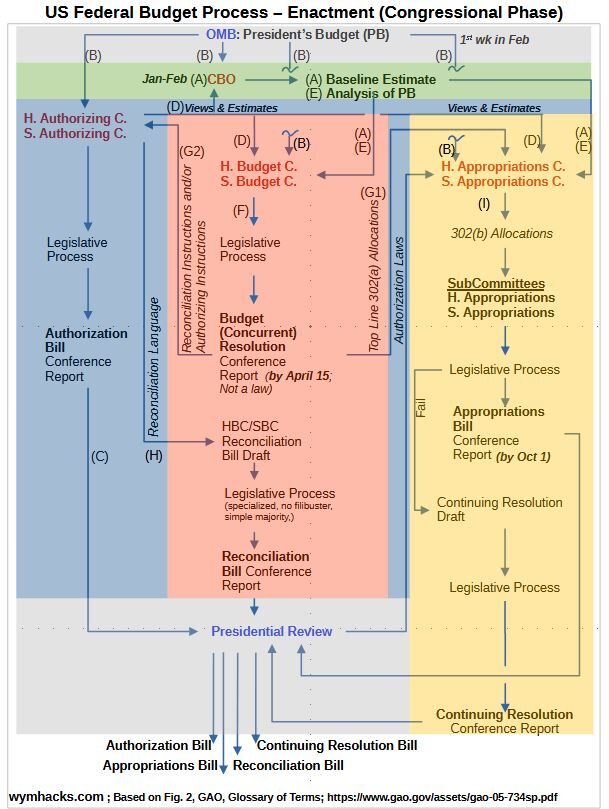
CBO Submits “Budget and Economic Outlook” Report
Timing: Late January – Early February; Schematic 12.1(A)
The CBO submits budget Baseline Estimates (see green shaded area in Sch.12.1) to the Budget Committees and Appropriation Committees. These estimates are contained in their report titled “The Budget and Economic Outlook“.
According to the CBO, this report presents “… its baseline projections of what the federal budget and the economy would look like in the current year and over the next 10 years if current laws governing taxes and spending generally remained unchanged”.
The report comes out early in the year (Jan-Feb) and is typically updated at least once during the year. You can find much more information at the CBO web site, like this article.
Presidential Budget Request (PBR) is Submitted to Congress
Timing: 1st Monday in February; Schematic 12.1(B)
See the grey shaded area at the top of Sch. 12.1. Congress is supposed to receive the PBR no later than the first Monday in February, but, as we noted in the previous section, the PBR is rarely submitted on time (in recent years for sure).
The PBR is sent out to all the main Enactment Phase players (CBO, Authorization / Appropriations/ Budget Committees).
At the same time, the President transmits Current Services Estimates to Congress. These estimate expenditures for the upcoming fiscal year assuming no changes are made.
Authorizing Committees Work on Authorizing Bills
Timing: These could happen before or after passing of the Concurrent Budget Resolution. ; Schematic 12.1(C)
See the blue shaded areas of Schematic 12.1.
As noted in the “Participants” section of this article, an Authorizing Committee is a standing congressional committee (see Committee definition in Appendix 1 or detailed listing of committees in Appendix 2) that also serves as an Authorizing Committee.
Authorizing Committees have subject matter expertise over certain agency programs and have the role of authorizing these programs; meaning giving people authority and providing the structure and rules under which those programs operate.
Both Mandatory and Discretionary Spending Bills are typically authorized. For example, the House and Senate Armed Services Committees would be Authorizing Committees for certain Department of Defense programs.
The primary goal of the annual Federal Budget Process is to produce 12 Appropriations Bills associated with the upcoming fiscal year’s Discretionary Spending. Each of these Appropriation Bills require an Authorizing Bill or Law.
Recall from the “Controlling Laws…” section that Authorizing Laws create, provide structure, and justify programs (and typically provide guidelines on money that may be spent), while Appropriation Laws typically fund the programs. Remember also that Authorizing Bills for Mandatory Spending programs are also required.
So, work on existing Authorizing Laws that need revisions or updates as well as work on new Authorizing Laws might occur early in the Federal Budget Process. I therefore show path (C) as an early-in-the-process activity, although I think these bills can be worked on at any time during the process (and perhaps other parts of the year also).
Authorizing Committees Transmit “Views and Estimates”
Timing: February; Schematic 12.1(D)
Early in the Enactment Phase the Authorizing Committees with jurisdiction over federal programs
- are (possibly) already starting work on Authorizing Bills (path (C)), but their main function in the beginning steps is to
- produce Views and Estimates reports on spending and revenue levels for programs under their jurisdiction.
- The reports are shared with all the players (see the path of (D)), but are mainly intended for the Budget Committees. The Budget Committees use these reports to develop the total revenue and spending estimates that will be part of their Concurrent Budget Resolution.
As if enough information wasn’t flying around, at about the same time, the Joint Economic Committee submits its recommendations concerning fiscal policy to the Budget Committees (not shown in an already too busy Schematic 12.1!)
Remember, I show path (C) as possibly happening early because usually Authorizing Laws are required to give legal authority to Appropriations Laws.
CBO Prepares an Analysis of the President’s Budget Request
Timing: February; Schematic 12.1(E)
In addition to the Baseline Estimate work it has done, the CBO also does an Analysis of the PBR and shares their findings with the Budget and Appropriations Committees.
So, the mental picture you should have at this point is (if the process is followed as intended): there is a lot of data and a lot of analysis going on.
Budget Committees Create and Deliver a Concurrent Budget Resolution
Timing: February – April (Budget Resolution should be adopted by April 15); Schematic 12.1(F)
We are now in the red shaded area of Schematic 12.1. The House and Senate Budget Committees, armed with the PBR and also the other reports and studies given to them, now go through the legislative process with the intention of passing a unified or Concurrent Budget Resolution.
Schematic 12. 1 indicates the “Legislative Process” with just two words, but we know this can be a complex and drawn out multi-step process (see the “Legislative Process” section of this article where we described the process using Schematic 8.1 shown below).
Legislative Process
- In the House and Senate: Hearings are held.
- In the House and Senate: Markups are made to proposed legislation.
- In the House and Senate: Budget Committee votes on it.
- In the House and Senate: Chamber votes on it.
- House and Senate members get together in a Conference Committee to reconcile and vote on the House and Senate Versions.
- In House and Senate: Chamber votes on it.
- The Conference Committee version is then passed to the President for Approval
Any failure to reach consensus results in a recycling and revision process.
Concurrent Budget Resolution
The Concurrent Budget Resolution provides, per GOA 734sp Appendix I , “… for the upcoming fiscal year and for each of at least the next 4 years)… the total level of new budget authority, outlays, revenues, the deficit or surplus, the public debt, and spending by functional category.”
“The Budget Resolution may include Reconciliation Instructions to the extent necessary to meet the revenue or direct spending targets in the budget resolution.” Refer to CRS report R47336 for more information.
There are special Senatorial procedures that pertain to Budget Resolution legislation. Debate time is limited and therefore Filibusters are not allowed. This means that a simple majority (51/100 or Vice Presidential tie breaker) vote passes the resolution.
One of the important deliverables of a Budget Resolution (see path (G1) in the Schematic 12.1) is called a 302(a) allocation, which sets a ceiling or limit on the total amount of Discretionary Spending for the upcoming fiscal year.
Appropriations Committees take the 302(a) limit and then subdivide the total among the 12 Appropriations Bills.
For example, the 302(a) limit for Fiscal Year (FY) 2016 was $1.017 Trillion (remember this is for Discretionary Spending). The House and Senate Appropriations Committees then established 302(b) allocations by dividing the 302(a) allocation into 12 allocations for each of the Appropriation Bills. You’ll see a full example of the FY2022 allocations later in this section.
Another deliverable/s are any Reconciliation Instructions to the Authorizing committees. These instructions typically require Authorizing Committees to begin drafting new or revised legislation for Authorizing Laws that impact Mandatory Spending programs. Notice, that the Budget Committees use the work of the Authorizing Committees to ultimately pass Reconciliation Bills (see paths (G2 and H) in Schematic 12.1).
The Concurrent Budget Resolution is Not a Law
The Budget Resolution does not become a law and does not get signed by the President. But, any budgetary parameters (like the 302(a) limit) are enforceable through Points of Order.
Points of Order are prohibitions against certain legislation (or congressional action) that violate various rules. Because the 302(a) limits are not self-enforceable, a member of Congress must raise a Point of Order to enforce the limits.
Concurrent Budget Resolutions Don’t Always Pass
How successful has Congress been with passing Concurrent Budget Resolutions? For the last 20 years the answer is, “not real good”. You can look at Appendix 6 for more details on this, so we’ll briefly summarize here.
- In the last 48 years the Concurrent Budget Resolution has failed to pass 12 times (that’s a 25% failure rate).
- In the last 20 years it has failed to pass 10 times (that’s a 50% failure rate) !
In the years in which the Budget Resolution was not passed, the House , Senate, or sometimes both, produce a more streamlined substitute called a Deeming Resolution.
Deeming Resolutions avoid the budget items that contributed to the Resolution not passing and focus on delivering a set of budget allocations to the Appropriations Committees. They are given their name because they are “deemed to serve in place of an annual Budget Resolution”. See the following references for more information on Deeming Resolutions: CRS – R46240 , CRS – R44296 , crfb.org .
Well, that’s depressing. So in the last 20 years, 1 out of every 2 Budget Resolutions have failed to pass (and have been substituted by much simpler and less controversial Deeming Resolutions).
So, what things happen after a Budget or Deeming Resolution is Passed? Two things: (1) Work on Authorizing Laws that are kicked off if the Resolution includes the instructions to do it , and (2) the Appropriations process begins.
Budget Reconciliation Bills
Timing: May–September; Schematic 12.1(G2) going into the blue shaded section.
Budget Reconciliation Bills are created under expedited Senate procedures (simple majority vote, no filibuster allowed) in order to change existing revenue or direct spending laws.
The process of creating them must begin with Budget Resolution language that instructs the responsible committee/s to create the necessary authorizing legislation. With legislation form the Authorizing Committees, the Budget Committees are responsible for passing Reconciliation Bills (Path (G2) and (H) in Schematic 12.1).
Due to easier voting hurdles in the Senate (No Filibuster allowed and therefore simple majority vote in play), parties have used Reconciliation Bills to pass laws that might (perhaps) not have otherwise been passed.
A total of twenty three (23) Reconciliation Bills have been passed (see Appendix 6 for a complete listing) as of December 11, 2023. Some of them have added massive amounts to our total debt. For example:
- (Republican) Tax cuts in FY 2002 and 2004 (deficit increased by 1.7 Trillion)
- (Republican) Tax cuts (deficit increased by $1.46 Trillion
- (Democrat) Rescue Plan Act (deficit increased by $1.86 Trillion)
Appropriation Bills
Timing: April15 – October 1; Schematic 12.1(G1) going into the orange shaded section.
Once a total Discretionary Spending allocation (302(a)) is provided by a Concurrent Budget Resolution (or Deeming Resolution if Concurrent Budget Resolution has failed to pass, or is late), the Appropriations Committees get to work producing the 12 Appropriations Bills. Check out Appendix 2 for more on congressional committees.
Schematic 12.2 below tabulates the 12 Appropriation Bills for FY2022. Each responsible subcommittee is required to produce a law which provides the budget to all the programs under that particular Bill.
For example, the Homeland Security Appropriations Act or Bill would provide funding to numerous programs/agencies like Customs and Border Protection (CBP), U.S. Immigration and Customs Enforcement (ICE), Transportation Security Administration (TSA), Federal Emergency Management Agency (FEMA) etc.
Notice the 302(a) and (b) allocations in Schematic 12.2. For FY 2022, the total limit as dictated by the Deeming Resolution was $1.66 Trillion. Remember, this is Discretionary spending which must be approved on an annual basis.
The 302(b) limits are the numbers listed on each row, for example, the Defense Bill had a whopping $709 Billion USD budget “cap” in Fiscal Year 2022.
Schematic 12.2 – Appropriation Bill Categories with 2022 302(a), 302(b) Allocations
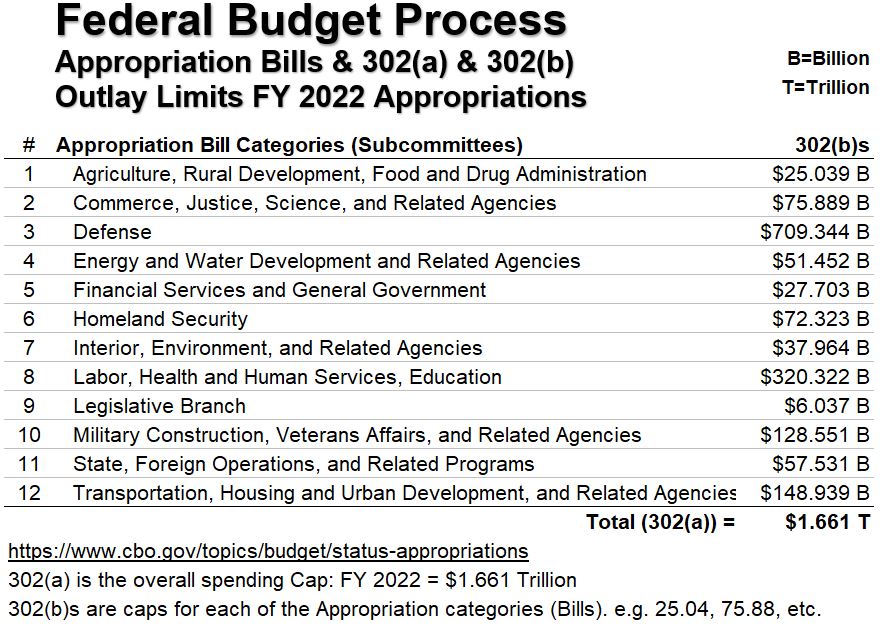
Here are key points describing the Appropriations Process:
- The House and Senate Appropriations Committees and Subcommittees are responsible for producing 12 annual Discretionary Spending bills.
- Each subcommittee (there are 12 in the House and another 12 in the Senate) is responsible for producing legislation for their responsible areas.
- Usually, the House committees start the legislative process for Appropriations Bills.
- The 302(a) total allocation is subdivided into the 12 302(b) sub allocations by the Appropriations Committees. These are then provided to the respective subcommittees.
- Members can invoke Points of Order if any of the limits are violated.
- Points of order are prohibitions against certain legislation (or congressional action) that violate various rules.
- Because the 302 limits are not self-enforceable, a member of Congress must raise a point of order to enforce the limits.
- The CBO also prepares a cost estimate on each appropriations bill and the Budget Committees use this information to check for compliance with budgetary requirements and limits (e.g. the 302 allocations).
- The 12 appropriations Bills can be enacted as 12 separate Bills or combined in different ways. If all are combined, the package is called an Omnibus bill, and if certain numbers are combined they called Minibus bills. How manageable do you think the process gets when these are combined?
- If the Committees fail to enact the 12 Appropriation Bills by October 1, then they must pass a Continuing Resolution. This ensures that Government program funding continues into the next fiscal year.
Appropriations Bill Legislative Process Flow
The Legislative process for developing and approving Appropriations Bills will be the same as described above for the bills and resolutions passed by the Authorizing and Budget Committees.
Schematic 12.3 below is another rendition of the Federal Budget yearly legislative process with a focus on Appropriations Bills. Although the process flow is presented as parallel work flows in the House and Senate, in reality, bills are usually started in one House and at some point are then worked on by the other House.
Regarding Schematic 12.3, we see that :
- To produce an Appropriations Bill you need 2 Budget Committees, 2 Appropriations Committees, and 24 Appropriations Subcommittees. That’s 28 different groups of people and does not even include the Conference Committees.
- Even when Budget Resolutions and Appropriations are agreed to (and it is often that these are not agreed to), the process is complicated and time consuming.
- We are not even considering the additional steps needed to (1) produce Deeming Resolutions when Budget Resolutions fail , (2) to produce Continuing Resolutions when Appropriation Bills fail , and (3) to produce Budget Reconciliations when the Budget Resolution calls for it.
Schematic 12.3 – US Federal Budget Process Flow with a Focus on Appropriation Law Enactment
Appropriation Bill Enactment Performance
- All 12 Appropriations Bills were passed on time only 4 times (out of 38; that’s 8.3% of the time).
- In 20 out of 38 years (41.7% of the time), NO Appropriations Bills passed on time.
- Notice all those 0%s in the Chart in recent years.
So , in general , especially recently, Appropriations Bills are not being submitted on time.
Schematic 12.4 – Appropriation Bill Timeliness (FY1977-2024)
Continuing Resolutions Enactments
Recall that a Continuing Resolution (CR) is a temporary funding measure that Congress uses when Appropriation Bills are not passed or are delayed beyond the start of the Fiscal Year.
Continuing Resolutions operate at the same level of funding as the previous year.
Consider Schematic 12.5 below:
- 199 Continuing Resolutions have been passed since 1977 (48 year period)
- 132 (66.3% of total) have been enacted since 1998 (last 28 years)
- There have only been 4 years where no Continuing Resolutions were passed!
So, since they started doing Continuing Resolutions 48 years ago, there have ONLY BEEN 4 Years where the full set of 12 Appropriations Bills were passed!
Schematic 12.5 – Continuing Resolution Enactments (FY1977 – 2024)
Schematic 12.6 shows the total duration of enacted Continuing Resolutions since 1998:
- The average Continuing Resolution duration was 139 days with a median (middle value) of 102 days.
Schematic 12.6 – Continuing Resolutions Durations (FY1998 – 2022)
What if Neither Appropriations nor Continuing Resolutions are Enacted?
The Antideficiency Act, with exceptions, prohibits the “obligation of funds in the absence of appropriations.”
If Appropriations (or Continuing Resolutions) are not active by the beginning of the fiscal year (October 1), then the period/s during the fiscal year in which this holds true is/are called Funding Gaps.
A Funding Gap generally requires the shutdown of programs under the Appropriation Bill or Bills that were not funded. Government shutdowns are disruptive and further reduce the efficiency of operations (i.e. people get furloughed and don’t do any work, but they all get paid back for this “non work” in the future).
But, Funding Gaps don’t always (and haven’t always) result in affected Government agency shutdowns:
- Short duration Funding Gaps have often avoided shutdowns.
- Enforcement via the Antideficiency Act only occurred after the issuance of “opinions” by Attorney General B. Civiletti in 1980 and 1981.
Check out Schematic 12.7. which shows Appropriations Funding Gaps since 1977:
- Since FY1977 there have been 20 Funding Gaps (1 to 34 day durations)
- About 1/2 of the Funding Gaps were less than 3 days in duration
- Many did not result in shutdowns as explained above
- As of Dec. 5, 2023, disruptive Government shutdowns occurred in 1996 (two of them for a total of 26 days), 2014(16 days), 2018(2 days), and 2019(34 days)
Schematic 12.7 – Appropriations Funding Gaps Since FY1977 (Through Dec 5, 2023)
Enactment Phase Timing
So, all the above actions, i.e. (1) pass a Concurrent Budget Resolution or Deeming Resolution, (2) pass 12 Appropriations Bills or Continuing Resolutions, (3) pass Budget Reconciliation Bills etc., need to be squeezed into a precarious 8 months (see the blue shaded area in Schematic 12.8 below).
Schematic 12.8 – Enactment Phase (Phase 2) Timeline (for example FY2025)

Given this short time to get so much done, how on earth can we expect our leaders to create reasonable and judicious spending legislation?
Conclusion
The annual Federal Budget Process takes about 19 months to complete (ideally). It requires the coordinated effort of numerous Government agencies and committees, and its main purpose is to produce 12 Appropriations Bills (Acts or Laws) that establish yearly funding levels for the many Government agencies and programs (the CBO listed 241 budgeted agencies in FY 2022; see Appendix 3).
In addition to Appropriations Bills, other legislature is frequently produced like Authorizing Bills (these create and structure spending programs), Reconciliation Bills (special kinds of Authorizing Bills) and Continuing Resolutions (stop gap measures when Appropriation Bills are not passed).
The Federal Budget Process is an intricate, sequential orchestration requiring conciliation and compromise to complete successfully. In the years since its inception in 1974 (via the Congressional Budget Act; CBA) and especially in recent years, it’s proven to be very difficult to complete in a timely and complete manner.
This article has focused mainly on the first two “creative” phases of the processes ;Formulation and Enactment (as shown in Schematic 13.1 below).
Phase 3 describes the spending phase during the budget fiscal year which starts on October 1st and continues to September 30 of the following calendar year (the year that it is named after). We’ll analyze a specific budget year in a separate article.
We brushed over the last phase (Audit and Evaluation), but understand that there are many checks and balances that are intended to ensure the budgets are “done and executed” properly.
Schematic 13.1 (Schematic 9.2) – Federal Budget Process

Schematic 13.2 shows the main Legislative and Executive Branch products of a Federal Budget Process. Notice how
- Failed (or late) Concurrent Budget Resolutions can be substituted with Deeming Resolutions.
- Deeming Resolutions allow the budget process to continue by providing total spending limits to the Appropriations Committees.
- Appropriations Bills that fail to pass (or are late) can be substituted with Continuing Resolutions that ensure no Government agencies are shutdown for lack of an approved budget.
- No Appropriation Bills and no Continuing Resolutions means affected Government agencies are shutdown, further increasing Government inefficiency and cost.
Schematic 13.2 (Schematic A6.1) – Federal Budget Process Resolutions and Bills
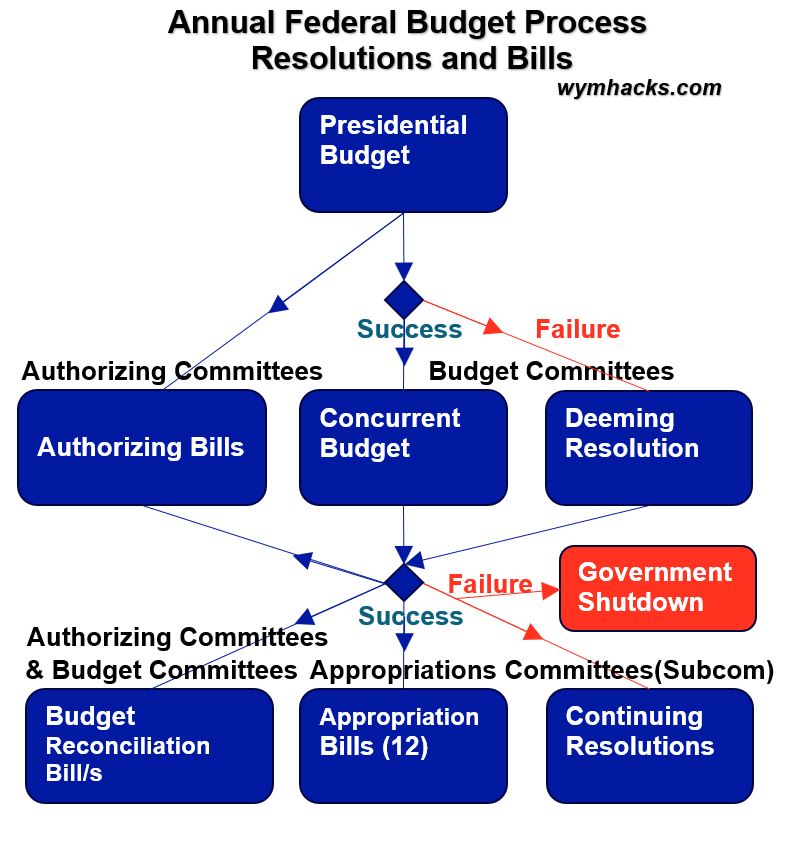
Schematic 13.3 shows some statistics , in maroon print, on how successful our leaders have been in passing budgetary legislation. It’s really not that good:
- The Presidential Budget Request has been submitted late 86.7% of the time in the last 15 years
- In 10 of the last 20 years (50% of the time), a Concurrent Budget Resolution has failed to pass and a substitute Deeming Resolution had to pass
- No Appropriations Bills were passed on time in 20 of the last 48 years. Continuing Resolutions (let the current budget continue as is) have been passed in all but 4 years since 1977.
- Due to a lack of an Appropriations Bill/s and Continuing Resolution/s, there have been 4 (actually 5 since two occurred in 1996) very disruptive Government shutdowns: 1996 (26 days), 2014 (16 days), 2018 (2 days), 2019 (34 days)
Schematic 13.3 (Schematic A6.9) – Annual Federal Budget Performance
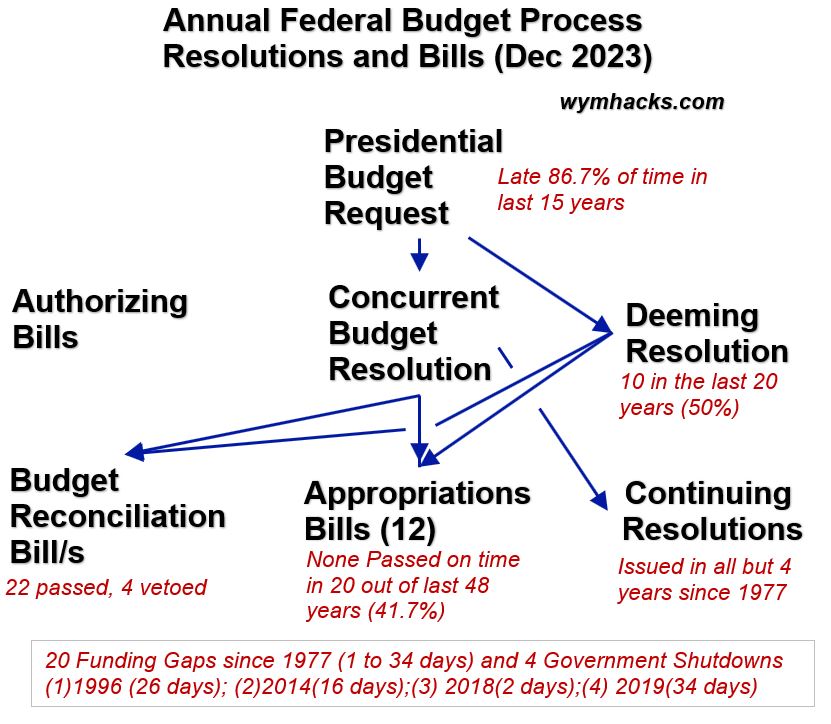
If you do an internet search or have heard any political commentary recently, you know it’s not a secret that many people (in and out of Government) consider the Federal Budget Process to be a failed and arcane system that is in desperate need of repair.
Below are my observations on the Federal Budget Process, understanding that it’s a lot tougher to fix things versus just complaining that they are broken.
The Budget Can Be Overwhelming in its Detail:
- The US Federal Budget is intimidatingly detailed. For example, for FY 2022, the OMB lists 563 spending programs/categories (114 offsets, 405 costs, and 43 not budgeted).
- In many ways the organization and structure of the US Federal Budget is beautifully structured (by category, by business function, by agency, by account, by fund type etc.). And almost all the data can be viewed relationally using database or spreadsheet tools.
The Budget Process is Inefficient and Subject to Abuse:
- Given the dismal record for passing Concurrent Budget Resolutions and Appropriations Acts, it seems that 19 months is hardly enough time to do it. Why does the Federal Budget Process need to be an annual process?
- Bundling Appropriations into Omnibus or Minibus bills increases the chances (in my view) that some budgetary items will not get any overview or vetting. They are essentially hidden in the big collection of bills.
- I can see Deeming Resolutions and Continuing Resolutions enabling congressional leaders to avoid compromise and real discourse.
- I think it should be really hard for Congress to pass budgetary laws that significantly impact revenue or spending.
- The special Senate voting and debate procedures (no Filibustering and therefore simple majority vote decides) that apply to Budget Reconciliation Acts (Laws), lower the hurdle for the party in power to get its legislation approved. Is the intended process being circumvented by doing this?
- There are some arcane traditions that don’t seem to encourage civil behavior, open two way discussion, and compromise e.g. Vote-a-ramas in the Senate and Magic Minute speeches in the House.
Get the Right People to At least Consider the Following:
- Stop Vote-a-ramas and Magic Minutes and anything else that bleeds the tax payer’s dollars.
- Remove the special voting and debate procedures that lower the hurdles for passing Budget Resolutions and Budget Reconciliation Bills in the Senate. These should be the hardest to approve.
- Almost all US states (Vermont is not required to but typically does) have some kind of balanced budget requirements. Why not adopt similar budget discipline in our Federal Government?
- Today’s Federal Budget Process timelines are unreasonable, especially given today’s partisan and non-compromising behaviors.
- Extend deadlines (makes sense) or throw more people at it. I’m not sure this second idea is real strong but, in 2023, there were about 2.95 million federal employees, 4.6 million state government employees, and another 14.1 million local government employees. Are we utilizing this work force efficiently?
- Do not shut the government down, ever. Streamline it, make it more efficient, but don’t create additional cost to the taxpayer because you can’t get the budget done on time!
- The Government shutdown requirements during a funding lapse are based on an interpretation (Opinions issued in 1980, 1981) of the Anti-Deficiency Act by President Carter’s Attorney General Benjamin Richard Civiletti. It’s time to re-interpret!
- Why does it take two laws (Authorizing and Appropriations) to enact Discretionary Spending? Make it one law.
- If a Budget Resolution is not passed or if an Appropriation bill is not passed on time, then there should be an automatic process to continue with the previous budget levels and guidelines.
And a Few More:
- Should every lawmaker be required to take a fiduciary oath to always work for the interest of the US taxpayer? (similar to a Fiduciary Investment Advisor).
- Should there be stronger incentives (positive and negative) in place to ensure Congressional and Executive Branch members produce an acceptable and on time budget?
- The Annual Budget Process focuses mainly on Discretionary Spending programs through passing of the Annual Appropriations Bills. But, in FY2022, this was just 26% of the total budget.
- Mandatory Spending programs like Medicare, Social Security, and other Entitlement programs account for 66% of the budget (the remaining being Net Interest on the Debt).
- Mandatory Spending programs don’t usually get yearly scrutiny and attention. They should since our yearly deficits are exploding.
- Would it be practical to expect that every Congress member who votes on a budgetary bill have some basic training in economics? How about requiring them to take an in-house course or seminar on basic economics and time value of money?
- Citizens need to understand the issues. Use the various government sources provided. There are lots of articles on line from reputable sources that address improvements. e.g. brookings.edu, aei.org, bipartisanpolicy.org, crfb.org, pgpf.org etc. Check out articles by Alice Rivlin on how to improve the Federal Budget process.
Epilogue
Congratulations! You’ve made it through the article, and you know a hell of a lot more about the Federal Budget Process.
But, don’t forget the Appendices if you want to review definitions (Appendix 1), or learn more about congressional committees (Appendix 2), agencies and departments (Appendix 3), Budget Functions (Appendix 4), legislative voting rules (Appendix 5), and a historical performance assessment of the Federal Budget Process (Appendix 6).
If you want to take a look at a detailed breakdown of the FY2022 budget, check out my article: The US Federal Budget – Part 2 – FY2022 Analysis.
Now, go do something useful.
Appendix 1 – Reference Links and Glossary
The definitions in this Appendix are based on (or obtained from) the following sources. Definitions copied verbatim are enclosed in parenthesis.
Reference Links/Listings
Ref1: Intro to Federal Budget Process – CRS – R46240
Ref2: Intro to the Federal Budget Process – CBPP
Ref3: Common Budgetary Terms Explained – CBO – 57660
Ref4: Glossary of Terms – Federal Budget Process – GAO-05-734SP
Ref5: US House of Rep. Glossary of Terms – house.gov
Ref6: Appropriations Process 101 – crfb.org
Ref7: Reflections on the Congressional Budget Act – americanprogress.org
Ref8: The Office of the Parliamentarian in the House and Senate
Ref9: Filibusters and Cloture in the Senate
Ref10: Whitehouse.gov Circular No. A-11 Budget Prep Agency Guidance
Ref11: Introduction to Budget Authority – CRS – IF12105
Ref12: Appropriations Committee description at senate.gov
Ref13: Obamawhitehouse.archives.gov Functional Classifications
Ref14: Democrats-budget.house.gov Functions
Ref15: Continuing Resolution Overview CRS-R46595
Ref16: CBO-Historical Budget Data-Files
Ref17: OMB-Historical Tables 1.1 – 16.2
Ref18: OMB – Analyt. Persp. Section-Budget Auth. & Outlays by Funct. Cat. & Prog. Table
Ref19: OASI-ssa.gov
Ref20: DI-ssa.gov
Ref21: IRS FICA Description
Ref22: What is Medicare – medicare.gov
Ref23: Medicare parts – ssa.gov
Ref24: Medicare Funding – medicare.gov
Ref25: Federal Excise Taxes-CRS-R43189/4
Ref26: Federal Budget Trust Funds – GAO-01-199sp
Definitions
302 (Section 302 of the Congressional Budget Act of 1974)
- Ref6: crfb.org: “The … budget resolution … includes what is known as a 302(a) allocation that sets a total amount of money for the Appropriations Committees to spend. For example, the conferenced budget between the House and Senate set the 302(a) limit for Fiscal Year (FY) 2016 at $1.017 trillion…Once they receive 302(a) allocations, the House and Senate Appropriations Committees set 302(b) allocations to divide total appropriations among the 12 subcommittees dealing with different parts of the budget.”
- Ref1: (CRS – R46240) : “…pertains to the distribution to House and Senate committees of new budget authority, entitlement authority, and outlays agreed to in a budget resolution. The allocation is usually included in the joint explanatory statement that accompanies the conference report on a budget resolution.
- Section_302(a) requires the allocation of the total spending in the budget resolution among the committees having jurisdiction over either direct or discretionary spending. When a budget resolution has not been adopted, the House and Senate (separately or jointly) may use some other means to establish committee allocations.
- Section_302(b) further requires the Appropriations Committee in each chamber to subdivide this total allocation among their subcommittees.
- Section_302(f) establishes a point of order against the consideration of a bill, amendment thereto, or conference thereon that would breach the appropriate 302(a) (or 302(b)) amount for the committee (or subcommittee).”
Antideficiency Act (1870 and later)
Ref10: (whitehouse.gov Circular No. A-11): “The Antideficiency Act consists of provisions of law that were passed by the Congress (beginning in the nineteenth century and later codified in Title 31 of the United States Code) to prevent departments and agencies from spending their entire appropriations during the first few months of the year. The Act prohibits…Federal employee from: (a) Entering into contracts that exceed the enacted appropriations for the year (b) Purchasing services and merchandise before appropriations are enacted.”
Appropriation (See Budget Authority)
- Generally, an amount of money set aside for a particular purpose. To appropriate is to set aside an amount of money for a particular purpose.
- Congress appropriates by providing Budget Authority for both Mandatory and Discretionary Spending programs.
- When dealing with Mandatory Spending programs (e.g. Entitlement programs like Social Security), Budget Authority can be described as Entitlement Authority which involves permanently (until law is changed) distributing funds based on eligibility of recipients).
- For Discretionary Spending programs (e.g. Defense programs), Budget Authority provides a legal Authorization to enter into Obligations for which payments (outlays) will be made from the Treasury. Just remember this sequence: Authorization (Budget Authority) ⇒ Obligation (enter into contract) ⇒ Outlay (pay). Discretionary Spending is established yearly through annually established Appropriations Acts (Bills).
Appropriation (Appropriation Bill or Act)
- The annual Federal Budget Process requires that 12 Discretionary Spending Bills (called Appropriation Bills be passed yearly). See “Appropriation Subcommittees” for a listing of the 12 Bill categories.
- Ref6: (www.crfb.org): “Appropriations are annual decisions made by Congress about how the US Federal Government spends some of its money. In general, the appropriations process addresses the discretionary portion of the budget – spending ranging from national defense to food safety to education to federal employee salaries – but excludes mandatory spending, such as Medicare and Social Security, which is spent automatically according to formulas.
- For Discretionary Spending , an Authorization Bill creates and justifies the program and (typically) provides guidelines on money that may be spent. An Appropriations Bill then funds an authorized program. For Mandatory Spending programs (e.g. Social Security) the Authorization Bill both authorizes and appropriates funding.
- Ref5: “A law of Congress that provides an agency with budget authority. An appropriation allows the agency to incur obligations and to make payments from the U.S. Treasury for specified purposes”
- Authorization Bills must be approved by the President (or veto overridden) to become laws. They can be passed individually or in packages called Omnibus (all 12 packaged together) or Minibus Appropriation Bills.
Appropriation_(Appropriation Bill or Act) – continued
- Ref1: (CRS – R46240) : “Legislation that provides budget authority to allow federal agencies to incur obligations and to make payments out of the Treasury for specified purposes, usually during a specified period of time. Discretionary appropriations measures are under the jurisdiction of the House and Senate Committees on Appropriations.”
- Ref6 (www.crfb.org): “Authorization bills create, extend, or make changes to statutes and specific programs and specify the amount of money that appropriators may spend on a specific program (some authorizations are open-ended). Appropriations bills then provide the discretionary funding available to agencies and programs that have already been authorized. For example, an authorization measure may create a food inspection program and set a funding limit for the next five years; however, that program is not funded by Congress until an appropriations measure is signed into law.”
- Ref6 (www.crfb.org): “The authorization bill designs the rules and sets out the details for the program, while the appropriations bill provides the actual resources to execute the program. In the case of mandatory spending, an authorization bill both authorizes and appropriates funding for a specific program without requiring a subsequent appropriations law.”
Appropriation Committee
- A congressional committee that plays a key role in the annual Federal Budget Process. The Senate and the House each of 1 Appropriations Committee and 12 Appropriations Subcommittees (a total of 26 committees not including the joint Conference committees comprised of house and senate members).
- Ref12 (senate.gov): “The Senate Appropriations Committee is the largest committee in the U.S. Senate… It’s role is defined by the U.S. Constitution, which requires “appropriations made by law” prior to the expenditure of any money from the Federal treasury. The Committee…writes the legislation that allocates federal funds to the numerous government agencies, departments, and organizations on an annual basis.”
- Ref12 (senate.gov): “Twelve subcommittees are tasked with drafting legislation to allocate funds to government agencies within their jurisdictions. These subcommittees are responsible for reviewing the President’s budget request, hearing testimony from government officials and other witnesses, and drafting the spending plans for the coming fiscal year. Their work is passed on to the full Senate Appropriations Committee, which may review and modify the bills and approve them for consideration by the full Senate. The Committee is also responsible for supplemental spending bills, which are sometimes needed in the middle of a fiscal year to compensate for emergency expenses.”
Appropriation_Subcommittees
- The annual Federal Budget Process uses 12 House Appropriation Subcommittees and 12 Senate Appropriations Subcommittees to develop yearly Appropriations Bills (a reconciled set of 12). All agency proposed budgets are placed into one of the 12 categories listed below. Often these bills have been combined (called Omnibus if all of them are combined and Minibus if a subset of them is combined).
- The Budget Resolution developed by the House and Senate Budget Committees sets the top line spending limit for the year (Called 302(a) limit…see “302(a)”). For example the cap or limit for the 2022 budget (for all 12 categories) was 1.47 Trillion USD.
- The Appropriations Committees set the individual bill spending caps (called 302(b)s….see “302(a)). For example, the 2022 cap on the Defense Bill was 728.5 Billion USD.
- Note that there used to be 13 Appropriations Bills which were consolidated into 12 in the 2005 to the 2008 time period.
- Agriculture, Rural Development, Food and Drug Administration
- Commerce, Justice, Science, and Related Agencies
- Defense
- Energy and Water Development and Related Agencies
- Financial Services and General Government
- Homeland Security
- Interior, Environment, and Related Agencies
- Labor, Health and Human Services, Education
- Legislative Branch
- Military Construction, Veterans Affairs, and Related Agencies
- State, Foreign Operations, and Related Programs
- Transportation, Housing and Urban Development, and Related Agencies
Article I, Section 9, Clause7 of the Constitution
- Ref4 (GAO-05-734SP ): “The United States Constitution gives Congress the power to levy taxes, to finance government operations through appropriations, and to prescribe the conditions governing the use of those appropriations. This power is referred to as the congressional “power of the purse.”
- Ref4 (GAO-05-734SP continued): ” The power derives from various provisions of the Constitution particularly article I, section 9, clause 7, which provides that: “No money shall be drawn from the Treasury, but in Consequence of Appropriations made by Law; and a regular Statement and Account of the Receipts and Expenditures of all public Money shall be published from time to time.””
- Ref4 (GAO-05-734SP ): “Thus an agency may not draw money out of the Treasury to fund agency operations unless Congress has appropriated the money to the agency. At its most basic level, this means that it is up to Congress to decide whether to provide funds for a particular program or activity and to fix the level of that funding.”
- Ref4 (GAO-05-734SP continued): “Although the Constitution does not provide detailed instructions on how Congress is to do so, Congress has and continues to implement its power of the purse in two ways: through the enactment of laws that raise revenue and appropriate funds, including annual appropriations acts, and through the enactment of “fiscal statutes” that control and manage federal revenue and appropriations (one such fiscal statute, the Antideficiency Act, is explained in detail in phase 3).”
Authorization (Authorization Bill)
- For Discretionary Spending , an Authorization Bill creates and justifies the program and (typically) provides guidelines on money that may be spent. An Appropriations Bill then funds an authorized program. For Mandatory Spending programs (e.g. Social Security) the Authorization Bill both authorizes and appropriates funding.
- Ref6 (www.crfb.org): “Authorization bills create, extend, or make changes to statutes and specific programs and specify the amount of money that appropriators may spend on a specific program (some authorizations are open-ended). Appropriations bills then provide the discretionary funding available to agencies and programs that have already been authorized. For example, an authorization measure may create a food inspection program and set a funding limit for the next five years; however, that program is not funded by Congress until an appropriations measure is signed into law. The authorization bill designs the rules and sets out the details for the program, while the appropriations bill provides the actual resources to execute the program. In the case of Mandatory Spending, an authorization bill both authorizes and appropriates funding for a specific program without requiring a subsequent appropriations law.”
Authorizing Committee
- A standing congressional committee (see Committee definition or Appendix 2) that serves as an Authorizing Committee. Authorizing Committees have subject matter expertise over certain agency programs and have the role of authorizing these programs; meaning giving people authority and providing the structure and rules under which those programs operate.
- For example, the House and Senate Armed Services Committees could be Authorizing Committees for certain Department of Defense programs.
- Ref4 (GAO-05-734SP ): “A standing committee of the House or Senate with legislative jurisdiction over the establishment, continuation, and operations of federal programs or agencies. The jurisdiction of such committees extends, in addition to program legislation, to authorization of appropriations legislation. (Normally, authorization of appropriations legislation is a prerequisite for making appropriations for the given programs or agencies.) An authorizing committee also has jurisdiction in those instances where backdoor authority is provided in the substantive legislation.”
- Ref1: (CRS – R46240) : “Legislative committees—such as the House Committee on Armed Services and the Senate Committee on Commerce, Science, and
Transportation—are responsible for authorizing legislation related to the agencies and programs under their jurisdiction. Most standing committees have authorizing responsibilities.
Balanced Budget and Emergency Deficit Control Act of 1985 (BBEDCA)
- Ref10: (whitehouse.gov Circular No. A-11): “…refers to legislation that shaped the budget process, first by setting fixed targets for annual deficits and then by replacing those with a Pay-as-you-go (PAYGO) requirement for new tax or mandatory spending legislation and with caps on annual discretionary funding. The Statutory Pay-As-You-Go Act of 2010, which did not amend BBEDCA, reinstated a statutory PAYGO rule for revenues and mandatory spending legislation. The Fiscal Responsibility Act of 2023 (Public Law 118-5), which amended BBEDCA, reinstated discretionary caps on budget authority through 2025.”
- Ref10: (whitehouse.gov Circular No. A-11): Provides guidelines on how OMB prepare baseline estimates.
- Ref10: (whitehouse.gov Circular No. A-11): “BBEDCA divides spending into two categories—discretionary and mandatory.”
- Ref10: (whitehouse.gov Circular No. A-11): “Sequestration is the cancellation of budgetary resources for budget enforcement purposes. Sequestration is required under certain circumstances as set forth in the Balanced Budget and Emergency Deficit Control Act of 1985 (BBEDCA), as amended, and the Statutory Pay-As-You-Go Act of 2010 (PAYGO Act).
Baseline Estimate
- Ref4 (GAO-05-734SP ): “Projected levels of governmental receipts (revenues), budget authority, and outlays for the budget year and subsequent fiscal years, assuming generally that current policies remain the same, except as directed by law. The baseline is described in the Congressional Budget Office’s (CBO) annual report for the House and Senate Budget Committees, The Budget and Economic Outlook, which is published in January. The baseline, by law, includes projections for 5 years, but at the request of the Budget Committees, CBO has provided such projections for 10 years. In most years the CBO baseline is revised in conjunction with CBO’s analysis of the President’s budget, which is usually issued in March, and again during the summer. The “March” baseline is the benchmark for measuring the budgetary effects of proposed legislation under consideration by Congress. “
Budget_and Accounting Act of 1921
- The Budget and Accounting Act of 1921 (1) Requires the President to Submit an Annual Budget (2) Created the Office of Management and Budget (OMB) and (3) created the Government Accountability Office (GAO).
Ref10: (whitehouse.gov Circular No. A-11): “Before enactment of this law in 1921, there was no annual centralized budgeting in the Executive Branch. Federal government agencies usually sent budget requests independently to congressional committees with no coordination of the various requests in formulating the federal government’s budget. The Budget and Accounting Act required the President to coordinate the budget requests for all government agencies and to send a comprehensive budget to the Congress. It created the Bureau of the Budget, now the Office of Management and Budget (OMB), to help the President implement these requirements. It also required the President to include certain information in the budget. The Congress has amended the requirements many times and has codified them as Chapter 11, Title 31, U.S. Code. T
Budget and Economic Outlook Report (See Baseline Estimate)
- Ref4 (GAO-05-734SP ): “Projected levels of governmental receipts (revenues), budget authority, and outlays for the budget year and subsequent fiscal years, assuming generally that current policies remain the same, except as directed by law. The baseline is described in the Congressional Budget Office’s (CBO) annual report for the House and Senate Budget Committees, The Budget and Economic Outlook, which is published in January.”
Budget_Authority
- Congress Appropriates by providing Budget Authority to Government entities to enter into Obligations (binding contracts) to make outlays (payments).
- The term applies to both annual Appropriations for Discretionary Spending and Mandatory (Entitlement) Spending (which is dictated by permanent laws).
- Ref1: (CRS – R46240) : “Authority provided by federal law to enter into financial obligations that will result in immediate or future outlays involving federal government funds. The main forms of budget authority are appropriations, entitlement authority, borrowing authority, and contract authority. It also includes authority to obligate and expend the proceeds of offsetting receipts and collections. Congress may make budget authority available for one year, several years, or an indefinite period, and it may specify definite or indefinite amounts.”
- Ref11: (CRS – IF12105): “…when Congress enacts an appropriation it is providing an agency with “budget authority” that can be used to finance federal programs and activities. This budget authority allows agencies to enter into various financial obligations and for the Treasury to subsequently outlay the funds to meet those obligations.
- The Budget Process, for Discretionary Spending programs, entails three steps: (1) Congress provides Budget Authority (typically annually) (2) Various Agencies enter into Obligations or binding commitments to spend and (3) Various Agencies actually spend the money (outlays or expenditures). For Mandatory Spending , Authorization Laws dictate the level and structure of funding.
Budget_Committee
- As part of the annual Federal Budget Process, the House and Senate Budget Committees are required to create and pass yearly Budget Resolutions.
- The House and Senate Budget Committees were established by the Congressional Budget and Impoundment Control Act of 1974 (CBA).
- Ref2 (CBPP): “The House and Senate Budget Committees draft and enforce the congressional budget resolution. Once the Budget Committees pass their budget resolutions, the resolutions go to the House and Senate floors, where they can be amended. The budget resolution for the year is adopted when the House and Senate pass the identical measure, either after negotiating a conference agreement or after one chamber passes the resolution adopted by the other.”
- The House and Senate Budget Committees also develop Reconciliation Bills which mainly authorize changes in Mandatory Spending and taxes.
Budget_Cycle
- The Government is typically working on 3 budgets at a time. For example, in February 2023, (1) the Government would be spending money for Fiscal Year (FY) 2023 (2) the President and OMB would present the Presidential Budget Request to Congress for FY 2024 and (3) the executive agencies would be planning for FY 2025.
Budget_Enforcement Act of 1990 (BEA)
- Ref10: (whitehouse.gov Circular No. A-11): “The CBA was amended extensively by a series of laws. BBEDCA, one of these amendments, had as its central feature a series of declining deficit targets. BBEDCA was amended by the Budget Enforcement Act (BEA), which applied a statutory pay-as-you-go (PAYGO) process to mandatory spending and revenue legislation and discretionary spending limits to annual appropriations acts. The statutory PAYGO process and discretionary spending limits expired in 2002. More recently enacted laws, however, have reinstated the statutory budget enforcement mechanisms for mandatory spending and revenues and discretionary spending.
Ref (Google Bard): BEA key implementations were (1) The BEA set annual caps on discretionary spending. If caps were exceeded, automatic spending cuts would be triggered. (2) Pay-as-you-go (PAYGO) requirement: New legislation causing increases in mandatory spending or tax reductions was required to be offset by spending cuts or revenue increases (to avoid increasing the deficit).
Budget_Equation (Federal Budget Equation)
- The US Federal Budget is a yearly accounting of the US Government’s cash inflows (Revenues or Receipts) and outflows (Outlays or Spend or Expenditures).
- Each year, the US Federal Government’s balance of cash flows results in a Balanced Budget, a Budget Deficit, or a Budget Surplus.
- Receipts – Outlays <0 (Deficit)
- Receipts – Outlays > 0 (Surplus)
- Receipts = Outlays (Balanced)
Budget_Functions
- See Function Classification
Budget_Proposal (Request)
- The Congressional Budget Process begins when the President (OMB) submits the annual Budget Proposal (Request) to Congress. The law (not enforced and often not met) requires this to be submitted no later than the first Monday in February. (e.g. February 2023 for the 2024 Budget Fiscal Year which begins on October 2023 and ends on September 30 2024.).
Budget_Process (Federal Budget Process)
- The Federal Budget process can be broken down into three or four phases depending on which Government documents you use.
- Phase 1. Executive Branch Budget Formulation. (~ 11 Month Process; ~ 19 Months before Fiscal Year Begins ). OMB and Agencies and President work together to produce a President’s Budget Request/Proposal (PBR).
- Phase 2. Congressional Budget Enactment (~ 8-9 Month Process ). PBR Passed to Congress (Legislature) for Enactment (Budget Resolution and Reconciliation, Program Authorization and Funding Appropriation).
- Phase 3. Budget Execution and Control (Fiscal Year Oct 1 – Sept 30). Agencies receive the funding and execute the budget.
- Phase 4. Audit and Evaluation. Evaluation and Auditing of Process by Agencies and others like OMB, CBO, and GAO.
- See Ref10: (Circular No. A-11)
- See Ref4: (GAO-05-734SP)
Budget_Reconciliation (see Reconciliation, see Budget Resolution)
Budget_Request (Presidential Budget Request or Proposal or PBR)
- The Congressional Budget Process begins when the President (OMB) submits the annual Budget Proposal (Request) to Congress. The law (not enforced and often not met) requires this to be submitted no later than the first Monday in February. (e.g. February 2023 for the 2024 Budget Fiscal Year which begins on October 2023 and ends on September 30 2024.).
- A significant portion of the PBR addresses the yearly budget appropriations (Discretionary Spending).
- The PBR is a very detailed document showing the President’s priorities. The PBR Delineates how much the Government should spend and tax, and how much of a deficit or a surplus the Government should run.
- The Executive office (Agencies, OMB, President) prepares the PBR each year. Congress is not responsible for the PBR.
Budget_Resolution
- A key product of the annual Federal Budget Process which sets spending limits that the congressional Appropriations Committees must honor. It is not a law (statute).
- Ref6: (crfb.org): “After the President submits the Administration’s budget proposal to Congress, the House and Senate Budget Committees are each directed to report a budget resolution that, if passed by their respective houses, would then be reconciled in a budget conference. The resulting budget resolution, which is a concurrent resolution and therefore not signed by the President, includes what is known as a 302(a) allocation that sets a total amount of money for the Appropriations Committees to spend”
- Ref1: (CRS – R46240) : “A concurrent resolution, provided under the Congressional Budget Act, that allows Congress to make decisions about overall fiscal policy and priorities, as well as coordinate and establish guidelines for the consideration of various budget related measures. Because a concurrent resolution is not a law, it cannot be signed or vetoed by the President. It therefore does not have statutory effect, so no money can be raised or spent pursuant to it. Revenue and spending amounts set in the budget resolution, however, establish the basis for the enforcement of congressional budget policies through points of order.
- Takes a simple majority in Senate to approve (i.e. unlimited debate or Filibustering is not allowed).
- Budget Resolutions can also contain guidance on creating Budget Reconciliation Bills (which also cannot be Filibustered and only a simple majority is needed to approve in the Senate). Reconciliation Bills can change/create legislation related to revenues (taxes) and spending including Mandatory Spending.
CBA (see Congressional Budget and Impoundment Control Act of 1974)
Also known as the Congressional Budget Act or CBA.
Cloture
- In the Senate, unlimited debates/speeches known as Filibusters can be ended by invoking the Cloture Rule which requires a 3/5 super- majority vote (60 votes today).
Collections
- Ref10: (whitehouse.gov Circular No. A-11): ” Collections mean money collected by the government that the Budget records as a governmental receipt, an offsetting collection, or an offsetting receipt.”
- Ref4 (GAO-05-734SP ):” Amounts received by the federal government during the fiscal year. Collections are classified into three major categories: (1) governmental receipts (also called budget receipts or federal receipts), (2) offsetting collections, and (3) offsetting receipts. Governmental receipts result from the exercise of the government’s sovereign powers. Offsetting collections and receipts result from businesslike transactions with the public or transactions between appropriated activities. Offsetting collections and offsetting receipts are recorded as offsets to spending. They are offsetting collections when the collections are authorized by law to be credited to expenditure accounts. Otherwise, they are deposited in receipt accounts and called offsetting receipts.”
Committee (Congressional Committee)
- See Appendix 2 for a complete listing of congressional committees.
- Congressional committees exist in both the House and Senate. They comprise members of congress who specialize in the areas they oversee.
Committees
- Ref (senate.gov): “…monitor on-going governmental operations, identify issues suitable for legislative review, gather and evaluate information, and recommend courses of action to the Senate”.
- Ref (House.gov): “…consider bills and issues and oversee agencies, programs, and activities within their jurisdictions.”
- Ref (Senate.gov): “..gather information on national and international problems within their jurisdiction in order to draft, consider, and recommend legislation…”
- There are Standing Committees, Authorizing Committees, Joint Committees, Special/Select Committees, and Conference Committees
Concurrent Resolution
- The annual Federal Budget Process Budget Resolution is a concurrent resolution. (see Budget Resolution).
- According to Wikipedia, “In the United States Congress, a concurrent resolution is a resolution passed by both the House of Representatives and the Senate but is not presented to the President for signature and does not have the force of law. In contrast, joint resolutions and bills are presented to the President and, once signed or approved over a veto, are enacted and have the force of law.”
Congressional Budget and Impoundment Control Act (CBA) of 1974
- Also known as the Congressional Budget Act
- The CBA established (provides the framework for) the Federal Budget Process we “follow” today. It requires a Budget Resolution to be passed each year. It created the CBO (Congressional Budget Office) and the House and Senate Budget Committees. Based on my readings, it appears that Congress mainly enacted the CBA to curtail the President’s (Nixon at the time) power of impoundment (withholding or impounding funds appropriated by the Congress).
- Ref7 (www.americanprogress.org) : “In 1974, the efforts of members of Congress to assert their own prerogatives, improve timeliness of budgets, and more effectively set national priorities finally culminated in the CBA. This new law achieved the following major structural changes in federal budget policy:
- Established the House and Senate Budget Committees
- Established the Congressional Budget Office (CBO)
- Effectively eliminated executive impoundments
- Established the budget process and timeline”
- See the following articles, some of which suggest, that the main purpose of the Act was to prevent Nixon from impounding congressionally approved funding.
- taxpolicycenter.org history of budget process.pdf
- crfb.org Budget act at 40 time for a tune up.pdf
- pgpf.org q and a congressional budget and impoundment control act of 1974
- politico.com Richard Nixon and congressional budget control act history
Congressional_Budget_Act of 1974 – Section 302 (see 302)
Congressional_Budget_Office (CBO)
- The non-partisan Congressional Budget Office provides Congress with information about budgetary and economic issues. It kicks off the annual Federal Budget Process by issuing a Baseline Budget Estimate to the Budget and Appropriations Committees.
- It is an integral part of the Congressional Phase of the Federal Budget Process (e.g. provides baseline estimates at the beginning of this Phase). The CBO releases periodic publications on budget options for reducing the deficit. It also published monthly budget reviews and also has a role in Scorekeeping (tracking the budget effects of Congressional legislation). The CBO also publishes 10 year budget forecasts.
- The Congressional Budget Office (CBO) was established by the Congressional Budget and Impoundment Control Act of 1974 (CBA).
- Ref1: (CRS – R46240) : “The CBA (Congressional Budget Act of 1974) also established the House and Senate Budget Committees as well as the Congressional Budget Office (CBO) to provide Congress with an independent source for budgetary information, particularly estimates concerning the cost of proposed legislation.”
Congressional_Phase of the Budget Process
- The second phase of the Federal Budget Process. Duration is about 8 to 9 months.
- Ref10: (Circular No. A-11) : “Congressional. This phase starts in late January or February, when the Congress receives the President’s Budget. The Congress does not vote on the President’s Budget itself, and it does not
enact a budget of its own, as such. It considers the President’s Budget proposals, passes an overall revenue and spending plan called a “budget resolution,” and enacts the regular appropriations acts and other laws that control spending and receipts.” - For the chronological steps listed below, these occur in the Calendar Year preceding the Fiscal Year (for example occur in 2023 for Fiscal Year 2024 Budget)
- Timing: (January) “Congressional Budget Office (CBO) reports to Budget Committees on the economic and budget outlook.”
- Timing: (February) “CBO re-estimates the President’s Budget based on their economic and technical assumptions.”
- Timing: (Within 6 weeks of budget transmittal) “Other committees submit “views and estimates” to House and Senate Budget Committees. Committees indicate their preferences regarding budgetary matters for which they are responsible.”
- Timing: (April 15): “The Congress completes action on the concurrent resolution on the budget. The Congress commits itself to broad spending and revenue levels by passing a budget resolution.”
- Timing: (September 30): “The Congress needs to complete action on appropriations bills for the upcoming fiscal year or provide a “continuing resolution” (a stop-gap appropriation law).”
Congressional_Research Service (see CRS)
Continuing Resolution
- A Continuing Resolution (CR) is a temporary funding measure that Congress uses when Appropriation Bills are not passed or are delayed beyond the start of the Fiscal Year. Continuing Resolutions operate at the same level of funding as the previous year.
- Ref1: (CRS – R46240) : ” Continuing resolution (CR). When annual appropriations acts are not enacted by the beginning of the Fiscal Year (October 1), one or more continuing appropriations acts may be enacted to provide temporary continued funding for covered programs and activities until action on regular appropriations acts is completed. Such funding is provided for a specified period of time, which may be extended through the enactment of subsequent CRs. Rather than providing a specific amount of funding, CRs typically allow agencies to operate at a specified rate. A continuing appropriations act is commonly referred to as a continuing resolution or CR because historically it has been in the form of a joint resolution rather than a bill, but there is no procedural requirement as to its form. In some cases, CRs have provided appropriations for an entire Fiscal Year.”
Ref15: (CRS-R46595): CRs are supposed to be stop gaps to be used occasionally. They are actually used all the time. Since Fiscal Year 1998 (to 2023), 132 Continuing Resolutions have been enacted. There have only been four years since 1977 (to 2023) where no Continuing Resolutions have been enacted for the year.
CRS (Congressional Research Service)
- Ref (CRS) : “The Congressional Research Service (CRS) serves as shared staff to congressional committees and Members of Congress. CRS experts assist at every stage of the legislative process — from the early considerations that precede bill drafting, through committee hearings and floor debate, to the oversight of enacted laws and various agency activities.”
Current Service Estimate
- Ref4 (GAO-05-734SP ): “Estimates submitted by the President of the levels of budget authority and outlays for the ensuing fiscal year based on the continuation of existing levels of service. These estimates reflect the anticipated costs of continuing federal programs and activities at present levels without policy changes. Such estimates ignore all new presidential or congressional initiatives, including reductions or increases that are not yet law.”
Customs Duty
- Customs Duties are a type of US Federal Budget revenue or receipt.
- Ref (Customs duty info-cbp.gov) : “Customs Duty is a tariff or tax imposed on goods when transported across international borders. The purpose of Customs Duty is to protect each country’s economy, residents, jobs, environment, etc., by controlling the flow of goods, especially restrictive and prohibited goods, into and out of the country.”
- The Harmonized Tariff Schedule of the United States (HTS) establishes tariff rates on all merchandise imported into the United States.
- Customs duties amounted to about 99 Billion USD in FY 2022 (about 2% of total revenues).
- Cbp.gov publishes a report called the “CBP Trade and Travel Report” which provides some information on customs duties imposed for a particular fiscal year. Some significant revenue can come from what are called Section 201, 232, and 301 duties (in 2022 these included duties on aluminum, steel, solar panels, and China Products).
Deeming Resolution
- Legislation that serves the same purpose as a Budget Resolution if Congress can’t agree on one (or if it’s late).
- Ref1: (CRS – R46240) : “An informal term that refers to a resolution or bill passed by one or both houses of Congress that provides an alternate means to establish the basis for budgetary enforcement actions in the absence of a budget resolution.”
- Ref :(CRS – R44296): “In the absence of agreement on a budget resolution, Congress may employ alternative legislative tools to serve as a substitute for a budget resolution. These substitutes are typically referred to as “deeming resolutions,” because they are deemed to serve in place of an annual budget resolution for the purposes of establishing enforceable budget levels for the upcoming fiscal year.
- Ref6: (crfb.org): In the absence of a budget resolution, each chamber may enact a deeming resolution that sets the 302(a) allocation for that chamber.
Deficit
- In an annual Federal Budget, the Deficit is the amount of over-spend i.e. Outlays (spending amounts) are greater than Receipts (Revenue) i.e. Receipts – Outlays = <0
- The amount of money the US Government needs to borrow in a given year. The Debt is the year by year accumulation of those deficits. The Government borrows money by issuing debt (e.g. Government bonds)
DI Trust Fund
- DI, the Disability Insurance Trust Fund is funded by Social Security payroll taxes.
- This trust fund receives payroll taxes and holds (and invests) surplus funds not immediately needed to pay benefits.
- Ref20: DI-ssa.gov: “The Disability Insurance (DI) Trust Fund was created with passage of the Social Security Act Amendments of 1956. DI became effective on January 1, 1957…The DI Trust Fund is a separate account in the United States Treasury…The trust fund provides automatic spending authority to pay monthly benefits to disabled-worker beneficiaries and their spouses and children. With such spending authority, the Social Security Administration does not need to periodically request money from the Congress to pay benefits.”
Disability Insurance (see DI Trust Fund)
Direct (Mandatory) Spending
- Mandatory Spending outlays continue from year to year (i.e. spending doesn’t have to be authorized each year) and depend on the number of qualified people who receive those benefits. Social Security and Health Care entitlement programs below to this category. Basically, the laws governing these programs continue from year to year until/unless they are changed.
- About 73% of the 2022 budget is Mandatory Spending.
- Ref1: (CRS – R46240) :”Direct spending is defined in the Balanced Budget and Emergency Deficit Control Act of 1985, as amended, as consisting of entitlement authority (including appropriated entitlements), the Supplemental Nutrition Assistance Program, and any other budget authority (and resulting outlays) provided in laws other than appropriations acts. The term direct spending is often used interchangeably with the terms Mandatory or Entitlement Spending. Examples include Social Security, Medicare, Medicaid, unemployment insurance, and military and federal civilian pensions.”
Discretionary Spending
- Sometimes described as Indirect Spending. Spending that is decided at the “discretion of Congress” on an annual basis. Discretionary expenditures are the yearly Federal Department and Agency outlays that are authorized by Congress on an Annual Basis (through the Federal Budget Process). The biggest portion (~45% in 2022) of Federal Discretionary Spending is dedicated to the Department of Defense.
- Discretionary Spending encompasses appropriations not mandated by existing law.
- Defense spending makes up the majority of Discretionary Spending (about 45% in 2022).
- Ref1: (CRS – R46240) : “The Balanced Budget and Emergency Deficit Control Act of 1985, as amended, defines Discretionary Spending as budget authority provided in annual appropriation acts and the outlays derived from that authority. Discretionary spending encompasses appropriations not mandated by existing law and therefore made available in appropriation acts in such amounts as Congress chooses.”
Enforcement Procedures for Mandatory and Discretionary Spending
- Ref10: (whitehouse.gov Circular No. A-11):” Discretionary and mandatory spending are controlled by different enforcement procedures. Congress controls discretionary budget authority and outlays through the congressional budget process governed by the Congressional Budget Act of 1974. Under that Act, Congress sets limits on discretionary budget authority and outlays, in total and for specific categories of spending, through allocations and suballocations. For mandatory spending, the Statutory Pay-As-You-Go Act of 2010 (PAYGO) reestablished and made permanent a statutory procedure to enforce deficit neutrality on new revenue and mandatory spending legislation”.
Entitlement Spending
- Spending on programs that don’t require annual budget appropriations to continue (i.e. Mandatory programs like Social Security and Medicare).
- Ref1: (CRS – R46240) : “Direct spending is defined in the Balanced Budget and Emergency Deficit Control Act of 1985, as amended, as consisting of entitlement authority (including appropriated entitlements), the Supplemental Nutrition Assistance Program, and any other budget authority (and resulting outlays) provided in laws other than appropriations acts. The term direct spending is often used interchangeably with the terms mandatory or entitlement spending. Examples include Social Security, Medicare, Medicaid, unemployment insurance, and military and federal civilian pensions.”
Execution Phase of the Budget Process
- The third phase of the Federal Budget Process. Duration is the 12 month Fiscal Year which begins October 1 and ends September 30.
- Ref10: (Circular No. A-11) : Execution. During the Fiscal Year funds are apportioned and spent
Excise Taxes (Federal)
- Per Google Bard, “A federal excise tax is a tax that is levied on the production, sale, or consumption of certain goods or services.”
- Ref (taxfoundation.org): The first excise tax was on the manufacture of whiskey in 1791. Excise taxes today are a small part of total federal taxes (20% in 1950 versus 1.8% in FY2022).
- Ref25: (CRS-R43189/4): “Excise taxes are selective taxes on specific forms of consumption or behavior (compared to general sales taxes which tend to apply to all forms of consumption, with some exceptions). Today, federal excise taxes apply to a wide variety of consumer goods and economic activities, such as alcohol, tobacco, firearms and ammunition, gasoline, the industrial use of ozone-depleting chemicals, and indoor tanning services…”
- Ref25: (CRS-R43189/4): “There are four common purposes of excise taxes: (1) sumptuary (or “sin”) taxes, (2) regulatory or environmental taxes, (3) benefit-based taxes (or user charges), and (4) luxury taxes. Sumptuary (or “sin”) taxes were traditionally imposed for moral reasons, but are currently rationalized, in part, to discourage a specific activity that is thought to have negative spillover effects (or externalities”) on society… Economists also refer to taxes applied to an activity generating negative externalities as a “Pigovian tax.” This type of tax is named after economist Arthur Pigou, who developed the concept of economic externalities.”
- Example of FY2022 Excise Taxes (organized as Federal Funds): Alcohol, Tobacco, crude oil windfall profit, Telephone , Ozone depleting chemicals/products , Transportation fuels, High cost health insurance coverage , Health insurance providers, Indoor tanning services, Medical devices, Other.
- Example of FY2022 Excise Taxes (organized as Trust Funds): Transportation, Airport and airway, Black lung disability, Inland waterway, Hazardous substance superfund, Post-closure liability (hazardous waste), Oil spill liability, Aquatic resources, Leaking underground storage tank, Tobacco Assessments, Vaccine injury compensation, Supplementary medical insurance, Patient-centered outcomes research
Federal_Budget Equation (Budget Equation)
- The US Federal Budget is a yearly accounting of the US Government’s cash inflows (Revenues or Receipts) and outflows (Outlays or Spend or Expenditures).
- Each year, the US Federal Government’s balance of cash flows results in a Balanced Budget, a Budget Deficit, or a Budget Surplus.
- Receipts – Outlays <0 (Deficit)
- Receipts – Outlays > 0 (Surplus)
- Receipts = Outlays (Balanced)
Federal Budget Process (see Budget Process)
Federal_Credit Reform Act of 1990
- Ref10: (whitehouse.gov Circular No. A-11): “This law governs Federal credit programs—ones that make direct loans and loan guarantees. The Act (FCRA) prescribes a special budget treatment for direct loans and loan guarantees that measures the net present value of cash flows to and from the government, i.e., subsidy cost, rather than budgeting for credit programs on a cash basis. For most credit programs, the Congress must provide budget authority equal to
the subsidy cost in annual appropriations acts before the program can make direct loans or loan guarantees.
Federal Fund (see Trust Fund) – Specific to Federal Government Budgetary terms.
- Ref10: (whitehouse.gov Circular No. A-11): “Federal funds group refers to the moneys collected and spent by the Government through accounts other than those designated as trust funds. Federal funds include general, special, public enterprise, and intragovernmental funds.”
- Federal Funds include Special Funds and Revolving Funds.
FICA (see FUTA and SECA and Payroll Taxes)
- FICA is the law that requires employees/employers to pay taxes to fund Social Security and part of Medicare. Federal Payroll taxes consist of FICA taxes + SECA taxes (for self employed individuals) + FUTA taxes (Unemployment Insurance taxes).
- FICA, the Federal Insurance Contributions Act was passed in 1935 (part of Roosevelt’s New Deal). FICA imposes federal payroll taxes to fund Social Security and (some) Medicare programs.
- FICA taxes comprise three taxes: (1) an Old-Age, Survivors Insurance (OASI) tax, (2) a Disability Insurance or DI tax, and (3) a Hospital Insurance (HI) tax which is part of the Medicare Part A program.
- Ref21: (IRS FICA Description) :”Taxes under the Federal Insurance Contributions Act (FICA) are composed of the old-age, survivors (OASI), and disability insurance (DI) taxes, also known as social security taxes, and the hospital insurance tax, also known as Medicare taxes. Different rates apply for these taxes…The current (2023 tax year) tax rate for social security is 6.2% for the employer and 6.2% for the employee, or 12.4% total. The current rate for Medicare is 1.45% for the employer and 1.45% for the employee, or 2.9% total. “
Filibuster
- The right to unlimited debate (or just speech) in the Senate. This can delay or prevent Bills from passing. Filibusters can be ended by invoking the Cloture Rule which requires a 3/5 super- majority vote (60 votes today).
- Filibusters are not allowed during Budget Resolution or Reconciliation Bill deliberations.
- The House of Representatives has adopted rules that strictly limit the amount of time for debates and speeches, so Filibusters do not occur in the House.
- See Ref9 (crsreports.congress.gov).
Fiscal Year
- Ref1: (CRS – R46240) : “The Fiscal Year for the federal government begins on October 1 and ends on September 30. The Fiscal Year is designated by the calendar year in which it ends: For example, FY2020 began on October 1, 2019, and ends on September 30, 2020.”
Formulation Phase of Budget Process
- The first phase of the Federal Budget Process where the Executive Branch formulates a Budget Request. Duration is about 11 months (e.g. Starts in March and ends in February of the following calendar year with President submitting Budget Request to Congress).
- Ref10: (Circular No. A-11) : “Formulation. During this phase, the Executive Branch prepares the President’s Budget. OMB and the Federal agencies begin preparing the next budget almost as soon as the President has sent the last one to the Congress. OMB officially starts the process by sending planning guidance to Executive Branch agencies in the spring. The President completes this phase by sending the budget to the Congress on the first Monday in February, as specified in law, although occasionally Presidents have sent it later for various reasons.”
- Timing: Formulation begins in the Spring of a Calendar Year for the Fiscal Year = Calendar year + 2 (for example, Formulation would begin in 2022 for the 2024 Fiscal Year).
- Timing: Ref4 (GAO-05-734SP ): “In late November, OMB passes back budget decisions to the agencies on their budget requests, the so-called passback. These decisions may involve, among other things, funding levels, program policy changes, and personnel ceilings. The agencies may appeal decisions with which they disagree. If OMB and an agency cannot reach agreement, the issue may be taken to the President.”
Function Classifications
- Budget Functions classify federal budgetary activities into functional categories and subcategories.
- Based on OMB definitions, the Budget is organized into superfunctions (total of 6), functions (total of 20), and subfunctions (total of 80)
- See Appendix 4 for superfunctions, functions, and subfunction classifications. They are also listed below.
- Ref13: Obamawhitehouse.archives.gov: “The budget is organized into functions and subfunctions according to the major purpose the spending serves— such as agriculture or national defense. There are 20 major functions, most of which are divided into subfunctions. For example, the Agriculture function comprises the subfunctions Farm Income Stabilization and Agricultural Research and Services. There are then program accounts under each of these subfunctions. For example, the subfunction Farm Income Stabilization has several program accounts, including Agricultural Credit Loan Program and Commodity Credit Corporation Fund.”
Breakdown by Superfunction/Function and Subfunction
National Defense/050 National Defense
051 Department of Defense-Military – subfunction
053 Atomic energy defense activities – subfunction
054 Defense-related activities – subfunction
Other/150 International Affairs
151 International development and humanitarian assistance
152 International security assistance
153 Conduct of foreign affairs
154 Foreign information and exchange activities
155 International financial programs
Other/250 General Science, Space, and Technology
251 General science and basic research
252 Space flight, research, and supporting activities
Physical Resources/270 Energy
271 Energy supply
272 Energy conservation
274 Emergency energy preparedness
276 Energy information, policy, and regulation
Physical Resources/300 Natural Resources and Environment
301 Water resources
302 Conservation and land management
303 Recreational resources
304 Pollution control and abatement
306 Other natural resources
Other/350 Agriculture
351 Farm income stabilization
352 Agricultural research and services
Physical Resources/370 Commerce and Housing Credit
371 Mortgage credit
372 Postal Service
373 Deposit insurance
376 Other advancement of commerce
Physical Resources/400 Transportation
401 Ground transportation
402 Air transportation
403 Water transportation
407 Other transportation
Physical Resources/450 Community and Regional Development
451 Community development
452 Area and regional development
453 Disaster relief and insurance
Human Resources/500 Education, Training, Employment, and Social Services
501 Elementary, secondary, and vocational education
502 Higher education
503 Research and general education aids
504 Training and employment
505 Other labor services
506 Social services
Human Resources/550 Health
551 Health care services
552 Health research and training
554 Consumer and occupational health and safety
Human Resources/570 Medicare
571 Medicare
Human Resources/600 Income Security
601 General retirement and disability insurance (excluding social security)
602 Federal employee retirement and disability
603 Unemployment compensation
604 Housing assistance
605 Food and nutrition assistance
609 Other income security
Human Resources/650 Social Security
651 Social security
Human Resources/700 Veterans Benefits and Services
701 Income security for veterans
702 Veterans education, training, and rehabilitation
703 Hospital and medical care for veterans
704 Veterans housing
705 Other veterans benefits and services
Other/750 Administration of Justice
751 Federal law enforcement activities
752 Federal litigative and judicial activities
753 Federal correctional activities
754 Criminal justice assistance
Other/800 General Government
801 Legislative functions
802 Executive direction and management
803 Central fiscal operations
804 General property and records management
805 Central personnel management
806 General purpose fiscal assistance
808 Other general government
809 Deductions for offsetting receipts
Net Interest/900 Net Interest
901 Interest on Treasury debt securities (gross)
902 Interest received by on-budget trust funds
903 Interest received by off-budget trust funds
908 Other interest
909 Other investment income
Other/920 Allowances
921–929 Allowances [Assigned by OMB]
Undistributed Offsetting Receipts/950 Undistributed Offsetting Receipts
951 Employer share, employee retirement (on-budget)
952 Employer share, employee retirement (off-budget)
953 Rents and royalties on the Outer Continental Shelf
954 Sale of major assets
959 Other undistributed offsetting receipts
- See Ref14: Democrats-budget.house.gov Functions
- See Ref4 (GAO-05-734SP Appendix IV)
See Ref1: (CRS – R46240)
FUTA (see FICA, SECA, and Payroll Taxes)
- The Federal Unemployment Tax Act (FUTA) of 1939 requires employers to pay a payroll tax to fund federal-state unemployment programs.
- FUTA taxes are a part of required federal payroll taxes (Federal Payroll taxes consist of FICA taxes + SECA taxes (for self employed individuals) + FUTA taxes (Unemployment Insurance taxes).).
GAO (Government Accountability Office)
- Per House.gov, ” The Government Accountability Office (GAO) is known as “the investigative arm of Congress” and “the congressional watchdog.” GAO supports the Congress in meeting its constitutional responsibilities and helps improve the performance and accountability of the federal government for the benefit of the American people.”
- Created by the Budget and Accounting Act of 1921.
Governmental Receipts (see Collection)
- Ref10: (whitehouse.gov Circular No. A-11): ” Governmental receipts mean collections that result from the Government’s exercise of its sovereign power to tax or otherwise compel payment. They are compared to outlays in calculating a surplus or deficit. Receipts and revenues are common terms used in place of governmental receipts.”
GPRA (Government Performance and Results Act) Modernization Act of 2010
- Ref4 (GAO-05-734SP Appendix IV): “In 1993, Congress enacted the Government Performance and Results Act (GPRA) to improve congressional spending decisions and agency oversight through performance budgeting. GPRA holds federal agencies accountable for achieving program results and requires agencies to clarify their missions, set program goals, and measure performance toward achieving those goals. Among other things, the act requires each agency, on an annual basis, to submit a performance plan and performance report to OMB and Congress covering each program activity in the agency’s budget. The agency plan must establish goals that define the level of performance to be achieved by a program activity and describe the operational processes and resources required to achieve goals. The program performance reports present the agency’s performance in comparison to the plan for the previous fiscal year.”
- Ref10: (whitehouse.gov Circular No. A-11): “The GPRA Modernization Act of 2010 updates the Federal Government’s performance management framework, retaining and amplifying some aspects of the Government Performance and Results Act of 1993 (GPRA) while also addressing some of its weaknesses. The GPRA in 1993 had established strategic planning, performance planning, and reporting as a framework for agencies to communicate progress in achieving their missions. The GPRA Modernization Act establishes some important changes to existing requirements that move toward a more useful approach to performance planning and reporting on a central website. The GPRA Modernization Act serves as a foundation for helping agencies to focus on their highest priorities and creating a culture where data and empirical evidence play a greater role in policy, budget, and management decisions.”
General Fund (See Trust Fund)
- Ref10: (whitehouse.gov Circular No. A-11): “General fund means the accounts for collections not earmarked by law for a specific purpose, the proceeds of general borrowing, and the expenditure of these moneys. It is part of the Federal funds group.”
Hospital Insurance (HI) Trust Fund (see Medicare Funding)
- One of two trust funds that fund Medicare. The HI Trust fund, funds Medicare Part A.
- Ref24: Medicare Funding – medicare.gov: “Hospital Insurance (HI) Trust Fund: Funded mainly (~90%) through Payroll taxes paid by most employees, employers, and people who are self-employed. Also funded by Income taxes paid on Social Security benefits ,Interest earned on the trust fund investments, and Medicare Part A premiums from people who aren’t eligible for premium-free Part A. It funds (a) Medicare Part A (Hospital Insurance) benefits, like inpatient hospital care, skilled nursing facility (SNF) care, home health care, and hospice care. (b) Medicare Program administration, like costs for paying benefits, collecting Medicare taxes, and fighting fraud and abuse.”
- The other Medicare trust fund is the Supplementary Medical Insurance (SMI) Trust Fund which funds Medicare Part B and Medicare Part D.
HI Trust Fund (See Hospital Insurance Trust Fund)
Indirect Spending
- See Discretionary Spending
Interest (Net Interest)
- The Net Interest is a Federal Budget outlay (spending) category which reflects the Government’s cost of borrowing money to finance its operations. Net Interest = Interest paid on Treasury Bonds (and other securities) issued minus income from Government income (including, for example, income from Government small business or student loans).
- The US Government Treasury issues debt by selling Government securities like Bills, Notes, Bonds, TIPS, etc. These are sold to individuals, corporations, pensions funds, foreign Governments, etc.
- The CBO counts Net Interest as a separate spending category (in addition to Discretionary or Mandatory) whereas the OMB categorizes Net Interest as a Mandatory Budget Function.
Intragovernmental Revolving Funds (See Revolving Fund)
Laws that Govern the Budget Cycle
- See Ref10: (whitehouse.gov Circular No. A-11):
- 1870 Antideficiency Act (several revisions, amendments)
- 1921 Budget and Accounting Act.
- 1974 Congressional Budget and Impoundment Control Act (CBA)
- 1985 Balanced Budget and Emergency Deficit Control Act (BBEDCA)
- 1990 Federal Credit Reform Act.
- 1990 Budget Enforcement Act
- 2010 Statutory Pay-As-You-Go Act
- 2010 GPRA Modernization Act (AKA Government Performance and Results Act)
Legislative Process
- The Federal Budget congressional legislative process is basically the same general process that applies to all lawmaking.
- In House or Senate Committees, hearings are held, markups are made, votes are cast, and if approved, the Bill (or Resolution) is sent to the House or Senate Floor.
- In the House or Senate Floor, there are debates (and amendments are considered), votes are cast, and if approved, the Bill (or Resolution) is sent to Conference.
- In the Conference Committee (comprised of House and Senate Committee members), the House and Senate Bills (or Resolutions) are reconciled and voted on.
- The approved Conference Bills (not Resolutions, only Bills), are sent to the President for approval. If the President vetoes the Bill, it takes a 2/3 vote by both Houses to overturn the veto.
- In the legislative process, if votes to pass fail, then the process goes back to the beginning.
- Filibusters (right of members to unlimited debate) are excluded (with only simple majority vote needed) for Budget Resolutions and Reconciliation Bills.
Legislative Year
- January 3 through January 2 of the following year.
Mandatory (Direct) Spending
- Sometimes described as Direct Spending. Mandatory Spending outlays continue from year to year (i.e. spending doesn’t have to be authorized each year) and depend on the number of qualified people who receive those benefits. Social Security and Health Care entitlement programs below to this category. Basically, the laws governing these programs continue from year to year until/unless they are changed.
- Mandatory Spending encompasses appropriations mandated by existing law.
- About 73% of the 2022 budget is Mandatory Spending (including Net Interest).
- The CBO considers Net Interest (on Treasury Bonds issued to cover the deficits) to be a separate spending category whereas the OMB (office of Management and Budget) considers it part of Mandatory Spending.
- Ref1: (CRS – R46240) :”Direct spending is defined in the Balanced Budget and Emergency Deficit Control Act of 1985, as amended, as consisting of entitlement authority (including appropriated entitlements), the Supplemental Nutrition Assistance Program, and any other budget authority (and resulting outlays) provided in laws other than appropriations acts. The term direct spending is often used interchangeably with the terms Mandatory or Entitlement Spending. Examples include Social Security, Medicare, Medicaid, unemployment insurance, and military and federal civilian pensions.”
- Ref10: (whitehouse.gov Circular No. A-11): “Mandatory spending means spending controlled by laws other than appropriations acts (including spending for entitlement programs) and spending for the Supplemental Nutrition Assistance Program. Although the Statutory Pay-As-You-Go Act of 2010 uses the term “direct spending” instead of “mandatory spending” to describe this concept, “mandatory spending” is the term to describe the concept that is commonly used.”
Medicare
- Medicare is a federal health insurance entitlement program which is categorized by the Federal Budget as Mandatory Spending.
- Medicare was enacted in 1965 (part of President L.B. Johnson’s Great Society programs). Its purpose was to provide health insurance to people who were too old to be covered by private health insurance.
- Ref22: (What is Medicare – medicare.gov): “The federal health insurance program for (a) People who are 65 or older (b) Certain younger people with disabilities (c) People with End-Stage Renal Disease (permanent kidney failure requiring dialysis or a transplant, sometimes called ESRD).”
Medicare_Parts A and B
- Parts A and B are the original parts of the Medicare program.
- Ref23: (Medicare parts – ssa.gov): “Part A (Hospital Insurance). Part A helps pay for inpatient care at: Hospitals, Skilled nursing facilities, Hospice. It also covers some outpatient home health care. Part A is free if you worked and paid Medicare taxes for at least 10 years. You may also be eligible because of your current or former spouse’s work…
- Part B (Medical Insurance). Part B helps cover: Services from doctors and other health care providers, Outpatient care, Home health care, Durable medical equipment and Some preventive services. Most people pay a monthly premium for Part B. The exact premium depends on your income level.”
Medicare Parts C and D
- Ref23: (Medicare parts – ssa.gov): “Private companies run Parts C and D. The federal government approves each plan. Costs and coverage types vary by provider…
- Part C is known as Medicare Advantage. It’s an alternative to Parts A and B that bundles several coverage types, including Parts A, B, and usually D. It may also include: Vision, Hearing, Dental insurance…You must sign up for Part A or Part B before enrolling in a Medicare Advantage plan…
- Part D (prescription drug coverage). Part D helps cover prescription drug costs. You must sign up for Part A or Part B before enrolling in Part D.”
Medicare_Funding
- Budgetary Funding for Medicare is considered Mandatory Spending. Part A (Hospital Insurance) is funded mainly through Payroll Taxes (~90%). Part B and Part D are funded mainly through Government general revenues and premiums. See this source for more data.
- Ref24: Medicare Funding – medicare.gov: “Medicare is paid for through 2 trust fund accounts held by the U.S. Treasury. These funds can only be used for Medicare…
- Hospital Insurance (HI) Trust Fund: Funded mainly (~90%) through Payroll taxes paid by most employees, employers, and people who are self-employed. Also funded by Income taxes paid on Social Security benefits ,Interest earned on the trust fund investments, and Medicare Part A premiums from people who aren’t eligible for premium-free Part A. It funds (a) Medicare Part A (Hospital Insurance) benefits, like inpatient hospital care, skilled nursing facility (SNF) care, home health care, and hospice care. (b) Medicare Program administration, like costs for paying benefits, collecting Medicare taxes, and fighting fraud and abuse
- Supplementary Medical Insurance (SMI) Trust Fund: Funded by: (a) Funds authorized by Congress (b) Premiums from people enrolled in Medicare Part B (Medical Insurance) and Medicare drug coverage (Part D) (c) Other sources, like interest earned on the trust fund investments. It funds (a) Medicare Part B (b) Medicare Part D (c) Medicare Program administration, like costs for paying benefits and for fighting fraud and abuse
Minibus Appropriation Bills
- Each Appropriations Bill can be passed alone or they can all (12) be passed as a single Omnibus Appropriations Bill or certain Appropriations Bills can be grouped into Minibus Appropriations Bills.
Net Interest
- The Net Interest is a Federal Budget outlay (spending) category which reflects the Government’s cost of borrowing money to finance its operations. Net Interest = Interest paid on Treasury Bonds (and other securities) issued minus income from Government income (including, for example, income from Government small business or student loans).
- The US Government Treasury issues debt by selling Government securities like Bills, Notes, Bonds, TIPS, etc. These are sold to individuals, corporations, pensions funds, foreign governments, etc.
- The CBO counts Net Interest as a separate spending category (in addition to Discretionary or Mandatory) whereas the OMB categorizes Net Interest as a Mandatory Budget Function.
OASDI (see OASI or DI)
- A shortcut way to describe both the OASI (Old-Age and Survivors Insurance Trust Fund) and DI (Disability Insurance Trust Fund) trust funds.
- OASI + DI are funded by Social Security payroll taxes (part of FICA).
OASI Trust Fund
- OASI, The Old-Age and Survivors Insurance Trust Fund is funded by Social Security payroll taxes.
- This trust fund receives payroll taxes and holds (and invests) surplus funds not immediately needed to pay benefits.
- Ref19:(OASI-ssa.gov): “The Old-Age and Survivors Insurance Trust Fund is a separate account in the United States Treasury…The OASI Trust Fund was created pursuant to section 201 of the Social Security Act Amendments of 1939. These amendments also established a Board of Trustees. OASI became effective on January 1, 1940…The trust fund provides automatic spending authority to pay monthly benefits to retired-worker (old-age) beneficiaries and their spouses and children and to survivors of deceased insured workers. With such spending authority, the Social Security Administration does not need to periodically request money from the Congress to pay benefits.”
Obligation
- A Federal Budget Process term.
- A binding commitment to spend. Commitment that creates a legal liability by the Government to pay for goods and services and results in outlays (immediate or in in the future). So, outlays come from obligations.
- Authority–>Obligation –> Outlay: The Budget Process entails three steps: (1) Congress provides Budget Authority (2) Various Agencies enter into Obligations or binding commitments to spend and (3) Various Agencies actually spend the money (outlays or expenditures)
- See References 1 and 11
Omnibus Appropriation Bills
- Each Appropriations Bill can be passed alone or they can all (12) be passed as a single Omnibus Appropriations Bill or certain Appropriations Bills can be grouped into Minibus Appropriations Bills.
Off-Budget Accounts
- Ref4 (GAO-05-734SP ): “Those budgetary accounts (either federal or trust funds) designated by law as excluded from budget totals.” These are considered off budget: the two Social Security trust funds (the Old-Age and Survivors Insurance, OASI, Trust Fund and the Disability Insurance, DI, Trust Fund) and the transactions of the Postal Service (wym: some not all) are off-budget accounts.
- For Fiscal Year 2022 budget , there were only three off-budget Accounts: (1) OASI Trust Fund (2) DI Trust Fund (3) Postal Service Fund (some not all)
Office of Management and Budget (see OMB)
Offsetting Collections
- Ref10: (whitehouse.gov Circular No. A-11): ” Offsetting collections mean payments to the Government that, by law, are credited directly to expenditure accounts and deducted from gross budget authority and outlays of the expenditure account, rather than added to receipts. Usually, offsetting collections are authorized to be spent for the purposes of the account without further action by Congress. They usually result from business-like transactions with the public, including payments from the public in exchange for goods and services, reimbursements for damages, and gifts or donations of money to the Government and from intragovernmental transactions with other Government accounts. The authority to spend offsetting collections is a form of budget authority.”
- Ref4 (GAO-05-734SP ): “Collections are amounts received by the federal government during the fiscal year. They are authorized by law to be credited to appropriation or fund expenditure accounts. They result from (1) businesslike transactions or market-oriented activities with the public, (2) intragovernmental transfers, and (3) collections from the public that are governmental in nature but required by law to be classified as offsetting. Collections resulting from businesslike transactions with the public and other government accounts are also known as reimbursements. Laws authorizing offsetting collections make them available for obligation to meet the account’s purpose without further legislative action…Offsetting collections include reimbursements, transfers between federal and trust fund accounts, offsetting governmental collections, and refunds.”
Offsetting Receipts
- Ref10: (whitehouse.gov Circular No. A-11): ” Offsetting receipts mean payments to the Government that are credited to offsetting receipt accounts and deducted from gross budget authority and outlays, rather than added to receipts. Usually they are deducted at the level of the agency and subfunction, but in some cases they are deducted at the level of the Government as a whole. They are not authorized to be credited to expenditure accounts.”
- Ref10: (whitehouse.gov Circular No. A-11): “The legislation that authorizes the offsetting receipts may earmark them for a specific purpose and either appropriate them for expenditure for that purpose or require them to be appropriated in annual appropriations acts before they can be spent. Like offsetting collections, they usually result from business-like transactions with the public, including payments from the public in exchange for goods and services, reimbursements for damages, and gifts or donations of money to the Government, and from intragovernmental transactions with other Government accounts.”
- Ref4 (GAO-05-734SP ): “Collections that are offset against gross outlays but are not authorized to be credited to expenditure accounts. Offsetting receipts are deposited in receipt accounts. Like offsetting collections, they result from (1) businesslike transactions or market oriented activities with the public, (2) intragovernmental transfers, and (3) collections from the public that are governmental in nature but required by law to be classified as offsetting receipts. Unlike offsetting collections, offsetting receipts cannot be used without being appropriated. Trust fund offsetting receipts are permanently appropriated and, therefore, can be used without subsequent annual appropriation legislation. “
Offsetting Receipts and Collections
- Ref1 (CRS – R46240): “Offsetting receipts/collections. Funds collected from the public primarily as a result of businesslike activities (such as user fees or royalties paid to the government) that are levied on a class directly availing itself of, or directly subject to, a governmental service, program, or activity rather than on the general public. Such receipts and collections are recorded as negative amounts of spending rather than as revenues. In most cases, offsetting receipts require an explicit appropriation, while offsetting collections may be obligated without further legislative action”.
Old-Age and Survivors Insurance (see OASI Trust Fund)
OMB (Office of Management and Budget)
- According to whitehouse.gov, “The Office of Management and Budget (OMB) serves the President of the United States in overseeing the implementation of his or her vision across the Executive Branch. OMB’s mission is to assist the President in meeting policy, budget, management, and regulatory objectives and to fulfill the agency’s statutory responsibilities.”
- Created by the Budget and Accounting Act of 1921.
On-Budget Accounts
- Ref4 (GAO-05-734SP ): “All budgetary accounts other than those designated by law as off-budget.”
Outlay
- A Federal Budget Process term.
- A federal budget expenditure. Federal Budget outlays can be categorized as Mandatory or Discretionary.
- The CBO categorizes outlays into Discretionary (Defense+ Non-Defense) + Mandatory (Social Security, Medicare, Medicaid, Income Security, Federal Civilian and Military Retirement, Veterans’ Programs, Offsets, Other) + Net Interest.
- The OMB categorizes outlays into 20 Budget Functions (see “Function Classifications”) . The OMB considers Net Interest as part of Mandatory Spending.
- Authority–>Obligation –> Outlay: The Budget Process entails three steps: (1) Congress provides Budget Authority (2) Various Agencies enter into Obligations or binding commitments to spend and (3) Various Agencies actually spend the money (outlays or expenditures)
- Ref1: (CRS – R46240) : “The actual amount of payments from the Treasury that result from obligations entered into by executing provisions in appropriations and direct spending legislation that provides budget authority. Outlays consist of payments, usually by check, by electronic fund transfer or cash to liquidate obligations incurred in prior Fiscal years as well as in the current Fiscal year.”
Parliamentarian
- Both the Senate and the House have a legislative expert ,called a Parliamentarian, who provides assistance and advice as needed.
- Ref8 (https://crsreports.congress.gov/): “The House and the Senate each has an Office of the Parliamentarian to provide expert advice and assistance on questions relating to the meaning and application of that chamber’s legislative rules, precedents, and practices. The Speaker began naming a parliamentarian in 1927; the Senate first formally recognized its parliamentarian in 1935.”
Passback (see Formulation Phase of Budget Process)
- In November of the Budget Process Formulation Phase (Phase 1), the OMB decides on the budget and passes back their numbers to the Agencies for final review and possible appeal.
Pay-As-You-Go (PAYGO) Act of 2010
- Ref10: (whitehouse.gov Circular No. A-11): “.. refers to the requirements of the Statutory Pay-As-You-Go Act of 2010 that result in a sequestration if the estimated combined result of new legislation affecting direct spending or revenue increases the on-budget deficit relative to the baseline, as of the end of a congressional session. Administrative PAYGO, enacted in the Fiscal Responsibility Act of 2023 (Public Law 118-5), is separate from statutory PAYGO enforcement and does not apply to scoring legislation.”
- Ref10: (whitehouse.gov Circular No. A-11): ” Discretionary and mandatory spending are controlled by different enforcement procedures. Congress controls discretionary budget authority and outlays through the congressional budget process governed by the Congressional Budget Act of 1974. Under that Act, Congress sets limits on discretionary budget authority and outlays, in total and for specific categories of spending, through allocations and suballocations. For mandatory spending, the Statutory Pay-As-You-Go Act of 2010 (PAYGO) reestablished and made permanent a statutory procedure to enforce deficit neutrality on new revenue and mandatory spending legislation”.
Payroll Taxes (See FICA, SECA, and FUTA)
- Payroll taxes are salary income taxes paid by employers and employees. Federal Payroll taxes are used to finance Social Security, Medicare Hospital Insurance, and Unemployment Insurance. Most states also levy payroll taxes (in 2023, only 9 states did not impose a state income tax…Alaska, Florida, Nevada, New Hampshire, South Dakota, Tennessee, Texas, Washington, and Wyoming).
- Federal Payroll Taxes = FICA Taxes (for Social Security{OASI + DI} + Hospital Insurance{HI} Medicare) + SECA taxes (FICA type taxes for self employed individuals) + FUTA taxes (paid by employers to fund Unemployment Insurance).
Pigovian tax (see Excise Tax)
- An excise tax sometimes called a sin tax.
Point of Order
- Ref4 (GAO-05-734SP ): “An objection raised on the House or Senate floor or in committees to an action being taken as contrary to that body’s rules. In the House, for example, a point of order may be raised under Rule XXI objecting to an appropriation in an appropriation bill that was not previously authorized by law. Many of the rules established in the Congressional Budget Act and related rules preclude the consideration of legislation that would violate totals in the budget resolutions, spending limits, or committee allocations. These rules are typically enforced through points of order. Points of order may be waived by a majority vote in the House. In the Senate, only points of order under the Budget Act may be waived (not points of order against actions that violate the Senate’s standing rules), but the waiver generally requires a three-fifths vote.
Power of the Purse
- Ref4 (GAO-05-734SP ): “The United States Constitution gives Congress the power to levy taxes, to finance government operations through appropriations, and to prescribe the conditions governing the use of those appropriations. This power is referred to as the congressional “power of the purse.” The power derives from various provisions of the Constitution particularly article I, section 9, clause 7, which provides that: “No money shall be drawn from the Treasury, but in Consequence of Appropriations made by Law; and a regular Statement and Account of the Receipts and Expenditures of all public Money shall be published from time to time.””
- Ref4 (GAO-05-734SP ): “Thus an agency may not draw money out of the Treasury to fund agency operations unless Congress has appropriated the money to the agency. At its most basic level, this means that it is up to Congress to decide whether to provide funds for a particular program or activity and to fix the level of that funding. Although the Constitution does not provide detailed instructions on how Congress is to do so, Congress has and continues to implement its power of the purse in two ways: through the enactment of laws that raise revenue and appropriate funds, including annual appropriations acts, and through the enactment of “fiscal statutes” that control and manage federal revenue and appropriations.”
Presidential Budget Request (Proposal) or PBR – See Budget Request
- One of the deliverables of the US Federal Budget Process
Public Enterprise Fund (See Revolving Fund)
Receipts (Revenue)
- The US Federal Budget is a yearly accounting of the US Government’s cash inflows (Revenues or Receipts) and outflows (Outlays or Spend or Expenditures).
- Ref16: CBO-Historical Budget Data-Files : The CBO (Congressional Budget Office) categorizes Receipts into the following 6 categories: Income Taxes, Payroll Taxes, Corporate Income Taxes, Excise Taxes, Customs Duties, Miscellaneous Receipts
- Ref17: OMB-Historical Tables 1.1 – 16.2: The OMB’s (Office of Management and Budget) categorizations are almost identical. SIRR or Social Insurance and Retirement Receipts roughly represents about 95% of Payroll Taxes. Miscellaneous Receipts are broken down into “Federal Reserve Deposits” and “Other”.
Reconciliation / Reconciliation Bill
- One of the possible deliverables of the US Federal Budget Process.
- The Reconciliation process (resulting in a Reconciliation Bill) allows Congress to quickly pass tax, spending, and debt limit legislation without the threat of a filibuster in the Senate. Reconciliation can be used to change Mandatory Spending programs. The House and Senate Budget Committees draft Reconciliation Bills.
- Ref1: (CRS – R46240) : “An expedited procedure, provided under Section 310 of the Congressional Budget Act, for changing existing revenue or direct spending laws to implement budgetary policies established in a budget resolution. Reconciliation must begin with language in a budget resolution instructing specific committees to report legislation adjusting revenues or spending within their respective jurisdictions by specified amounts, usually by a specified deadline. The Budget Act (CBA of 1974) provides for expedited consideration of reconciliation bills in the Senate by limiting debate to 20 hours and limiting the content of amendments.”
- Filibusters are prohibited when considering Reconciliation Bills and therefore a simple Senate majority (with VP tiebreaker if necessary) can pass these bills. Can be very advantageous for the party controlling the Senate.
Regular Order
- Regular Order refers to following the sequential steps and procedures that constitute the Federal Budget Process.
- Ref (CRS-R46597): “Regular order is generally viewed as a systematic, step-by-step lawmaking process that emphasizes the role of committees: bill introduction and referral to committee; the conduct of committee hearings, markups, and reports on legislation; House and Senate floor consideration of committee-reported measures; and the creation of conference committees to resolve bicameral differences. Many Members and commentators view this sequential pattern as the ideal or “best practices” way to craft the nation’s laws.”
Revenue (Receipts; See Governmental Receipts)
- The US Federal Budget is a yearly accounting of the US Government’s cash inflows (Revenues or Receipts) and outflows (Outlays or Spend or Expenditures).
- Ref3: (CBO – 57660): “Revenues are funds that the federal government collects from the public using its sovereign power. About 90 percent of federal revenues come from individual income taxes, corporate income taxes, and social insurance taxes (which fund Social Security, Medicare, and other social insurance programs). Other sources include excise taxes, estate and gift taxes, duties on imported goods, remittances from the Federal Reserve, and various fees and fines.”
- Ref16 (CBO-Historical Budget Data-Files) : The CBO (Congressional Budget Office) categorizes Receipts into the following 6 categories: Income Taxes, Payroll Taxes, Corporate Income Taxes, Excise Taxes, Customs Duties, Miscellaneous Receipts.
- Ref17 (OMB-Historical Tables 1.1 – 16.2): The OMB’s (Office of Management and Budget) categorizations are almost identical. SIRR or Social Insurance and Retirement Receipts roughly represents about 95% of Payroll Taxes. Miscellaneous Receipts are broken down into “Federal Reserve Deposits” and “Other”.
Revolving Fund
- Ref10: (whitehouse.gov Circular No. A-11): “Revolving fund means a fund that conducts continuing cycles of business-like activity, in which the fund charges for the sale of products or services and uses the proceeds to finance its spending, usually without requirement for annual appropriations. There are three types of revolving funds: Public enterprise funds,
which conduct business-like operations mainly with the public, intragovernmental revolving funds, which conduct business-like operations mainly within and between Government agencies, and trust revolving funds, which conduct business-like operations mainly with the public and are designated by law as a trust fund.” - Ref10: (whitehouse.gov Circular No. A-11): Revolving Funds “…charge for the sale of products or services and use the proceeds to finance their spending.”
- Ref10: (whitehouse.gov Circular No. A-11): “There are two types of revolving funds in the Federal funds group. Public enterprise funds, such as the Postal Service Fund, conduct business-like operations mainly with the public. Intragovernmental funds, such as the Federal Buildings Fund, conduct business-like operations mainly within and between Government agencies.”
SECA (See FICA, FUTA, and Payroll Taxes)
- SECA imposes a payroll tax on self employed individuals.
- The Self-Employment Contributions Act (SECA) of 1954 extends Social Security coverage to self-employed individuals. SECA based payroll taxes fund this coverage (tax on a portion of their net earnings to help fund Social Security and Medicare programs).
- Note that for funding Social Security benefits, FICA taxes apply to people who work for other companies while SECA taxes apply to self employed individuals.
- Federal Payroll taxes consist of FICA taxes + SECA taxes (for self employed individuals) + FUTA taxes (Unemployment Insurance taxes).
Sequestration
- Ref2 (CBPP): “Both PAYGO and discretionary funding caps are enforced by “sequestration” — across-the-board cuts in specified programs.”
- Ref10: (whitehouse.gov Circular No. A-11): “Sequestration is the cancellation of budgetary resources for budget enforcement purposes. Sequestration is required under certain circumstances as set forth in the Balanced Budget and Emergency Deficit Control Act of 1985 (BBEDCA), as amended, and the Statutory Pay-As-You-Go Act of 2010 (PAYGO Act).”
SIRR (Social Insurance and Retirement Receipts)
- SIRR is a US Government Federal Budget descriptor for Social Insurance and Retirement Receipts.
- OMB Breaks down SIRR into the following categories (3) and subcategories (5):
- 1. Employment and general retirement
a. Old-Age and Survivors Insurance (OASI) – Part of Social Security benefit
b. Disability Insurance (DI) – Part of Social Security Benefit. Funded through the DI Trust Fund.
c. Hospital Insurance (HI) – A Medicare Part A benefit funded through the HI Trust Fund.
d. Railroad retirement/pension fund
e. Railroad social security equivalent account - 2. Unemployment insurance
- 3. Other retirement
SMI Trust Fund (see Supplementary Medical Insurance (SMI) Trust Fund and Medicare Funding)
Social Insurance (see SIRR)
- Social Insurance can be defined in more than one way (see this excellent Brookings article or this Investopedia article). In the US, it typically refers to the Government programs (Social Security, Medicare, Unemployment Insurance) into which employees and employers pay during their employment years. They then receive benefits when a qualifying event is satisfied (i.e. retired / disabled/ laid off).
Social Insurance and Retirement Receipts (see SIRR)
Social Security Trust Funds (see OASI, See DI)
- The Social Security Trust Funds comprise the Old Age & Survivors Insurance (OASI) Trust Fund and the Disability Insurance (DI) Trust Fund.
Special Fund
- Ref10: (whitehouse.gov Circular No. A-11):”Special fund means a Federal fund account for receipts earmarked for specific purposes and the expenditure of these receipts”
- Ref10: (whitehouse.gov Circular No. A-11): “We establish a special fund where the law requires us to earmark collections from a specified source to finance a particular program, and the law neither authorizes the fund to conduct a cycle of business-type operations (making it a revolving fund) nor designates it as a trust fund.”
Subfunction (see Function Classification)
Super Functions (see Function Classification)
Supplemental Appropriation
- Ref4: Glossary of Terms – Federal Budget Process – GAO “An act appropriating funds in addition to those already enacted in an annual appropriation act. Supplemental appropriations provide additional budget authority usually in cases where the need for funds is too urgent (e.g. for natural disasters or military operations) to be postponed until enactment of the regular appropriation bill Supplementals may sometimes include items not appropriated in the regular bills for lack of timely authorizations.”
Supplementary Medical Insurance (SMI) Trust Fund (See Medicare Funding)
- One of two trust funds from which Medicare is paid through. SMI funds Medicare Part B and Part D.
- Ref24: Medicare Funding – medicare.gov: “Supplementary Medical Insurance (SMI) Trust Fund: Funded by: (a) Funds authorized by Congress (b) Premiums from people enrolled in Medicare Part B (Medical Insurance) and Medicare drug coverage (Part D) (c) Other sources, like interest earned on the trust fund investments. It funds (a) Medicare Part B (b) Medicare Part D (c) Medicare Program administration, like costs for paying benefits and for fighting fraud and abuse.”
- The other Medicare Trust Fund is called the Hospital Insurance (HI) Trust Fund which funds Medicare Part A.
Trust Fund (Federal Fund) – Specific to Federal Government Budgetary terms.
- Ref10: (whitehouse.gov Circular No. A-11): “Trust fund refers to a type of account, designated by law as a trust fund, for receipts or offsetting receipts dedicated to specific purposes and the expenditure of these receipts. Some revolving funds are designated as trust funds, and these are called trust revolving funds. Trust revolving funds have no receipt account and the collections are credited directly to the expenditure account.”
- Ref10: (whitehouse.gov Circular No. A-11): “Like special funds and revolving funds, trust funds earmark collections for spending on specific purposes. Many of the larger trust funds finance social insurance payments for individuals, such as Social Security, Medicare, and unemployment compensation. Other major trust funds finance military and Federal civilian
employees’ retirement, highway and mass transit construction, and airport and airway development.” - Ref1: (CRS – R46240) : “The budget consists of two main groups of funds: Federal Funds and Trust funds. Federal funds, which comprise mainly the general fund, largely derive from the general exercise of the taxing power and general borrowing. For the most part, these funds are not designated in law for any specific program or agency, although there are also special funds that are designated with respect to their source or purpose…
- …Trust funds are established under the terms of statutes that specifically designate them as such and are available to fund only specific purposes (i.e. earmarked items). For example, the Social Security trust funds (the Old-Age and Survivors Insurance Fund and the Disability Insurance Fund), which are the largest of the trust funds, comprise revenues collected under a Social Security payroll tax and are used to pay for Social Security benefits and related purposes.
- …The unified budget includes both the federal funds and the trust funds.”
- See Ref26: (GAO-01-199sp) also.
Trust Revolving Fund (see Revolving Fund, see Trust Fund)
Tax Types
- Taxes on what you earn (e.g. Payroll and other Income Tax). Pay is taxed at ordinary income tax rates. Other income (e.g. dividends and capital gains) are taxed at different levels depending on ownership duration.
- Taxes on things you buy (e.g. tax on a car purchase)
- Taxes on things you own (e.g. property tax)
Undistributed Offsetting Receipts
- Ref4 (GAO-05-734SP ): “Undistributed Offsetting Receipts are Offsetting Receipts that are deducted from totals for the government as a whole rather than from a single agency or subfunction in order to avoid distortion of agency or subfunction totals. Offsetting receipts that are undistributed in both agency and functional tables are the collections of employer share of employee retirement payments, rents, and royalties on the Outer Continental Shelf, and the sales of major assets. Interest received by trust funds is undistributed offsetting receipts in the agency tables, but is distributed by function (i.e., subfunction 950 in functional tables).”
Views and Estimate Report
- Ref4 (GAO-05-734SP ): “A report that the Congressional Budget Act of 1974 requires each House and Senate committee with jurisdiction over federal programs to submit to its respective budget committees each year within 6 weeks of the submission of the President’s budget, in advance of the House and Senate Budget Committees’ drafting of a concurrent resolution on the budget. Each report contains a committee’s comments or recommendations on budgetary matters within its jurisdiction.”
Vote-a-rama (Vote-arama, Vote-athon)
- Ref1: (CRS – R46240)
- The Senate defines a Vote-a-rama as “Legislation the Senate voted on 15 or more times in one day.” As of Nov 10, 2023, there have been 62 vote-a-ramas since 1977, ranging from 15 to 44 votes.
- Vote-a-rama pertains to Senate amendment and voting procedures, apparently coined by Trent Lott or his staffers, that are usually applied to Budget Resolutions or Budget Reconciliation Bills but can be done on any legislation. (Out of 62 so far (Nov 2023), 30.6% were applied to Budget Reconciliations, 38.7% to Budget Resolutions, and 30.6% to other Bills.)
- Vote-a-ramas allow any Senator to propose an unlimited number of amendments to a Reconciliation Bill or a Budget Resolution. Debate and voting times (minutes!) are accelerated during the process.
- They are often exercised by minority Senate members with the purpose of politicizing the Reconciliation Bill or Budget Resolution approval processes. (where minority voters don’t have recourse to Filibusters and where a simple majority vote is all that is needed.)
Appendix 2 – Congressional Committees
Note: Committees can change from year to year. Data in Appendix 2 was last updated in November 2023.
Congressional committees exist in both the House and Senate. They comprise members of congress who specialize in the areas they oversee.
Committees
- Ref (senate.gov): “…monitor on-going governmental operations, identify issues suitable for legislative review, gather and evaluate information, and recommend courses of action to the Senate”.
- Ref (House.gov): “…consider bills and issues and oversee agencies, programs, and activities within their jurisdictions.”
- Ref (Senate.gov): “..gather information on national and international problems within their jurisdiction in order to draft, consider, and recommend legislation…”
Different Types of Congressional Committees
There are Standing Committees, Authorizing Committees, Joint Committees, Special/Select Committees, and Conference Committees:
- Ref (wikipedia.org): “…standing committees are permanent legislative panels…Because they have legislative jurisdiction, standing committees consider bills and issues and recommend measures for consideration by their respective chambers. They also have oversight responsibility to monitor agencies, programs, and activities within their jurisdictions, and in some cases in areas that cut across committee jurisdictions. Most standing committees recommend funding levels—authorizations—for government operations and for new and existing programs. ” We then see that Standing Committees can also be Authorizing Committees.
- Ref (senate.gov): “Joint Committees include membership from both houses of Congress. Joint committees are usually established with narrow jurisdictions and normally lack authority to report legislation. “
- Ref (wikipedia.org): A select or special committee of the United States Congress is a congressional committee appointed to perform a special function that is beyond the authority or capacity of a standing committee. A select committee is usually created by a resolution that outlines its duties and powers and the procedures for appointing members. Select and special committees are often investigative, rather than legislative, in nature though some select and special committees have the authority to draft and report legislation.
- Ref (Senate.gov): “A conference committee is a temporary, ad hoc panel composed of House and Senate conferees formed for the purpose of reconciling differences in legislation that has passed both chambers. Conference committees are usually convened to resolve bicameral differences on major or controversial legislation.”
The Federal Budget Process Involves Many Congressional Committees
The Federal Budget Process involves many committees in both the House and Senate.
- House and Senate Budget Committees (2)
- House and Senate Appropriations Committees (2)
- House and Senate Appropriations Subcommittees (12 x 2 = 24)
- House and Senate Authorizing Committees (Standing Committees that have jurisdiction)
- This does not include several Conference Committees for Budget Resolutions, Authorizing Bills, Appropriations Bills, Reconciliation Bills, and Continuing Resolution Bills.
- House and Senate Authorizing Committees (20 in House and 17 in the Senate as of Nov 2023)
House of Representatives Committees (govinfo.gov Nov 2023)
The Appropriations Committee and Appropriations Subcommittees (12 of them) and the Budget Committee are the key House players (14 total) in the annual Federal Budget process. Certain Standing Committees can also be Authorizing Committees and these play a key role in the Federal Budget Process.
House_Standing Committees
- Agriculture
- Appropriations
- Armed Services
- Budget
- Education and the Workforce
- Energy and Commerce
- Ethics
- Financial Services
- Foreign Affairs
- Homeland Security
- House Administration
- Judiciary
- Natural Resources
- Oversight and Accountability
- Rules
- Science, Space, and Technology
- Small Business
- Transportation and Infrastructure
- Veterans’ Affairs
- Ways and Means
House_Select , Special , and Other
- Select Committee on the Modernization of Congress
- Select Committee on the Climate Crisis
- Office of Congressional Ethics
- Permanent Select Committee on Intelligence
- Select Bipartisan Committee to Investigate the Preparation for and Response to Hurricane Katrina
- Select Committee on the Events Surrounding the 2012 Terrorist Attack in Benghazi
- Select Committee on Economic Disparity and Fairness in Growth
- Select Committee on Energy Independence and Global Warming
- Select Committee on U.S. National Security & Military/Commercial Concerns with The People’s Republic of China
- Select Committee to Investigate the Voting Irregularities of August 2, 2007
- Select Committee to Investigate the January 6th Attack on the United States Capitol
House_of Representatives – 12 Appropriations Subcommittees (house.gov Nov 2023)
- Agriculture, Rural Development, Food and Drug Administration
- Commerce, Justice, Science, and Related Agencies
- Defense
- Energy and Water Development and Related Agencies
- Financial Services and General Government
- Homeland Security
- Interior, Environment, and Related Agencies
- Labor, Health and Human Services, Education
- Legislative Branch
- Military Construction, Veterans Affairs, and Related Agencies
- State, Foreign Operations, and Related Programs
- Transportation, Housing and Urban Development, and Related Agencies
Senate – Committees – (govinfo.gov Nov 2023)
The Appropriations Committee and Appropriations Subcommittees (12 of them) and the Budget Committee are the key Senate players (14 total) in the annual Federal Budget process.
Senate Standing Committees
- Agriculture, Nutrition & Forestry
- Appropriations
- Armed Services
- Banking, Housing, and Urban Affairs
- Budget
- Commerce, Science, and Transportation
- Energy and Natural Resources
- Environment and Public Works
- Finance
- Foreign Relations
- Health, Education, Labor and Pensions
- Homeland Security and Governmental Affairs
- Indian Affairs
- Judiciary
- Rules and Administration
- Small Business and Entrepreneurship
- Veterans’ Affairs
Senate_Select, Special, and Other
- Impeachment Trial Committee
- Select Committee on Ethics
- Select Committee on Intelligence
- Special Committee on Aging
- Special Committee on the Y2K Technology Problem
Senate_Caucuses
Senate – 12 Appropriations Subcommittees (senate.gov Nov 2023)
- Agriculture, Rural Development, Food and Drug Administration, and Related Agencies
- Commerce, Justice, Science, and Related Agencies
- Defense
- Energy and Water Development
- Financial Services and General Government
- Homeland Security
- Interior, Environment, and Related Agencies
- Labor, Health and Human Services, Education, and Related Agencies
- Legislative Branch
- Military Construction, Veterans Affairs, and Related Agencies
- State, Foreign Operations, and Related Programs
- Transportation, Housing and Urban Development, and Related Agencies
Appendix 3 – Federal Departments and Agencies
I used “usa.gov’s A-Z index of U.S. Government departments and agencies” to count the number of federal departments and agencies that could be requesting funding in any given year. I count about 628 separate and distinct organizations (agency, department, or other) ! As we all know, if we’ve had any kind of job, if money is provided, it will probably be spent, especially if you didn’t directly earn it. So, multitudinous receptacles await your tax money!
I am assuming not all agencies listed in this index get money each year (it’s also possible that many of these get folded into other agencies and departments). You can find a listing of FY2022 budget outlays (expenditures by agency) at govinfo.gov (find outlay excel file under Public Budget Database section). From this list (see tables below), we see that
- Total outlays (spend) for FY 2022 were 6.273 Trillion USD.
- The biggest spenders are associated with the health, social security, defense, and treasury agencies.
- There are roughly 241 agencies/departments listed (some are not really agencies), with 119 that had budgets in 2022.
- the first 8 agencies eat up 90% of the budget, and
- the first 23 agencies eat up 99% of the budget
In the tables below,
- Items 1 through 119 are outlays (expenditures) and items 2312-241 are credits (offsets) from various agencies or “money buckets”.
- the percentages are based on the spend total (not the actual net total which includes offsets)
Return to Budget Phases section or continue on.
Schematic_A3.1 – FY2022 Federal Budget Outlays by Agency (Part 1/5)
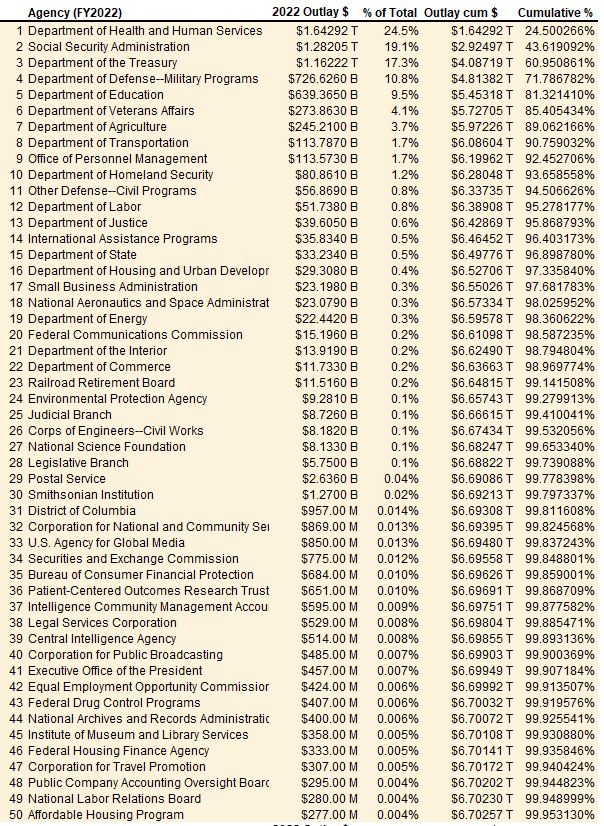
Schematic_A3.2 – FY2022 Federal Budget Outlays by Agency (Part 2/5)
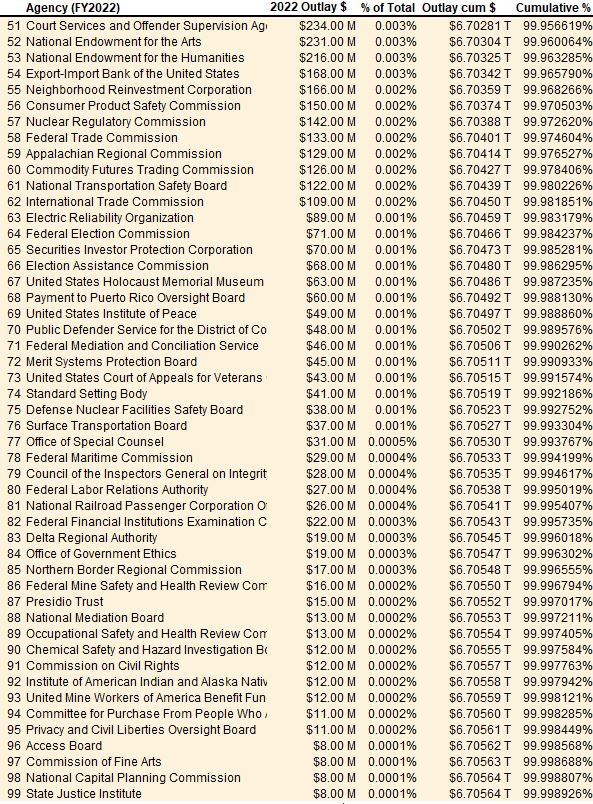
Schematic A3.3 – FY2022 Federal Budget Outlays by Agency (Part 3/5)
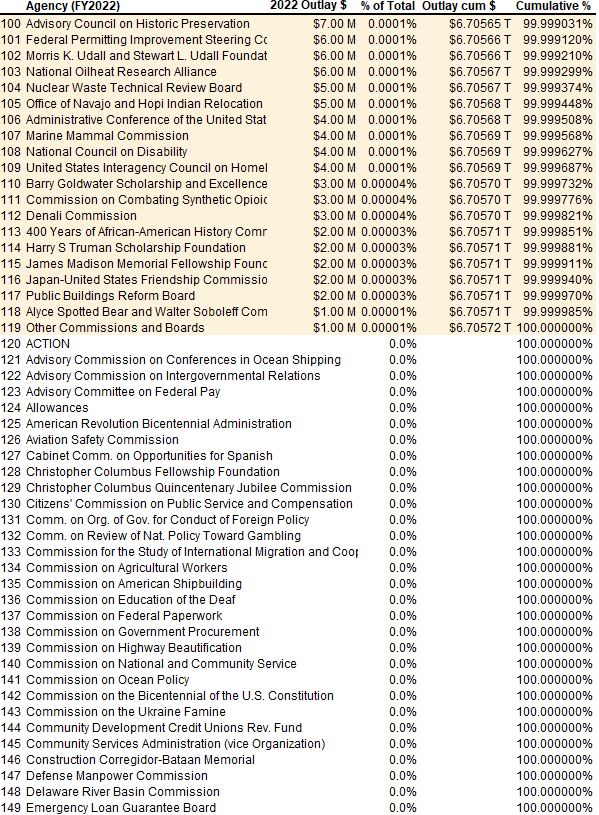
Schematic_A3.4 – FY2022 Federal Budget Outlays by Agency (Part 4/5)
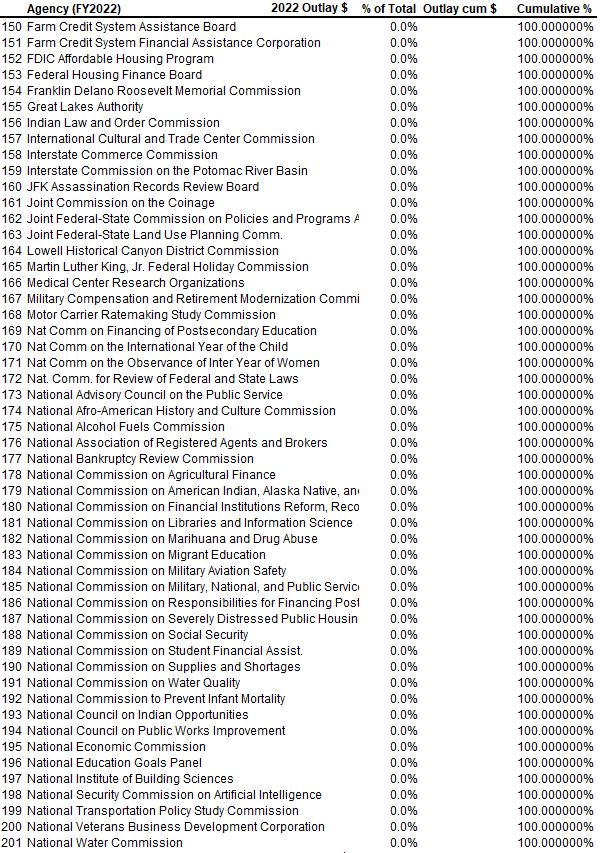
Schematic A3.5 – FY2022 Federal Budget Outlays by Agency (Part 5/5)
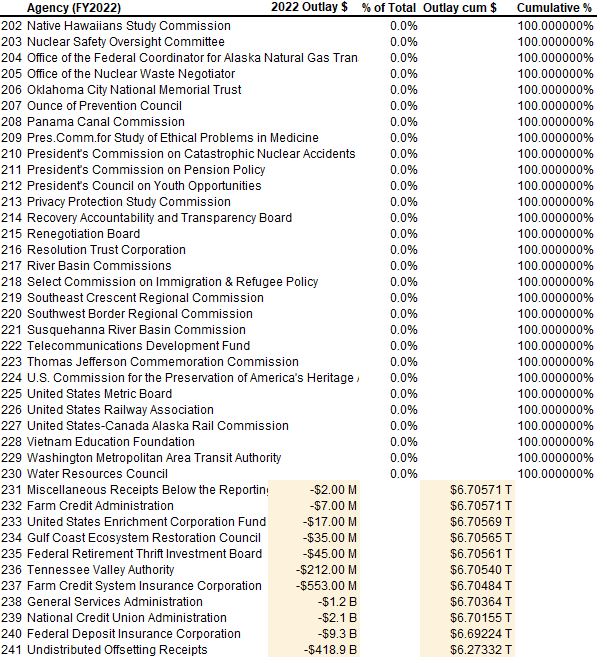
Appendix 4 – Budget Functions
https://www.cbo.gov/data/budget-economic-data (see Spending Projection by Budget Account Section, Open latest files, see 3rd tab for function definitions)
https://www.whitehouse.gov/omb/budget/historical-tables/
There are 6 Budget Super-Function Categories, 20 Budget Function Categories, and 80 Budget Sub-Function categories.
Budget Super-Functions (6)
National Defense
Other functions
Physical resources
Human resources
Net interest
Undistributed offsetting receipts
Budget_Functions (20 ; maybe 21)
The Concurrent Budget Resolution is, typically, the first big deliverable of Congress. Schematic A6.3 below tabulates the years in which it was adopted and years in which it was not passed at all. In the years in which it was not passed, the House , Senate, or sometimes both, produce a more streamlined substitute called a Deeming Resolution. I believe these laws avoid the budget items that contributed to the Resolution not passing and focus on delivering a set of budget allocations to the Appropriations Committees. They are given their name because they are are “deemed to serve in place of an annual Budget Resolution”. See the following references for more information on Deeming Resolutions: CRS – R46240 , CRS – R44296 , crfb.org .
Budget Sub-Functions (80) – Part 1 of 4
051 Department of Defense-Military:
053 Atomic energy defense activities
054 Defense-related activities
151 International development & humanitarian assist.
152 International security assistance
153 Conduct of foreign affairs
154 Foreign information and exchange activities
155 International financial programs
251 General science and basic research
252 Space flight, research, and supporting activities
271 Energy supply
272 Energy conservation
274 Emergency energy preparedness
276 Energy information, policy, and regulation
301 Water resources
302 Conservation and land management
303 Recreational resources
304 Pollution control and abatement
306 Other natural resources
351 Farm income stabilization
352 Agricultural research and services
Budget_Sub-Functions (80) – Part 2 of 4
371 Mortgage credit
372 Postal service
373 Deposit insurance
376 Other advancement of commerce
401 Ground transportation
402 Air transportation
403 Water transportation
407 Other transportation
451 Community development
452 Area and regional development
453 Disaster relief and insurance
501 Elementary, secondary, and vocational education
502 Higher education
503 Research and general education aids
504 Training and employment
505 Other labor services
506 Social services
551 Health care services
552 Health research and training
554 Consumer and occupational health and safety
571 Medicare
Budget Sub-Functions (80) – Part 3 of 4
601 General ret. & disab. Ins. (excl social sec.)
602 Federal employee retirement and disability
603 Unemployment compensation
604 Housing assistance
605 Food and nutrition assistance
609 Other income security
651 Social security
701 Income security for veterans
702 Veterans education, training, and rehabilitation
703 Hospital and medical care for veterans
704 Veterans housing
705 Other veterans benefits and services
751 Federal law enforcement activities
752 Federal litigative and judicial activities
753 Federal correctional activities
754 Criminal justice assistance
801 Legislative functions
802 Executive direction and management
803 Central fiscal operations
804 General property and records management
805 Central personnel management
Budget Sub-Functions (80) – Part 4 of 4
806 General purpose fiscal assistance
808 Other general government
809 Deductions for offsetting receipts
901 Interest on Treasury debt securities (gross)
902 Interest received by on-budget trust funds
903 Interest received by off-budget trust funds
908 Other interest
909 Other investment income
923 Pandemic Fraud Prevention and Enforcement
924 Allowance for Discretionary Programs (Non-Defense)
926 Spectrum relocation
927 Adjustment for historical outlay estimation bias
951 Employer share, employee retirement (on-budget)
952 Employer share, employee retirement (off-budget)
953 Rents and royalties on the Outer Continental Shelf
954 Sale of major assets
959 Other undistributed offsetting receipts
Appendix 5 – House and Senate Voting Rules
For most legislation a simple majority is required to decide a vote i.e.
- In the Senate this means, 51/100 votes are needed (or 50/50 with Vice Presidential tie breaker).
- In the House, this means 218/435 votes are needed.
House Voting Rules Involving Super Majority
A super majority basically means a better than 50/50 vote is required for the vote to pass. Here are some of the Super Majority vote requirements in the House:
- 2/3 vote to suspend House Rules
- 3/5 vote for legislation that raises taxes
Senate Voting Rules Involving Super Majority
A super majority basically means a better than 50/50 vote is required for the vote to pass. Here are some of the Super Majority vote requirements in the Senate:
- 3/5 vote (60/100) required for invoking Cloture (to shut down Filibusters i.e. debates and speeches with no time limits
- 2/3 vote to ratify treaty or propose Constitutional Amendment.
- 3/5 (60%) vote for waiving Points of Order (rule violations, basically…..what?)
- 2/3 (67%) vote to change or suspend Senate Rules. (what?)
- 3/5 vote waive removal of “air dropped” provisions in conference reports, public disclosure of earmarks, PAYGO offset requirements (what? to all of these)
Constitutionally Driven Voting Rules
- Impeachment: Simple majority for House to impeach and 2/3 vote for Senate to convict.
- Presidential Veto Overrides: 2/3 to override in both House and Senate
- Expulsion/Disciplining of Members: 2/3 vote in both House and Senate
Special Voting Rules for Budgetary Legislation
There are some additional limits that apply to passing Reconciliation Bills like the Byrd Rule which “prohibits including extraneous provisions in the measure or offering them as amendments” and rules requiring that amendments must be germane to the bill. There are also spending increase limits applied to any added amendments but these can be waived in the Senate by a vote of three fifths of all Senators!
Budget Reconciliation Bills passed since 2001
Major laws impacting taxes and spending have been passed as Reconciliation Bills, sidestepping the Filibuster and the 3/5 vote needed to overcome it (meaning a simple majority vote is needed for Senate approval ) (CRS R40480 and pgpf.org):
- FY2002; H.Con.Res. 83; Economic Growth and Tax Relief Reconciliation Act of 2001 (Cost = -$1.349 Trillion)
- FY2004; H.Con.Res. 95; Jobs and Growth Tax Relief Reconciliation Act of 2003 (Cost = -$349.7 Billion)
- FY2006; H.Con.Res. 95; Deficit Reduction Act of 2005 (Savings = $38.8 Billion)
- FY2006; H.Con.Res. 95; Tax Increase Prevention and Reconciliation Act of 2005 (Cost = -$69.96 Billion)
- FY2008; S.Con.Res. 21; College Cost Reduction and Access Act of 2007 (Savings = $752.00 Million)
- FY2010; S.Con.Res. 13; Health Care and Education Reconciliation Act of 2010 (Savings = $109.0 Billion)
- FY2018; H.Con.Res. 71; Tax Cuts and Job Act of 2018 (Cost = -$1.460 Trillion)
- FY2021; S.Con.Res. 5; American Rescue Plan Act of 2021 (Cost = -$1.856 Trillion)
Vote-a-rama (Vote-arama, Vote-athon)
The Senate defines a Vote-a-rama as “Legislation the Senate voted on 15 or more times in one day.” As of Nov 10, 2023, there have been 62 vote-a-ramas since 1977, ranging from 15 to 44 votes. This is simply a custom adopted by the Senate; it is not a procedure driven by any Act or Law.
Vote-a-ramas pertain to Senate amendment and voting procedures, apparently coined by Trent Lott or his staffers, that are usually applied to Budget Resolutions or Budget Reconciliation Bills but can be done on any legislation. So, out of 62 total Vote-a-ramas (as of Nov 2023), 30.6% were applied to Budget Reconciliations, 38.7% to Budget Resolutions, and 30.6% to other Bills.
Vote-a-ramas allow any Senator to propose an unlimited number of amendments to a Reconciliation Bill or a Budget Resolution (or any other bill). Debate and voting times (minutes!) are accelerated during the process. They are often exercised by minority Senate members with the purpose of politicizing the Reconciliation Bill or Budget Resolution approval processes. (where minority voters don’t have recourse to Filibusters and where a simple majority vote is all that is needed.)
You can refer to CRS – R46240 for more information on this topic.
Appendix 6 – Federal Budget Process Performance
The Federal Budget Process produces several resolutions and bills. This appendix shows their historical performance in terms of timeliness, whether passed or not, etc.
If you want to dig into the source data yourself, you can use the following reports and web sites:
- CRS R43163 – The President’s Budget: Overview of Structure and Timing of Submission to Congress
- CRS R44296 – Deeming Resolutions: Budget Enforcement in the Absence of a Budget Resolution
- CRS R46595 – Continuing Resolutions: Overview of Components and Practices
- CRS RS20348 – Federal Funding Gaps: A Brief Overview (11/7/2023)
- CRS R40480 – Budget Reconciliation Measures Enacted into Law Since 1980
- CRS Database – Status of Federal Budget Enactment Phase Bills and Resolutions
Schematic A6.1 – Federal Budget Process Legislative Products

Presidential Budget Request Submittal Timeliness
In Schematic A6.2 below you can see how often the PBR was submitted on time. Remember that submitting this to Congress kicks off an arduous enactment process that needs time and effort.
The blue bars indicate fiscal years in which the PBR was submitted on time (or sometimes before the deadline) and the red bars indicate the years in which the PBR was submitted after the deadline. Do you notice how the red lines get more frequent in recent times?
- In the last 102 fiscal years, the PBR was submitted late 25.5% of the time by an average of 33 days.
- In the last 31 fiscal years, the PBR was submitted late 54.8% of the time (bad)!
- In the last 15 fiscal years, the PBR was submitted late 86.7% of the time (really bad)!
Looks like recent performance as been really bad.
Schematic A6.2 – Presidential Budget Request Timeliness (FY1923 – 2023) 
Concurrent Budget Resolution Submittal Timeliness
The Concurrent Budget Resolution is, typically, the first big deliverable of Congress. Schematic A6.3 below tabulates the years in which it was adopted and years in which it was not passed at all. In the years in which it was not passed, the House , Senate, or sometimes both, produce a more streamlined substitute called a Deeming Resolution. I believe these laws avoid the budget items that contributed to the Resolution not passing and focus on delivering a set of budget allocations to the Appropriations Committees. They are given their name because they are are “deemed to serve in place of an annual Budget Resolution”. See the following references for more information on Deeming Resolutions: CRS – R46240 , CRS – R44296 , crfb.org .
- In the last 48 years the Concurrent Budget Resolution has failed to pass 12 times (that’s a 25% failure rate).
- In the last 20 years it has failed to pass 10 times (that’s a 50% failure rate) !
Well, that’s depressing. So in the last 20 years 1 out of every 2 Budget Resolutions have failed to pass (and have been substituted by much simpler and less controversial Deeming Resolutions).
Schematic A6.3 – Budget Resolution Enactments (FY1976-2023)
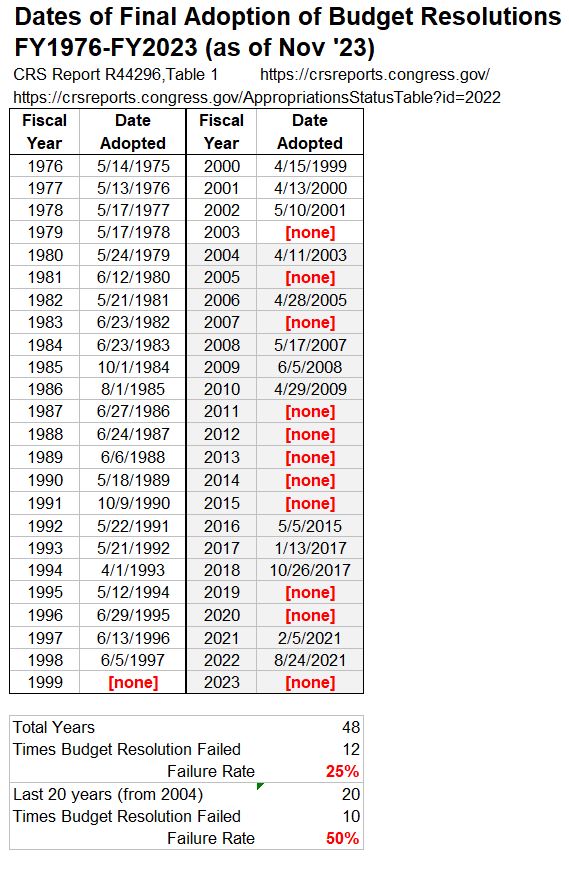
Appropriation Bill Submittal Timeliness
Are you seeing a trend developing here? Looks like Presidential Budget Requests are often late and that in recent times there is a 50/50 chance that Concurrent Budget Resolutions won’t pass. How about Appropriation Bill submittals? Are they submitted on time?
Check out Schematic A6.4 below. Since 1977,
- All 12 Appropriations Bills were passed on time only 4 times (out of 38; that’s 8.3% of the time).
- In 20 out of 38 years (41.7% of the time), NO Appropriations Bills passed on time.
- Notice all those 0% in the Chart in recent years.
So , in general , especially recently, Appropriations Bills are not being submitted on time..
Schematic A6.4 – Appropriation Bill Timeliness (FY1977 – 2024)
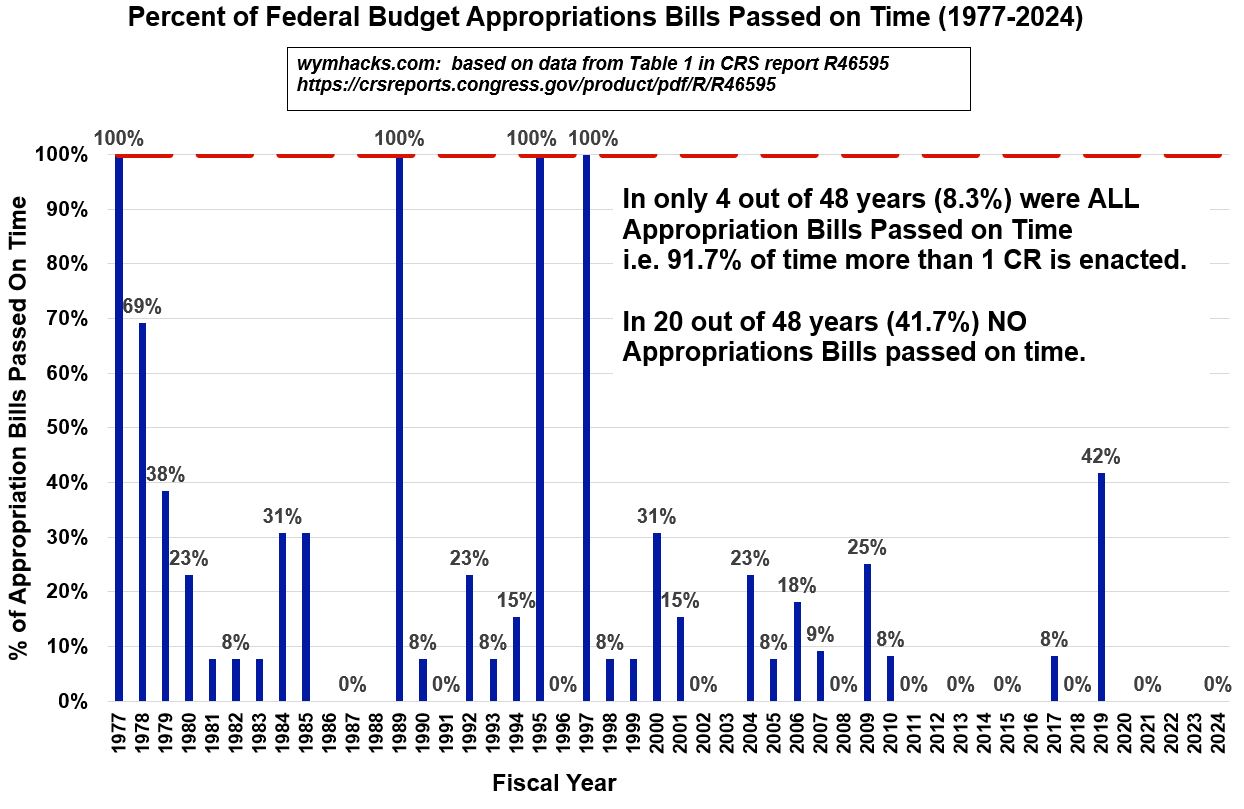
Continuing Resolutions Enactments
A Continuing Resolution (CR) is a temporary funding measure that Congress uses when Appropriation Bills are not passed or are delayed beyond the start of the Fiscal Year. Continuing Resolutions operate at the same level of funding as the previous year.
Consider Schematic A6.5 below:
- 199 Continuing Resolutions have been passed since 1977 (48 year period)
- 132 (66.3% of total) have been enacted since 1998 (last 28 years)
- There have only been 4 years where no Continuing Resolutions were passed!
So, since they started doing Continuing Resolutions 48 years ago, there have ONLY BEEN 4 Years where the full set of 12 Appropriations Bills were passed!
Schematic A6.5 – Continuing Resolution Enactments (FY1977 – 2024)
Schematic A6.6 shows the total duration of enacted Continuing Resolutions since 1998.
- The average Continuing Resolution duration was 139 days with a median (middle value) of 102 days.
Schematic A6.6 – Continuing Resolutions Durations (FY1998 – 2022)
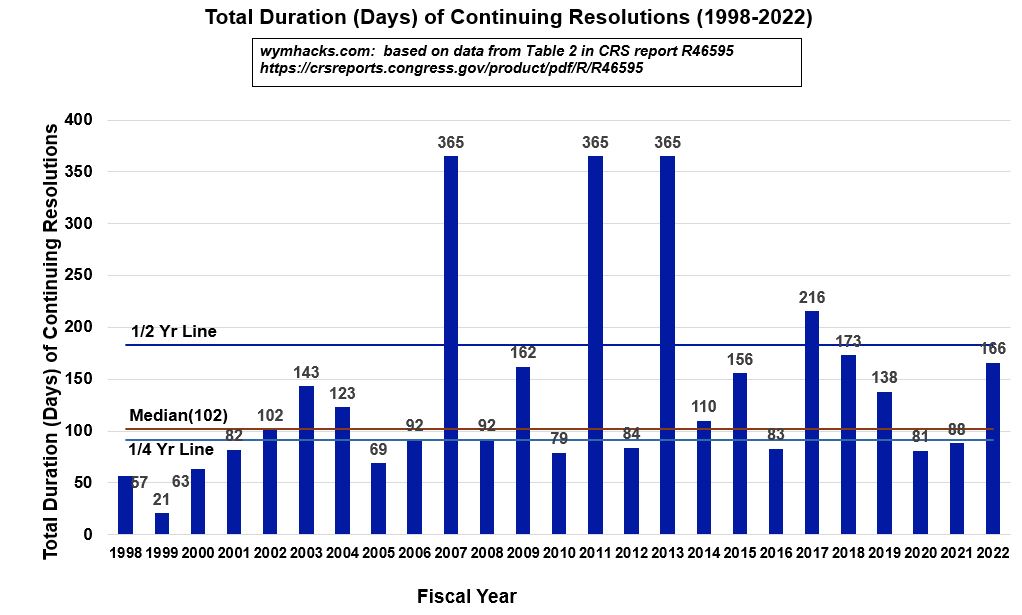
Government Agency Funding Gaps and Shutdowns
The Antideficiency Act, with exceptions, prohibits the “obligation of funds in the absence of appropriations.” If Appropriations (or Continuing Resolutions) are not active by the beginning of the fiscal year (October 1), then the period/s during the fiscal year in which this holds true is/are called Funding Gaps. A Funding Gap generally requires the shutdown of programs under the Appropriation Bill or Bills that were not funded. Government shutdowns are disruptive and further reduce the efficiency of operations (i.e. people get furloughed and don’t do any work, but they all get paid back for this “non work” in the future).
But, Funding Gaps don’t always (and haven’t always) result in affected Government agency shutdowns.
- Short duration Funding Gaps have often avoided shutdowns
- Enforcement via the Antideficiency Act only occurred after the issuance of Attorney General B. Civiletti in 1980 and 1981.
Check out Schematic A6.7. which shows Appropriations Funding Gaps since 1977.
- Since FY1977 there have been 20 Funding Gaps (1 to 34 day durations)
- About 1/2 of the Funding Gaps were less than 3 days in duration
- Many did not result in shutdowns as explained above
- Disruptive Government shutdowns occurred in 1996 (26 days), 2014(16 days), 2018(2 days), and 2019(34 days)
Schematic A6.7 – Appropriations Funding Gaps Since FY1977 (Through Dec 5, 2023)
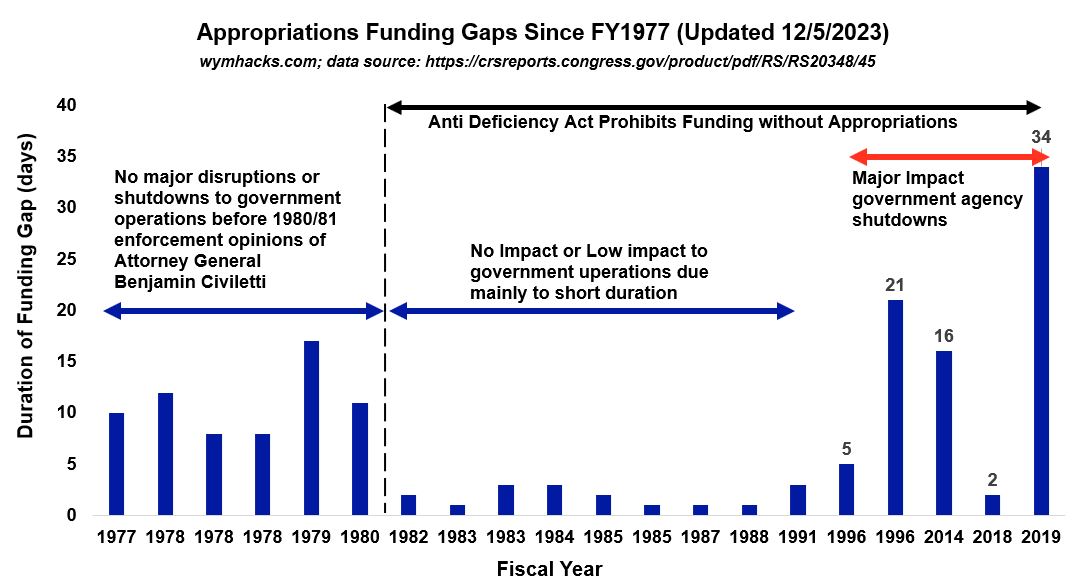
Budget Reconciliation Laws
Budget Reconciliation Bills are created under expedited Senate procedures (simple majority vote, no filibuster allowed) in order to change existing revenue or direct spending laws. The process of creating them must begin with Budget Resolution language that instructs the responsible committee/s to create the necessary authorizing legislation. Major tax and spending laws have been passed as Reconciliation Bills.
Schematic A6.8 shows a complete listing of Reconciliation Bills since 1981. In the table below, if you look at Fiscal Year 2002 and later, you will see additional data listed (Cost/Savings, Party in Control, and Years Covered).
23 Reconciliation Bills have been passed. Due to the easier voting hurdles in the Senate (No Filibuster allowed and therefore simple majority vote in play), it’s not a surprise that both parties have used Reconciliation Bills to pass laws that might not have otherwise been passed. (although I’m guessing that the Rescue Plan Act probably would have passed regardless)
- Republican tax cuts in FY 2002 and 2004 (deficit increased by 1.7 Trillion)
- Republican tax cuts (deficit increased by $1.46 Trillion
- Democrat Rescue Plan Act (deficit increased by $1.86 Trillion)
Schematic A6.8 – Budget Reconciliation Laws (FY1981 – 2022)
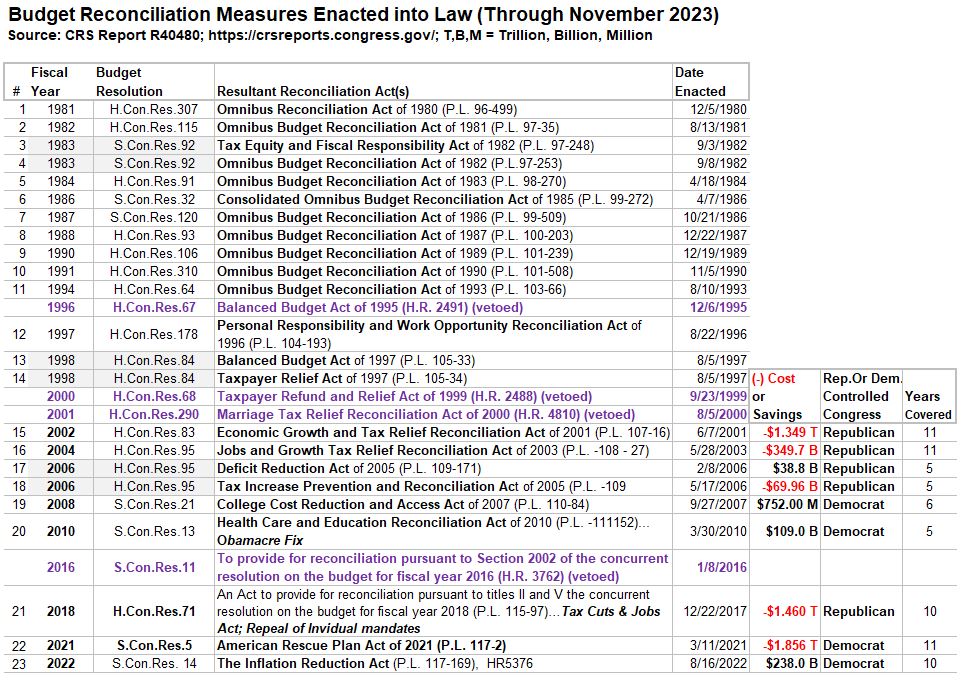
Summary
Schematic A6.9 summarizes the performance of the various Bills and Resolutions that are supposed to be passed during the annual Federal Budget Process. I think we can agree that the performance is less than average overall with
- Concurring Budget Resolutions failing to be passed half the time in recent years.
- all 12 Appropriations Bills (since 1977) being passed on time only four times.
Schematic A6.9 – Some Statistics on Federal Budget Bills and Resolutions

Disclaimer: The content of this article is intended for general informational and recreational purposes only and is not a substitute for professional “advice”. We are not responsible for your decisions and actions. Refer to our Disclaimer Page.
